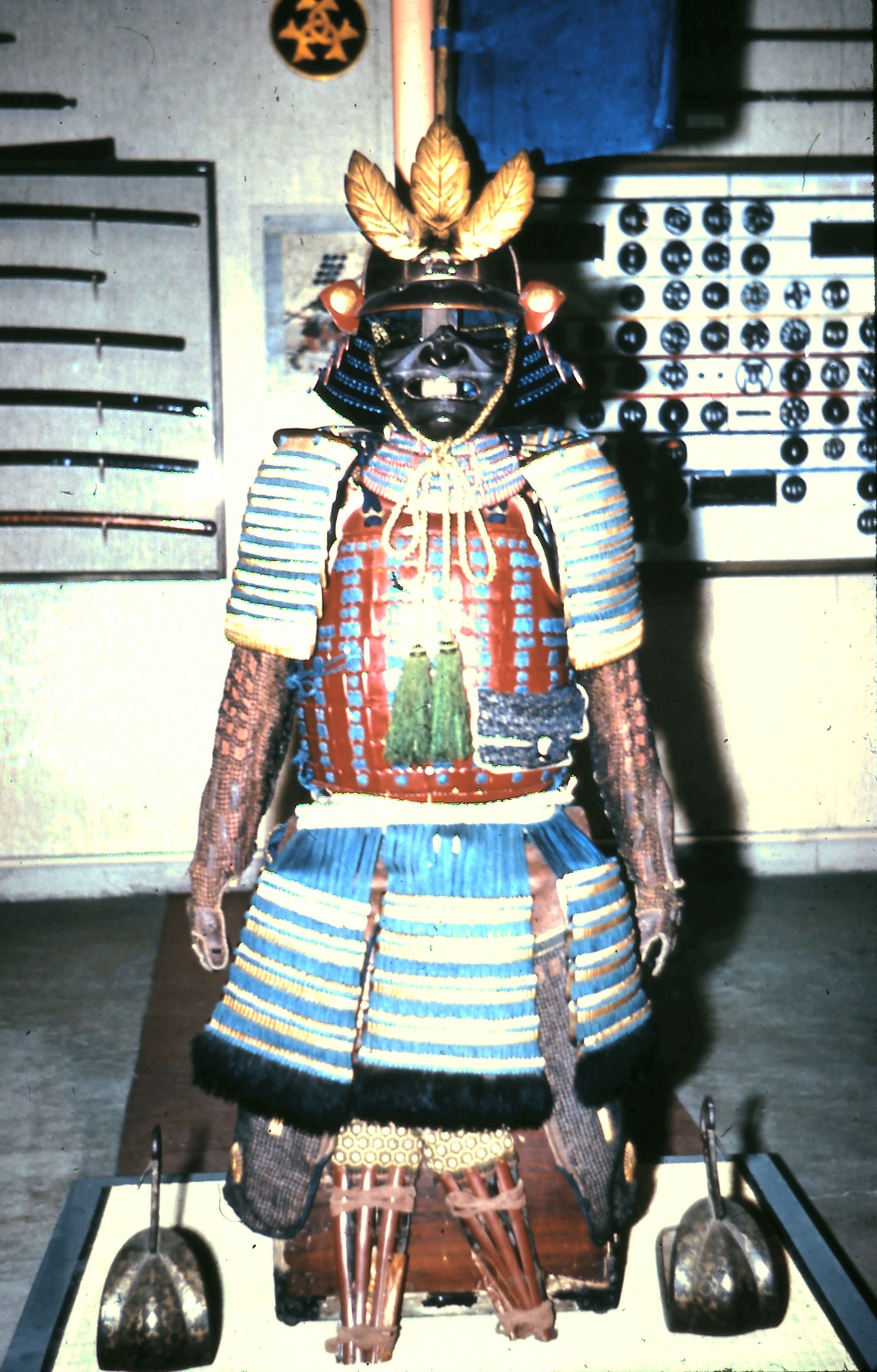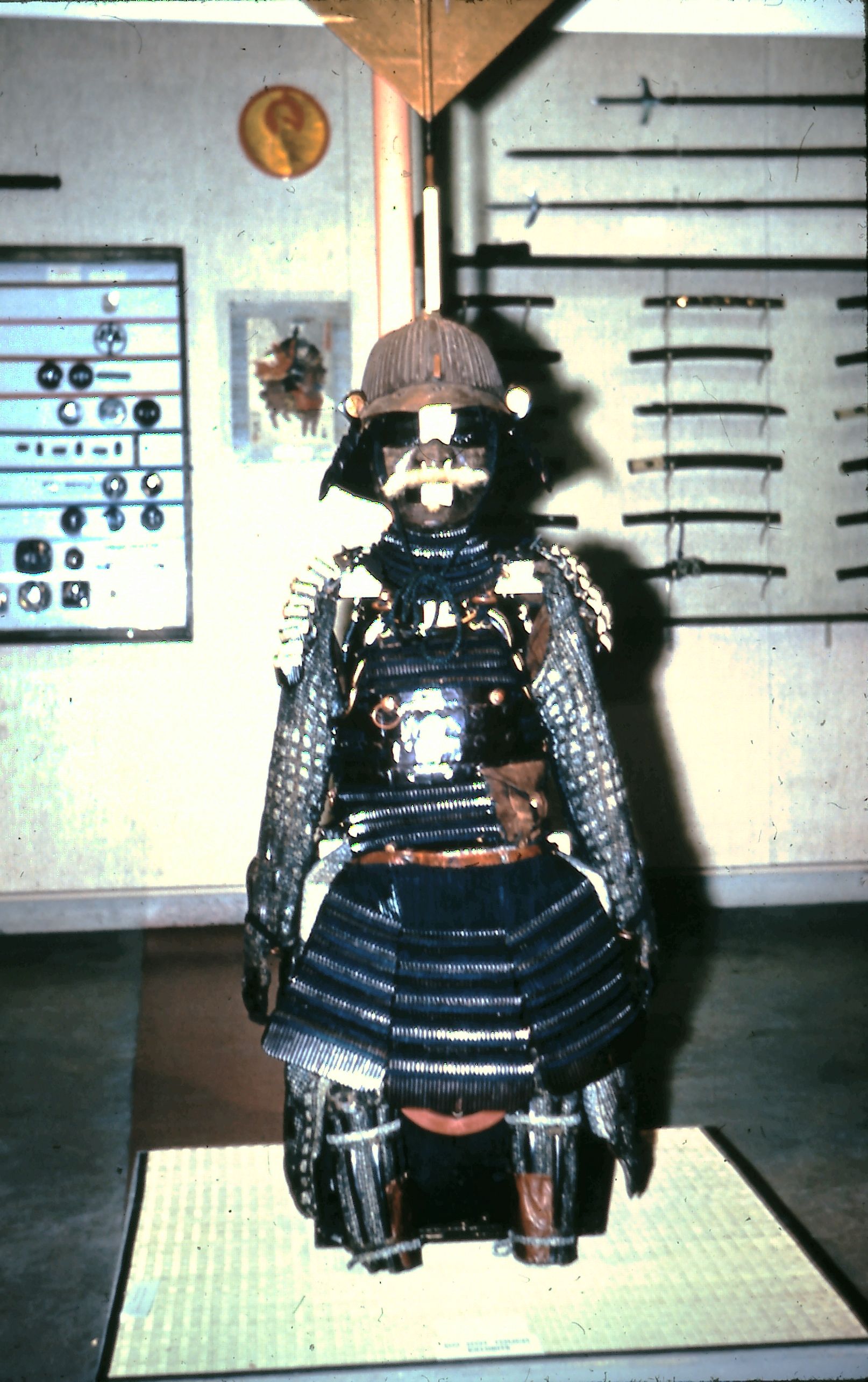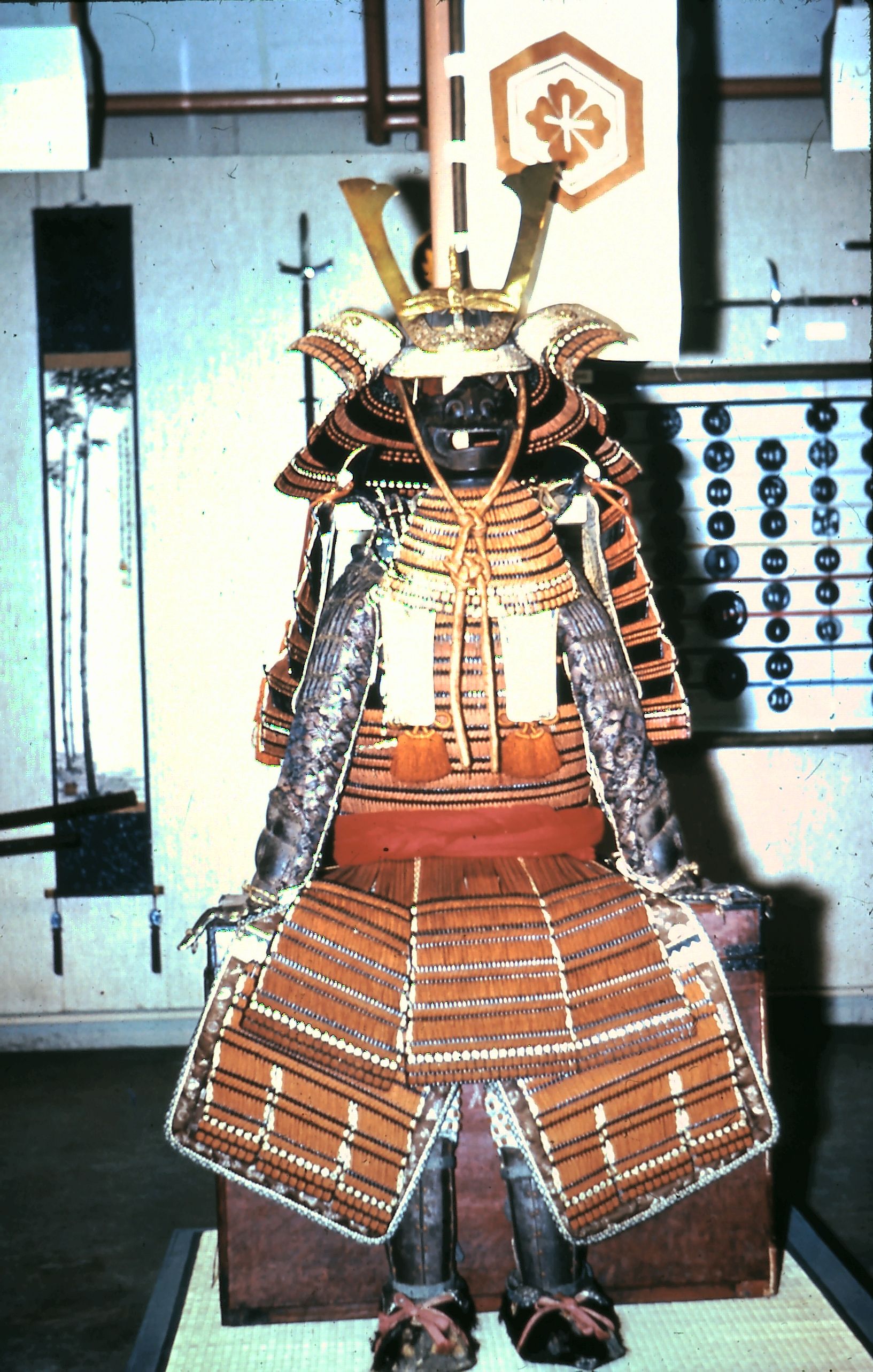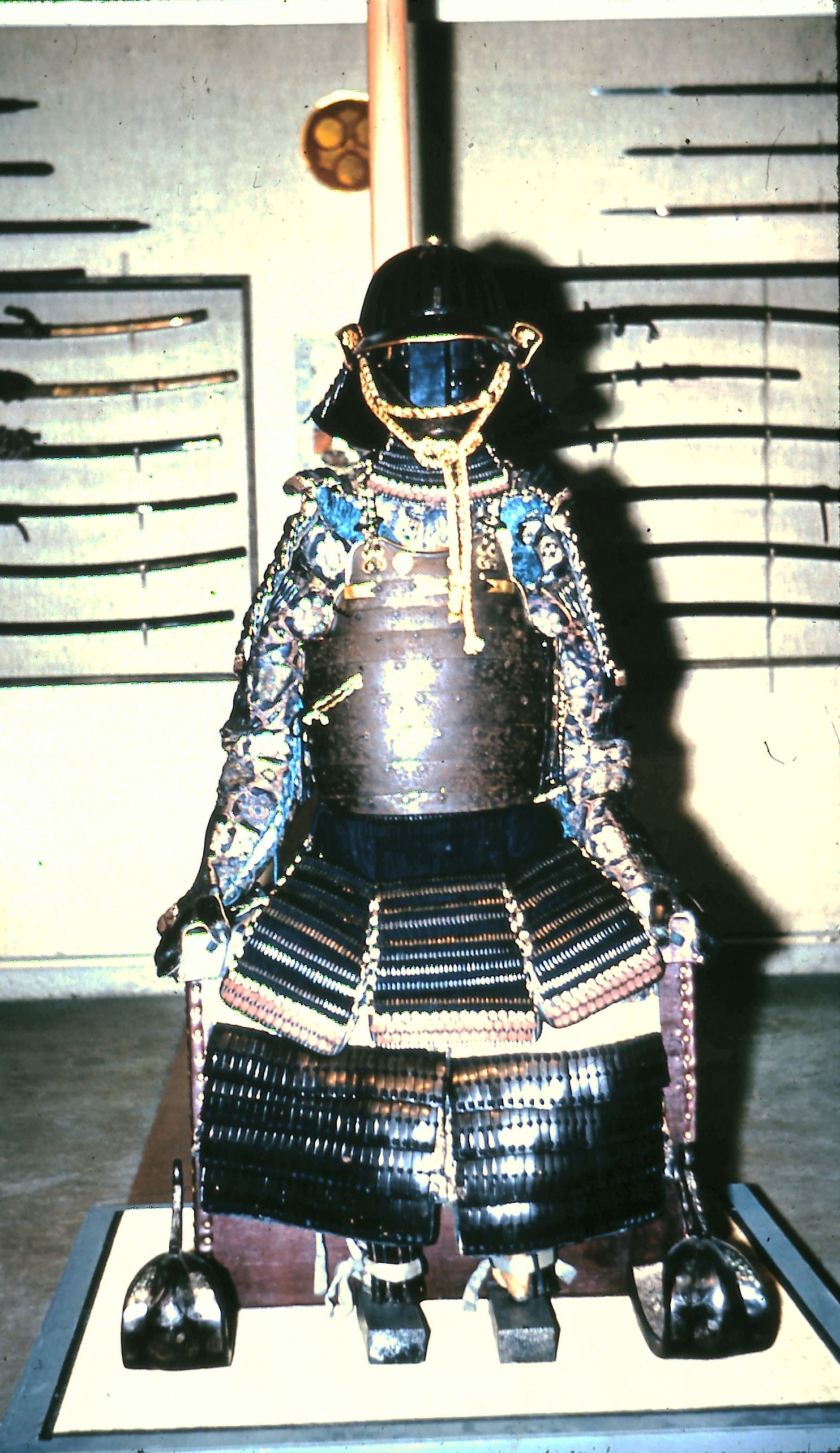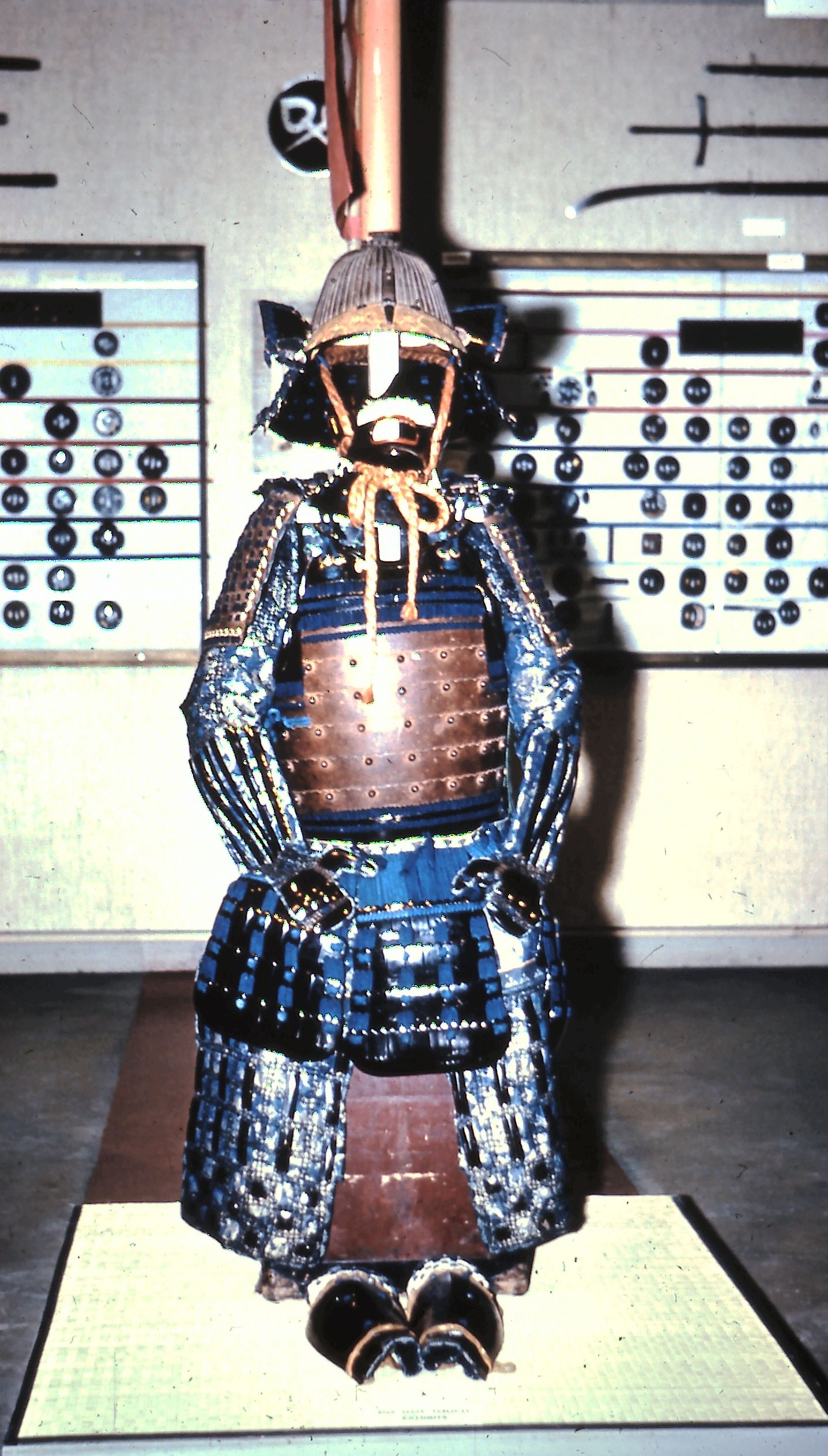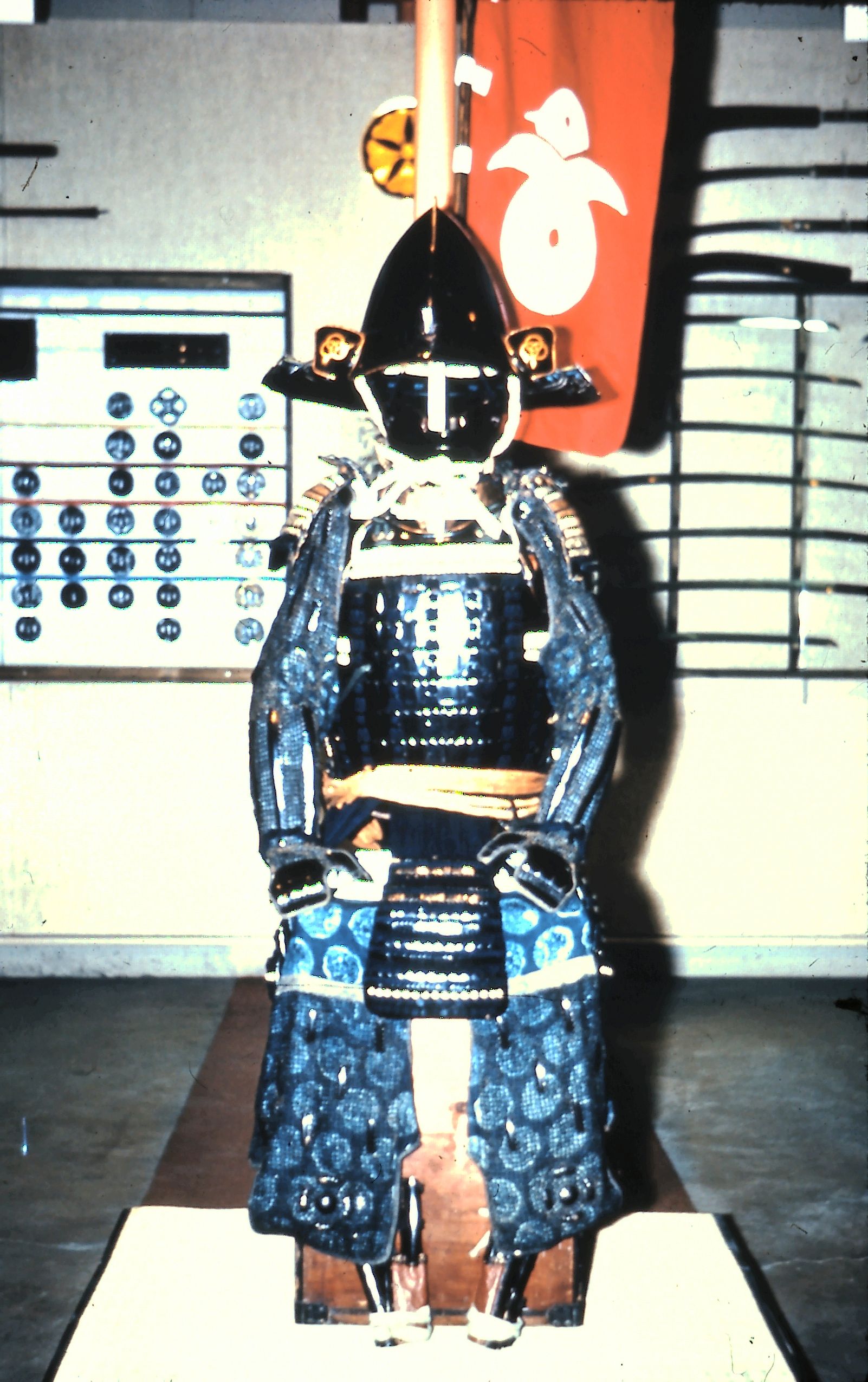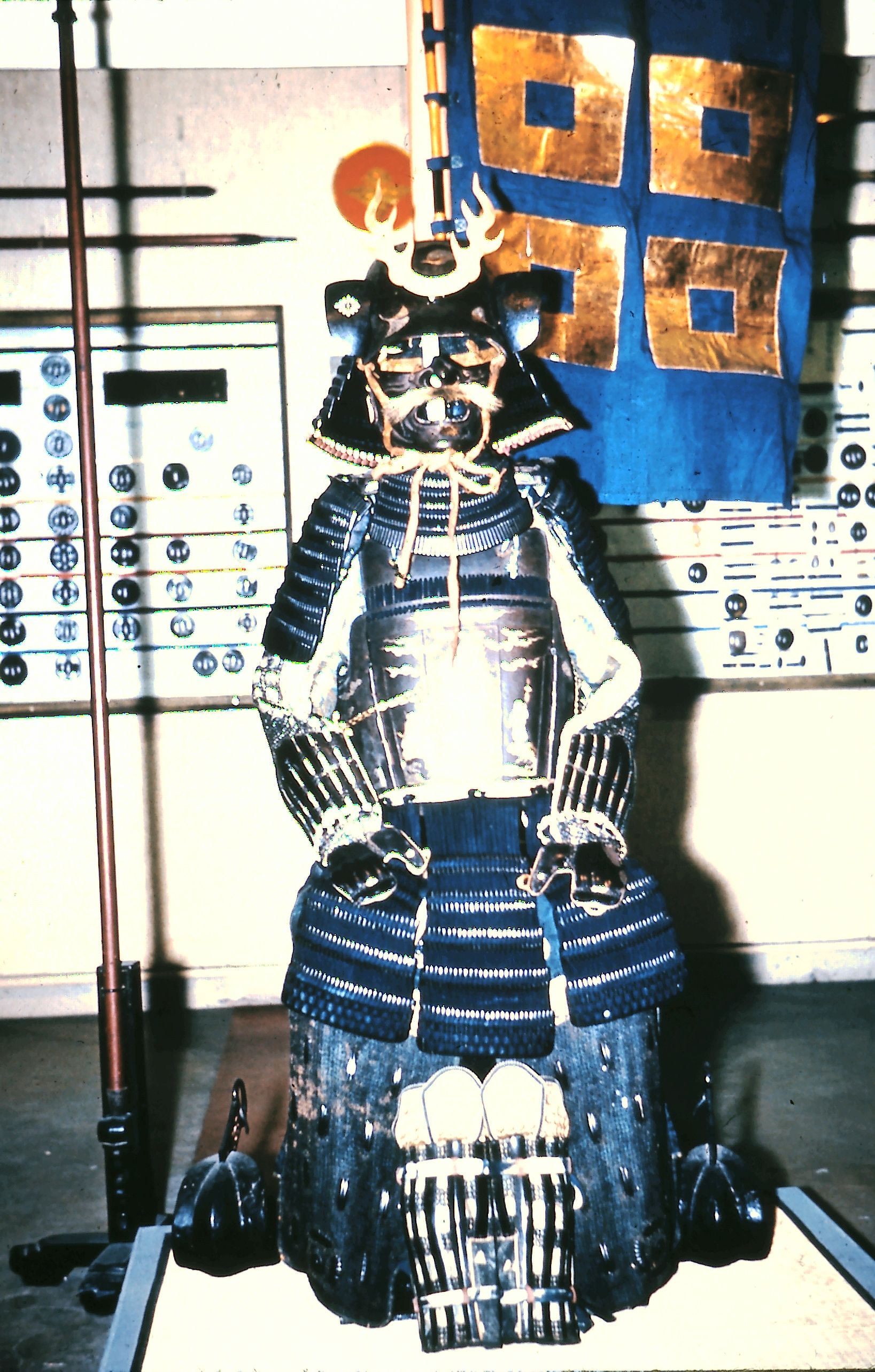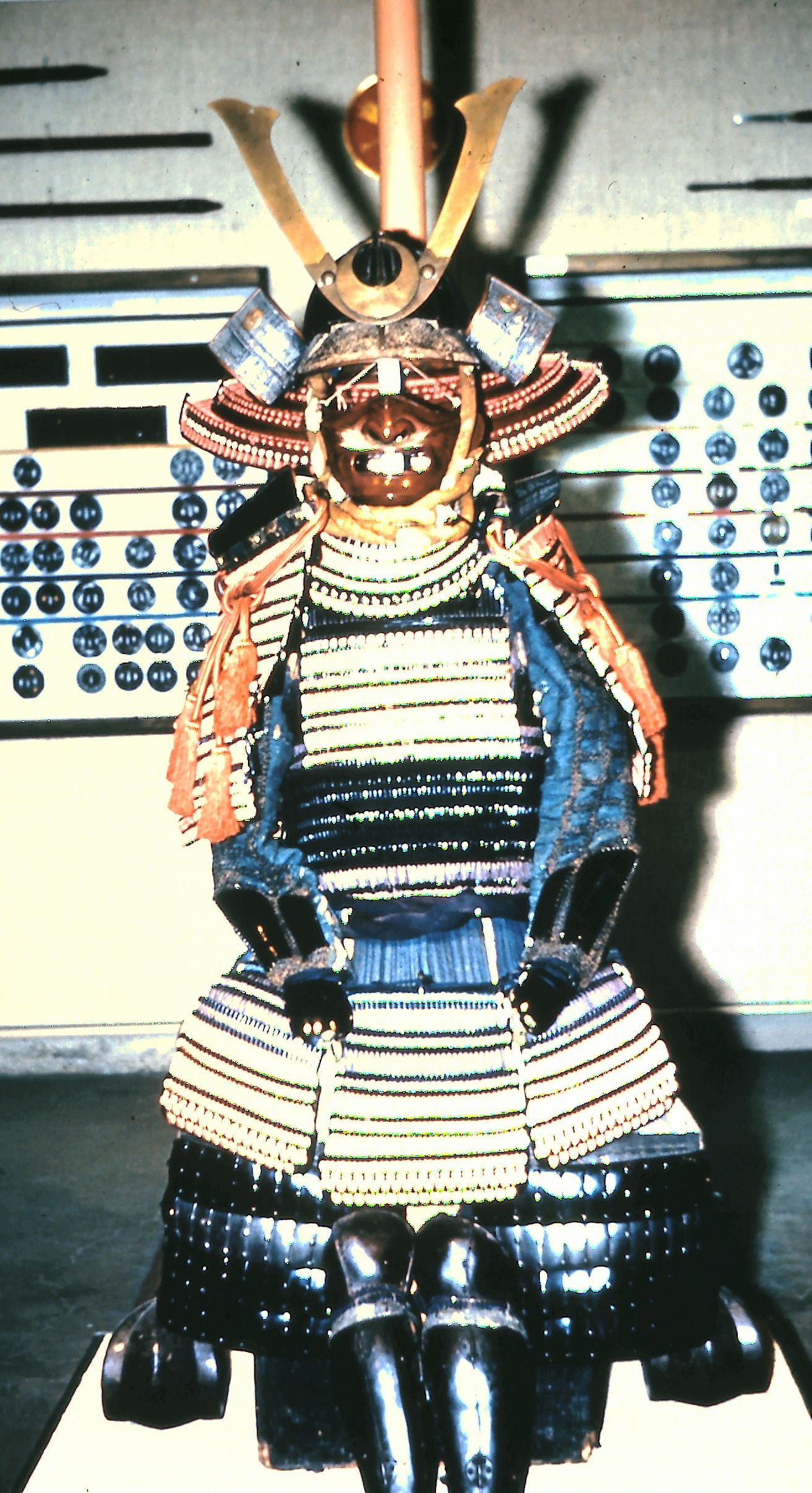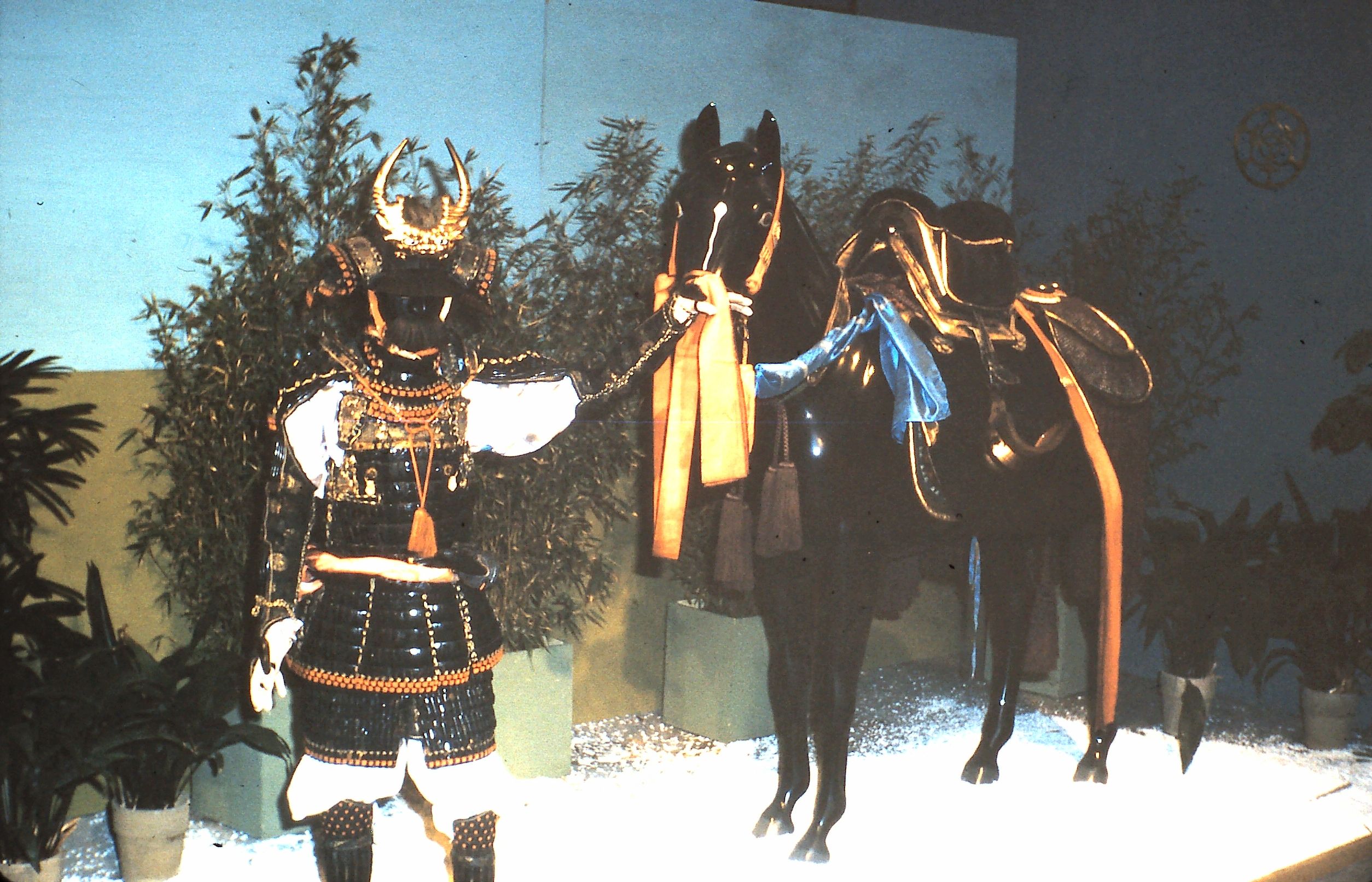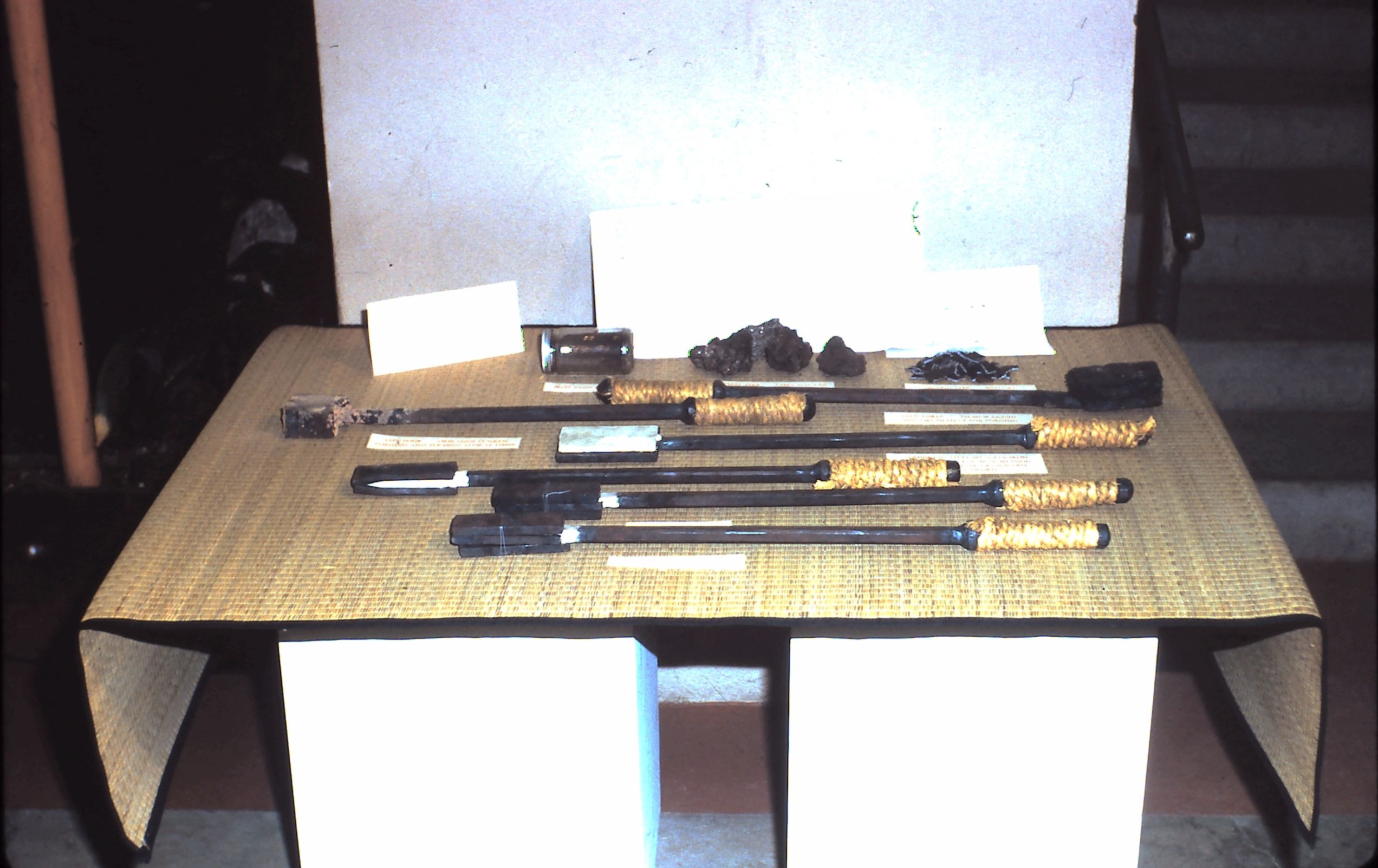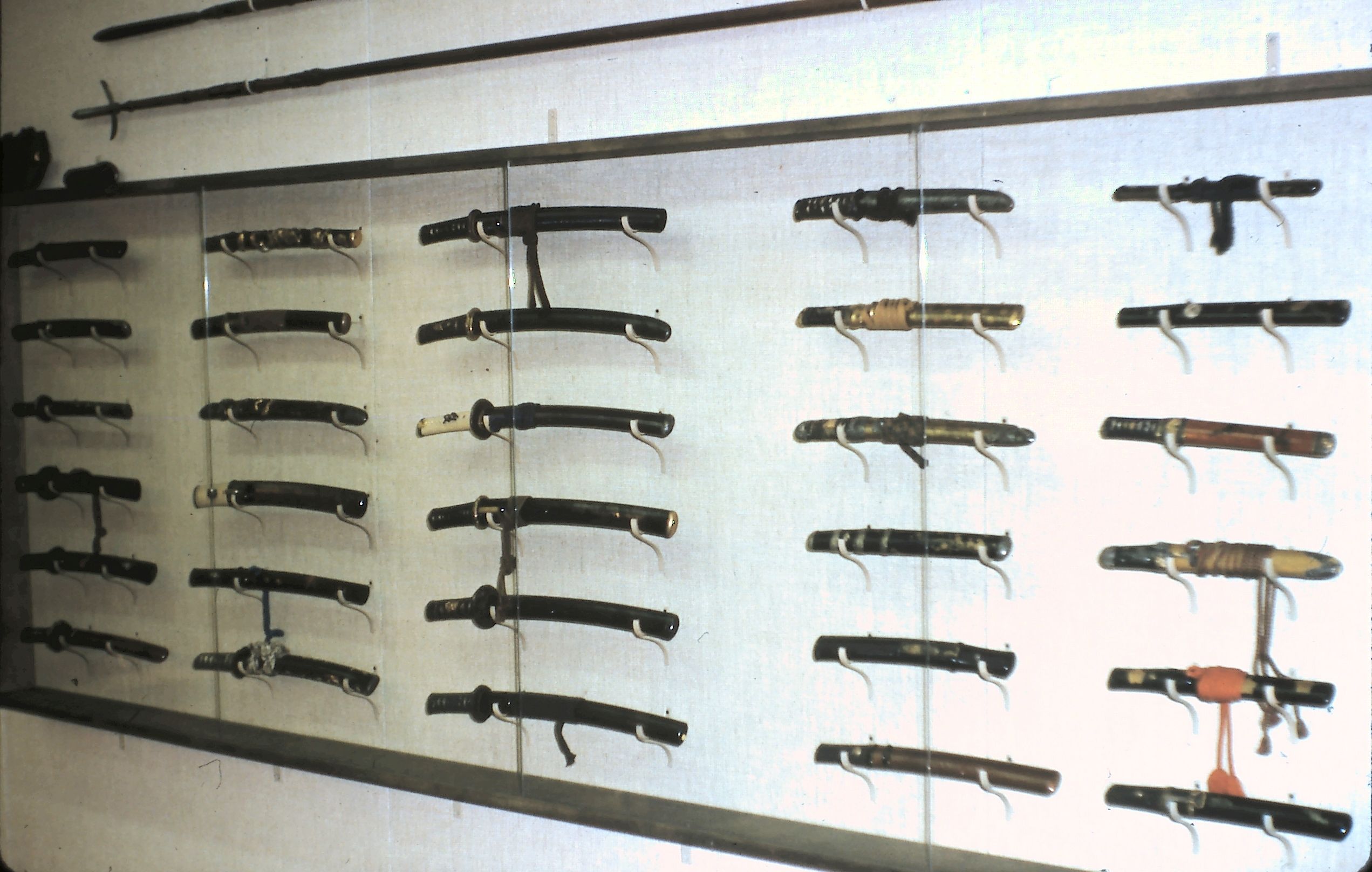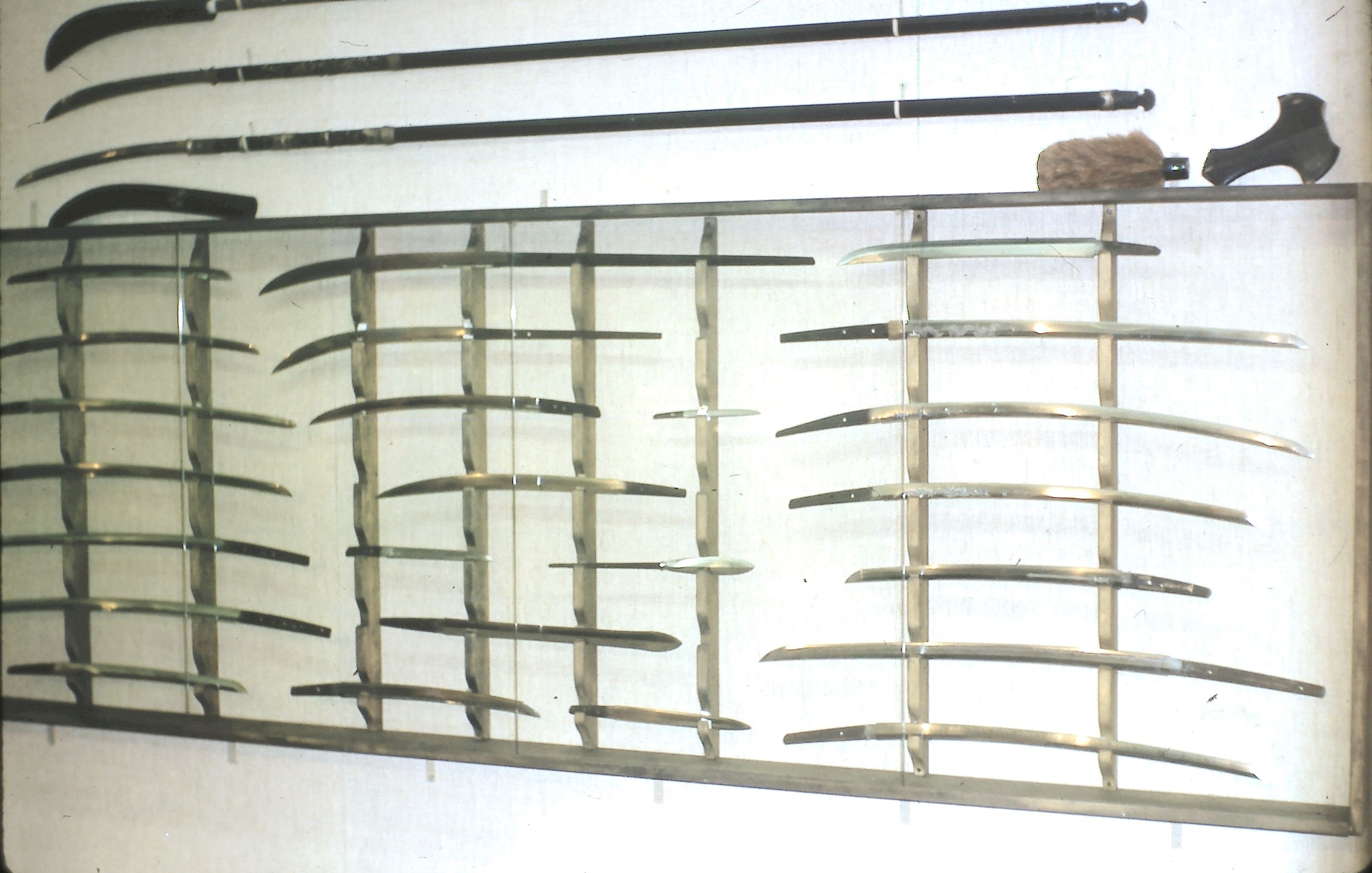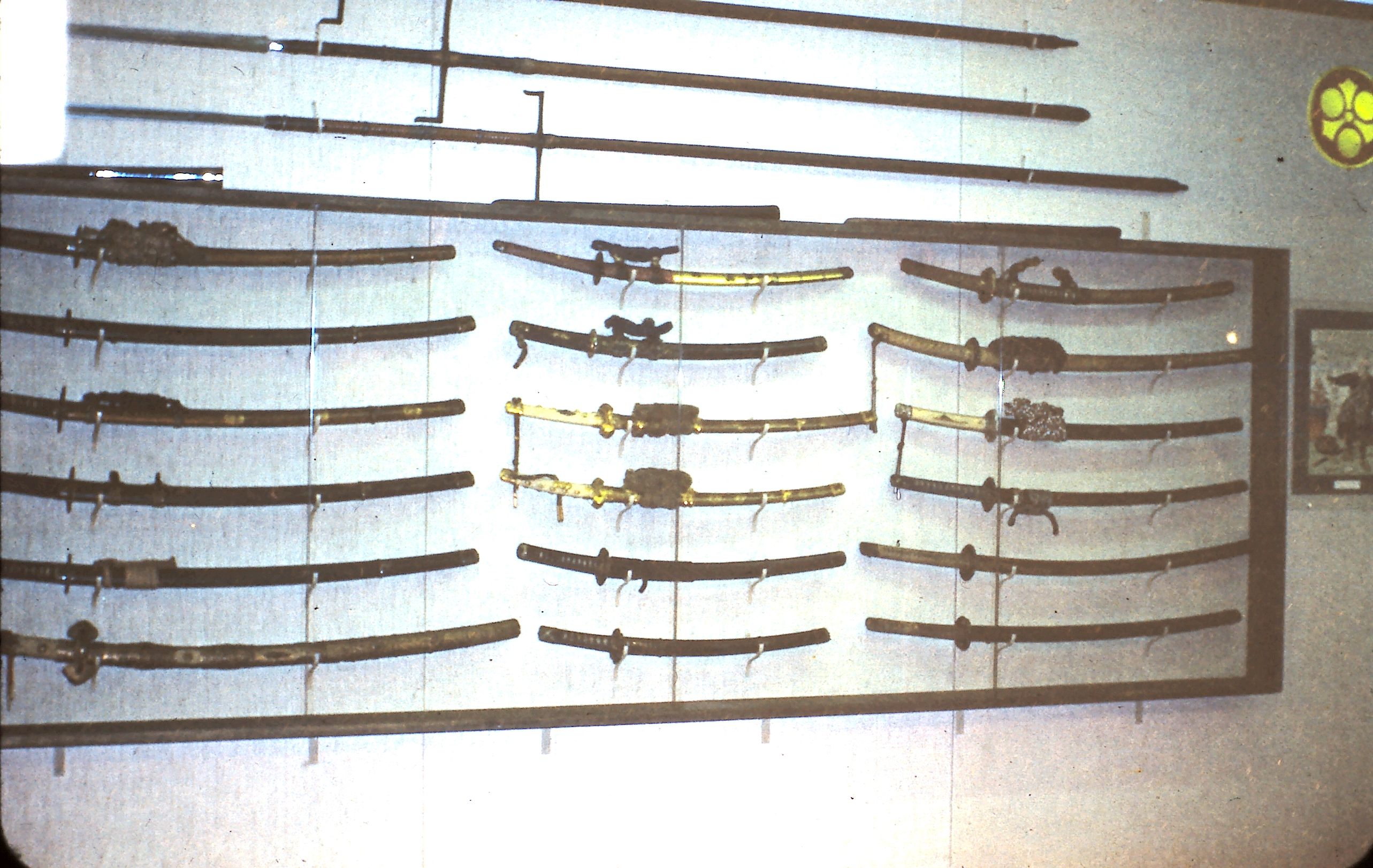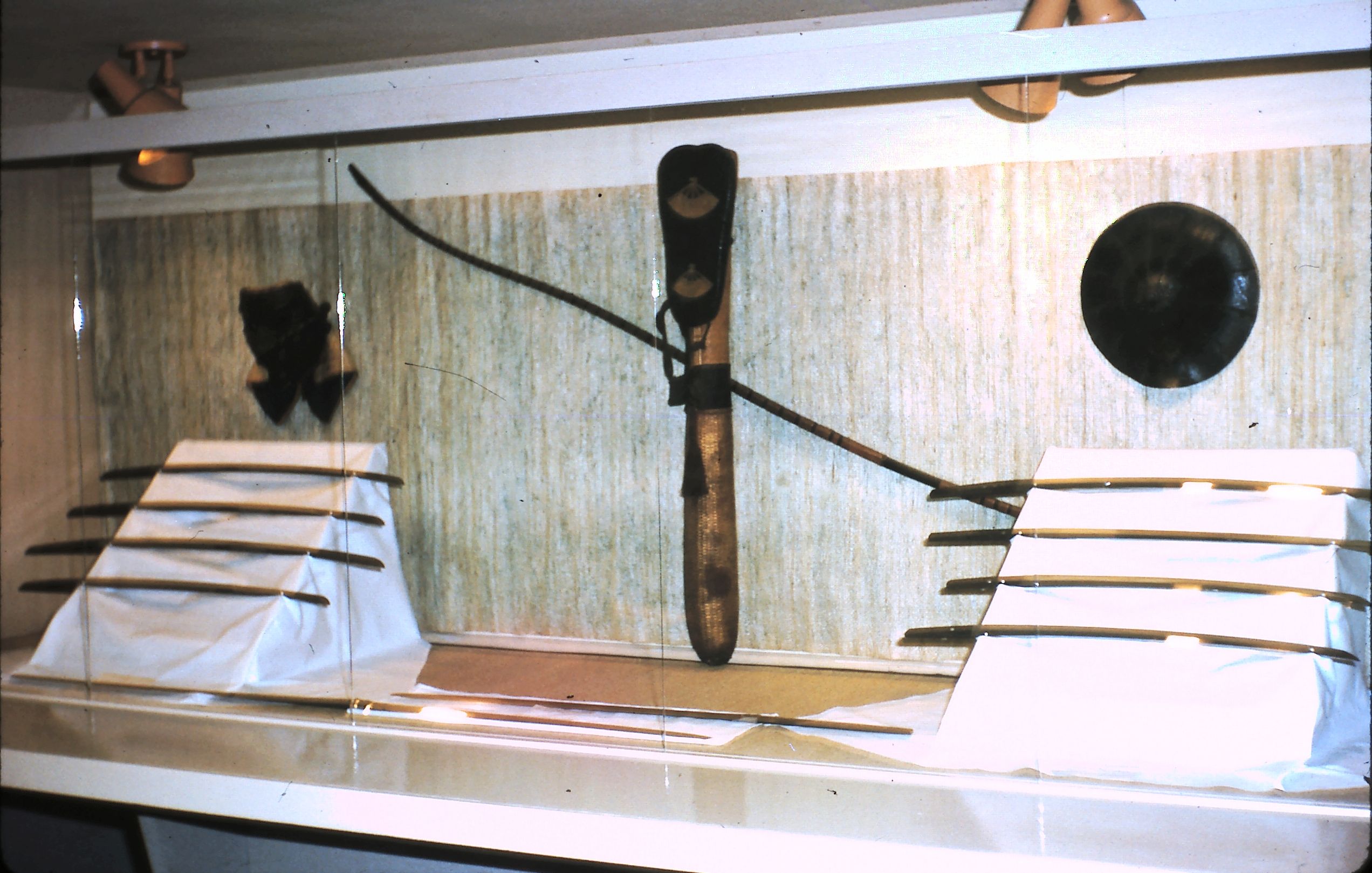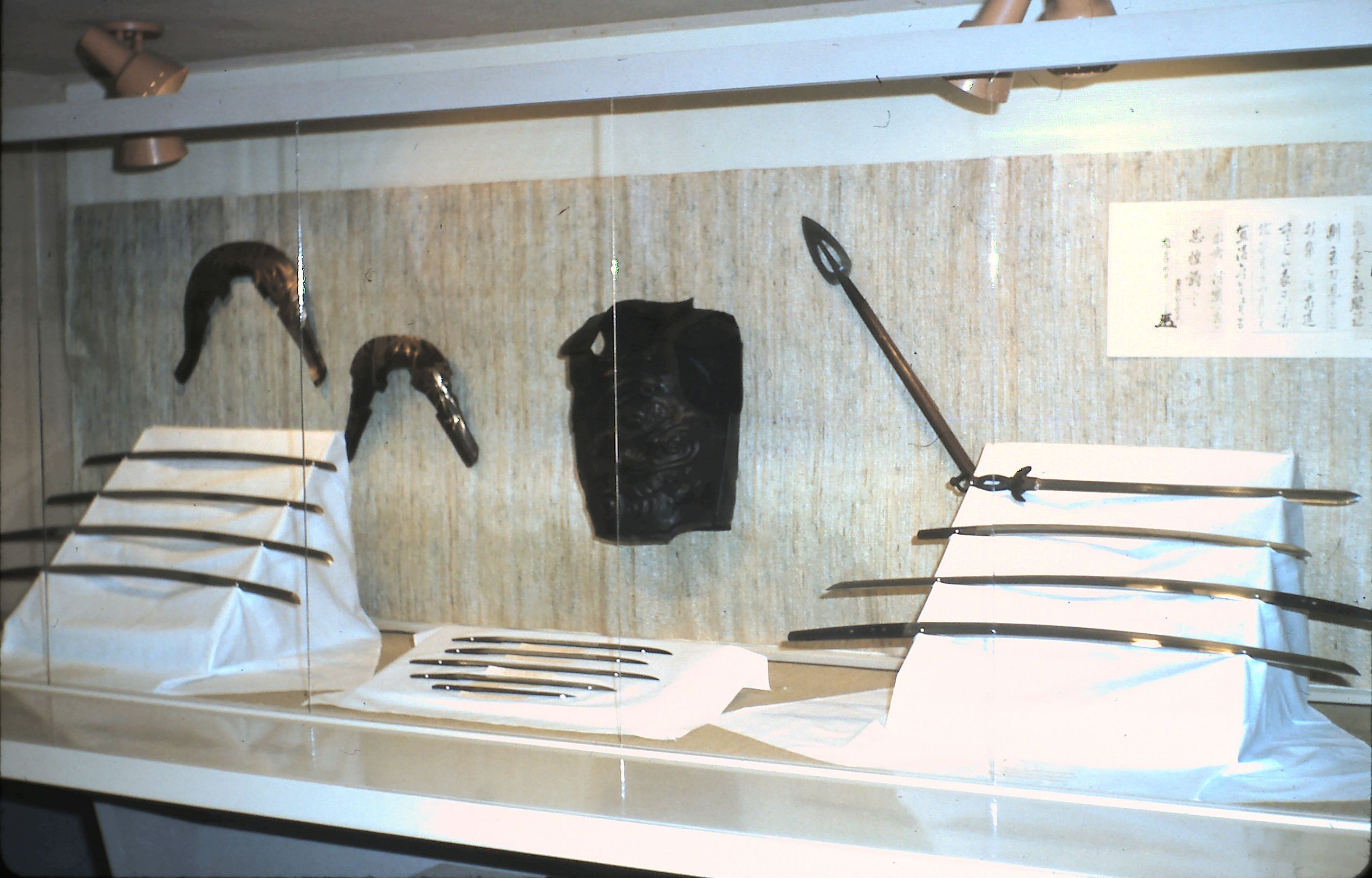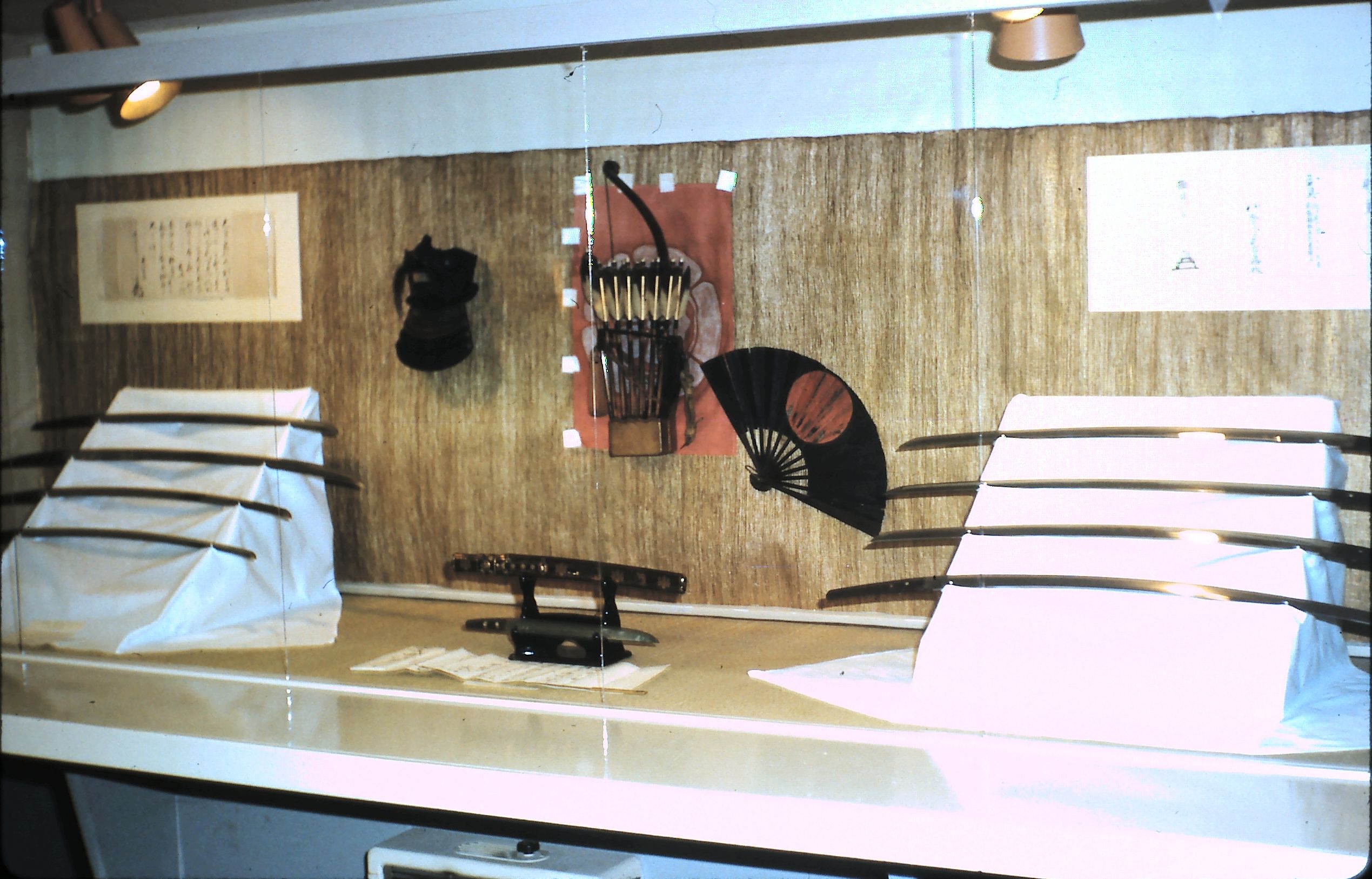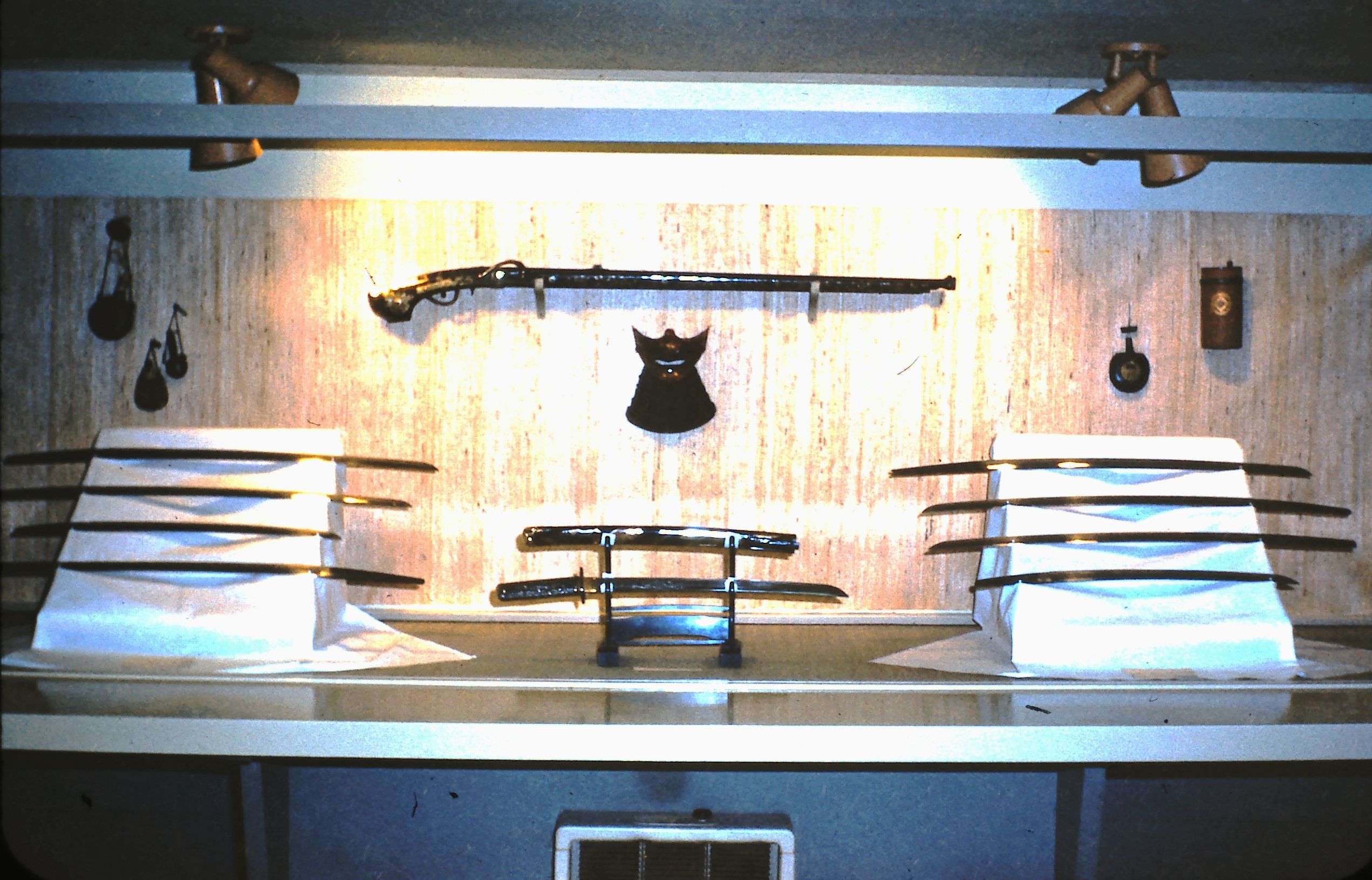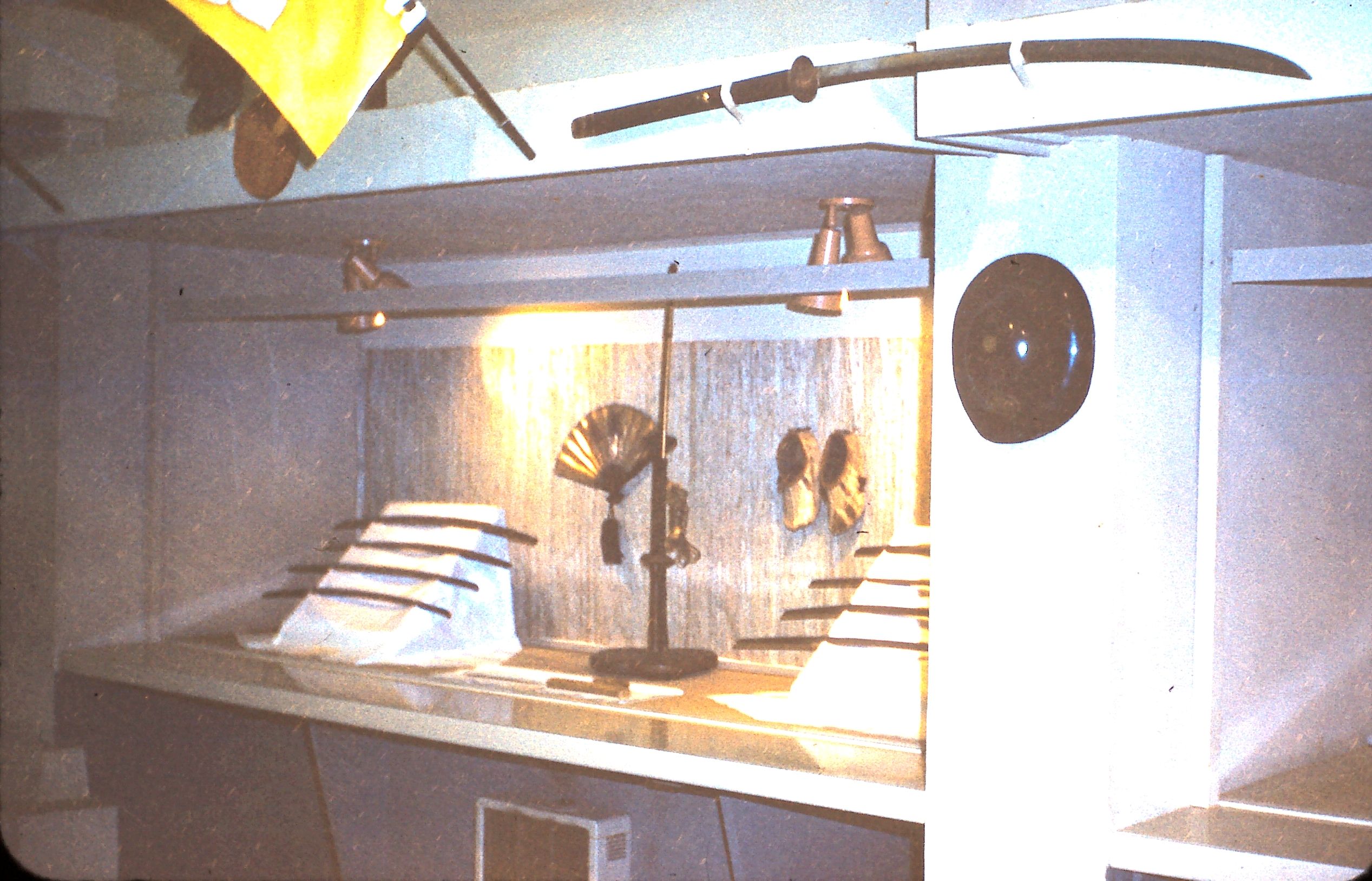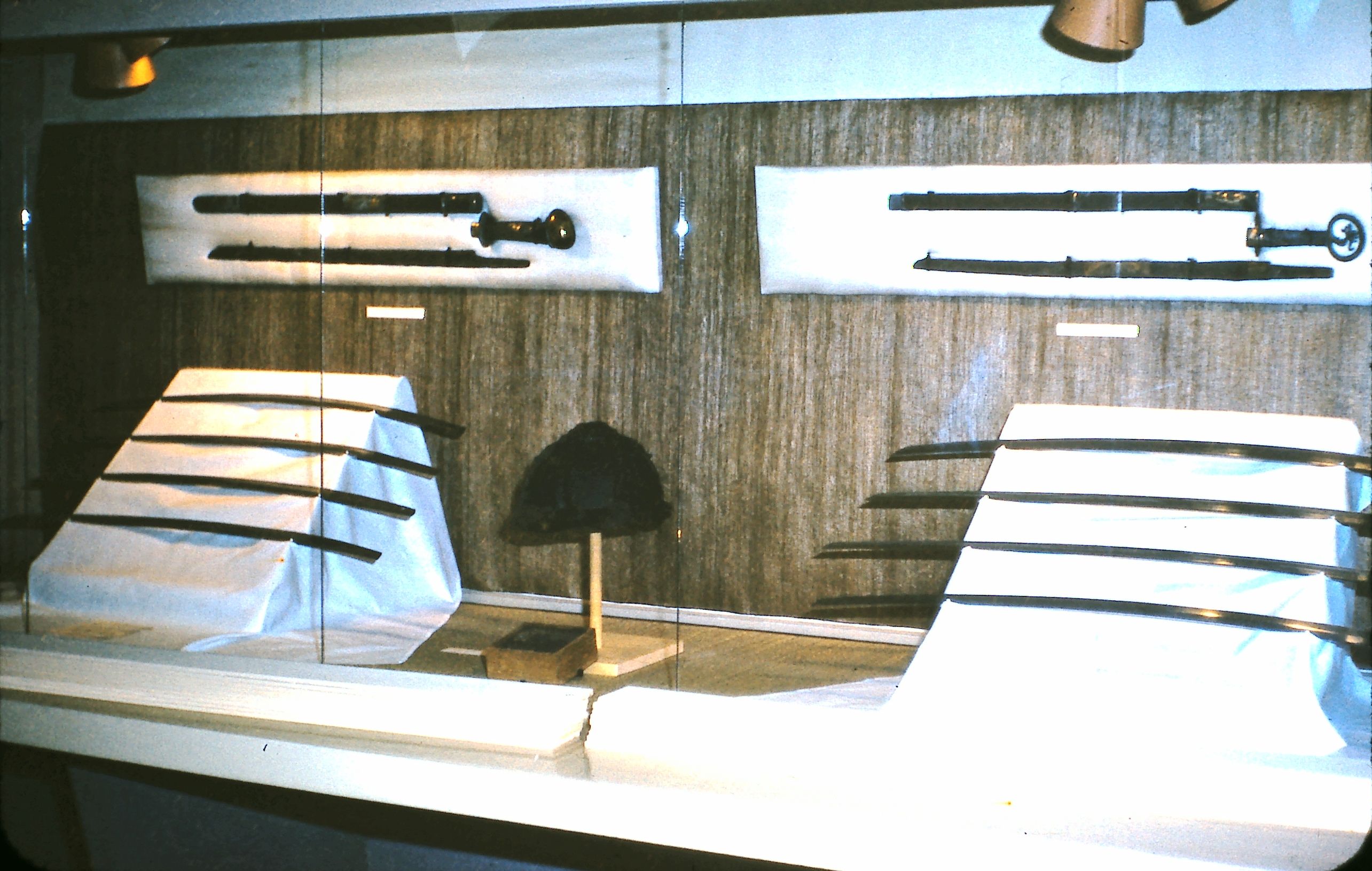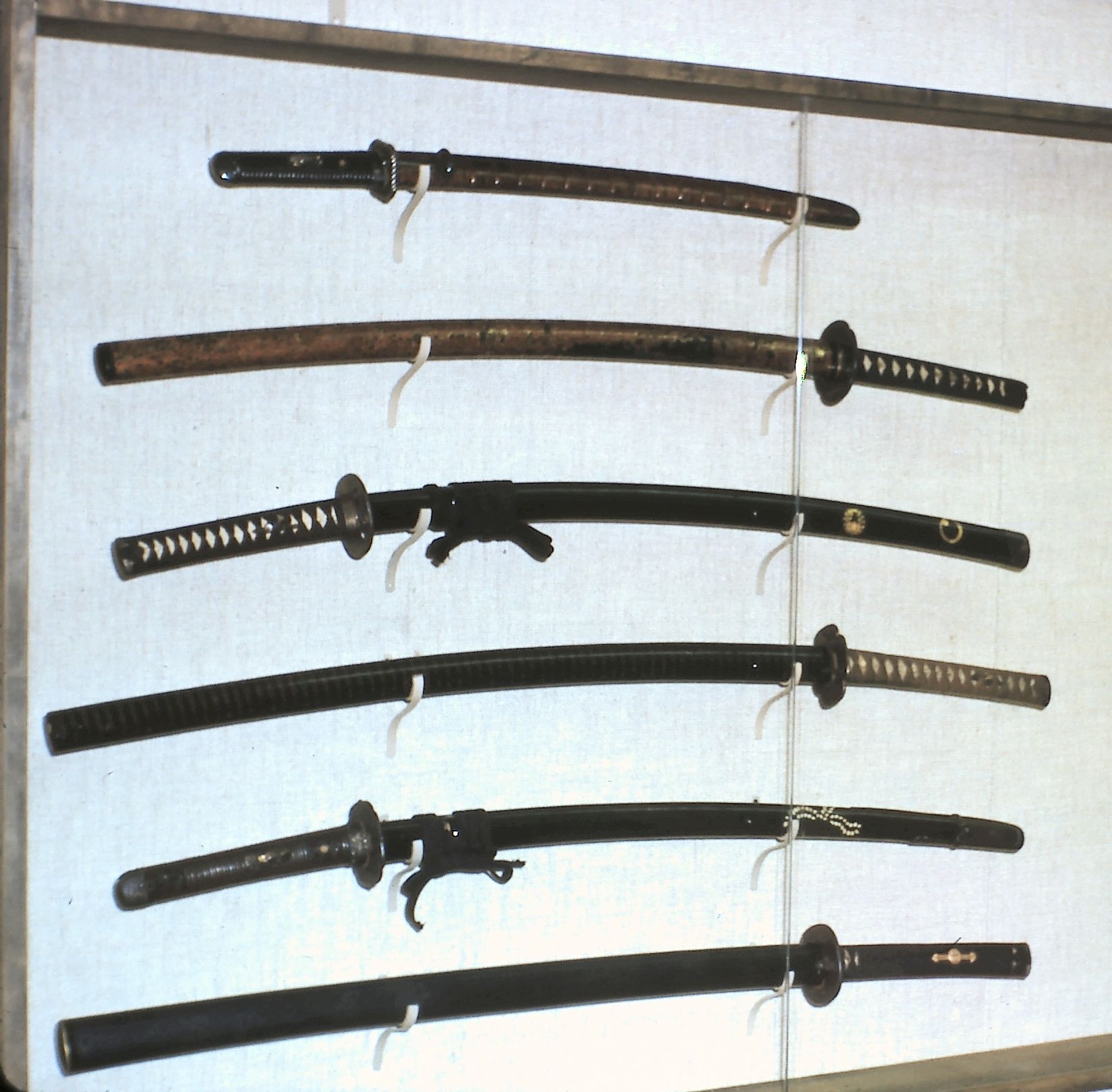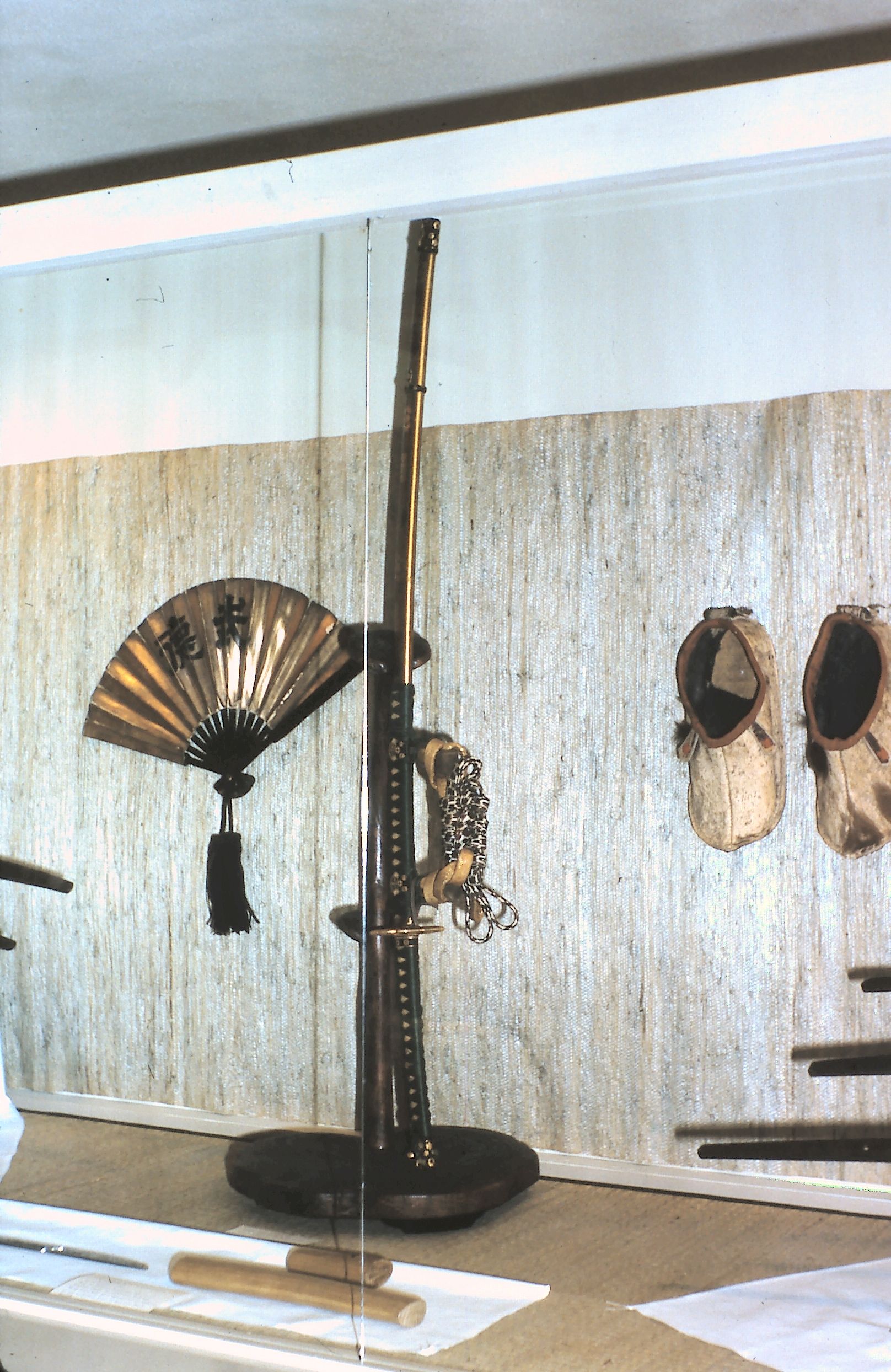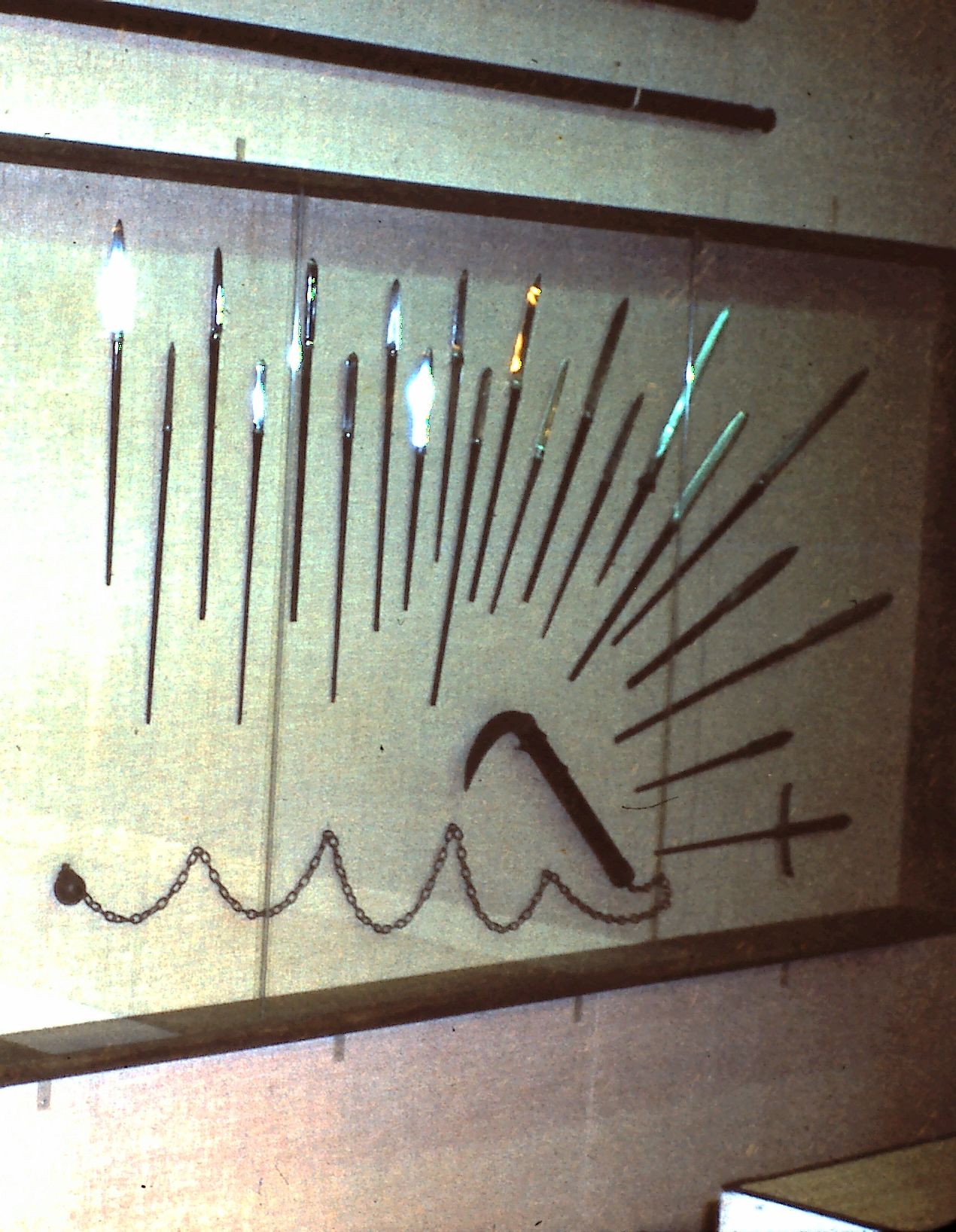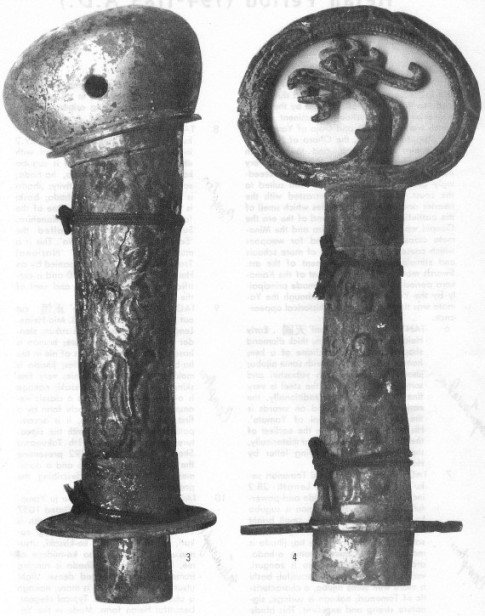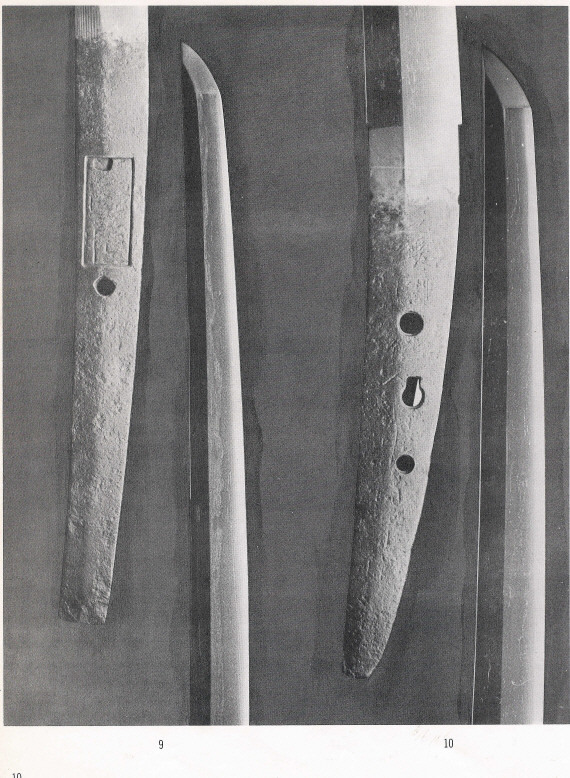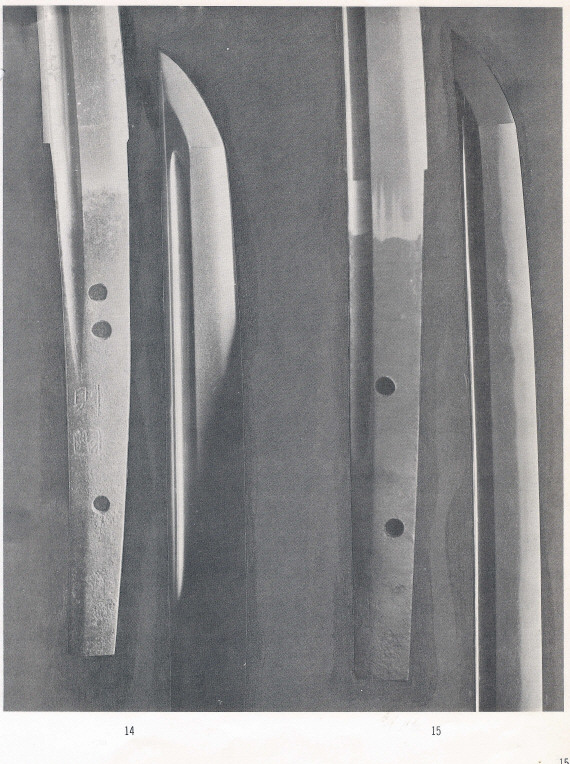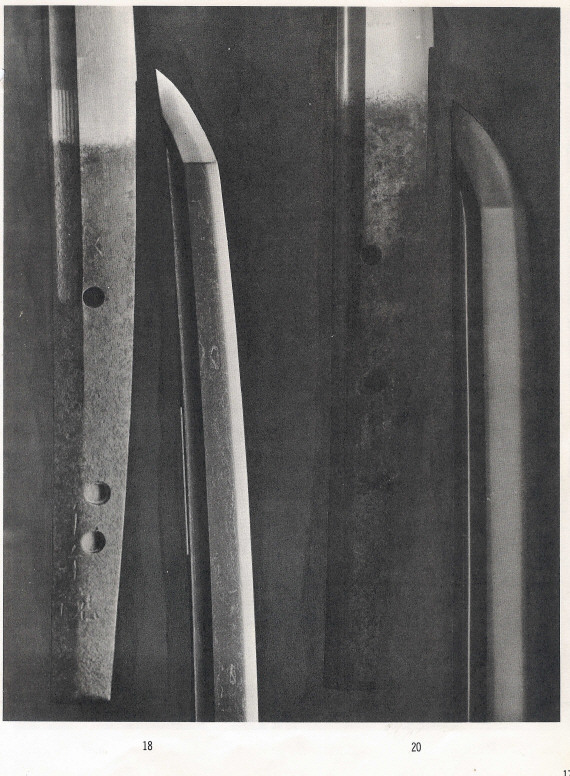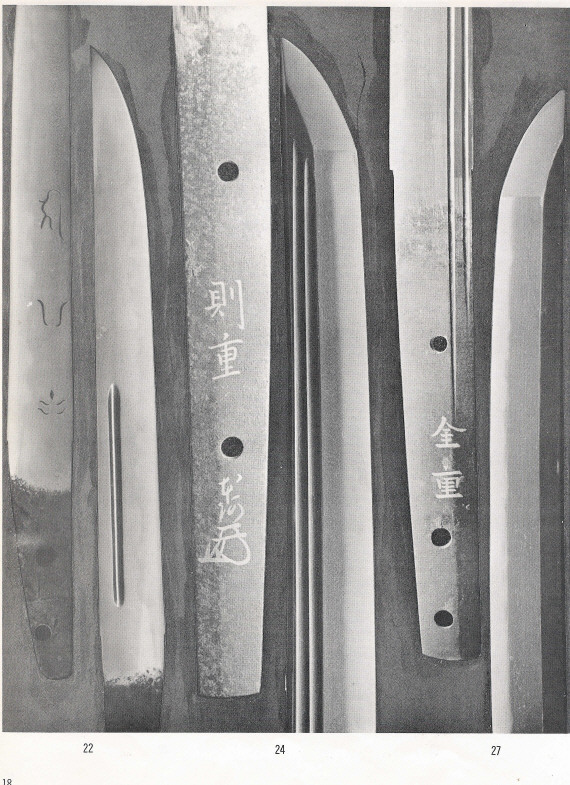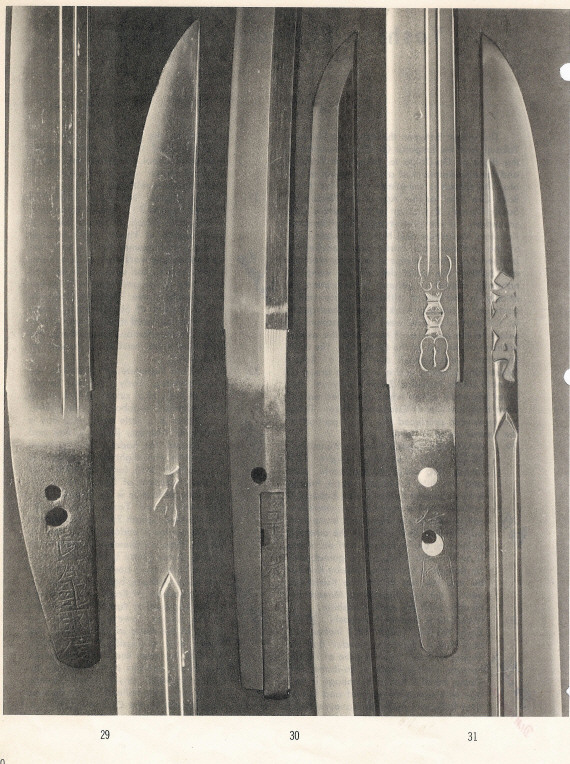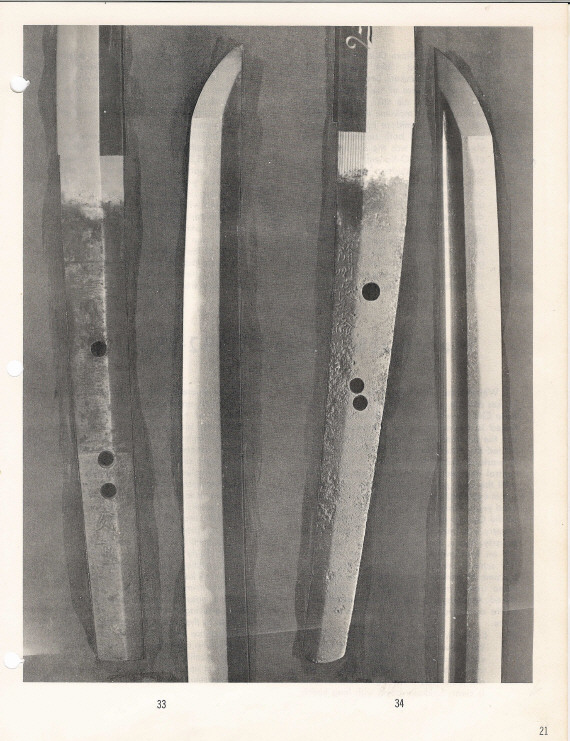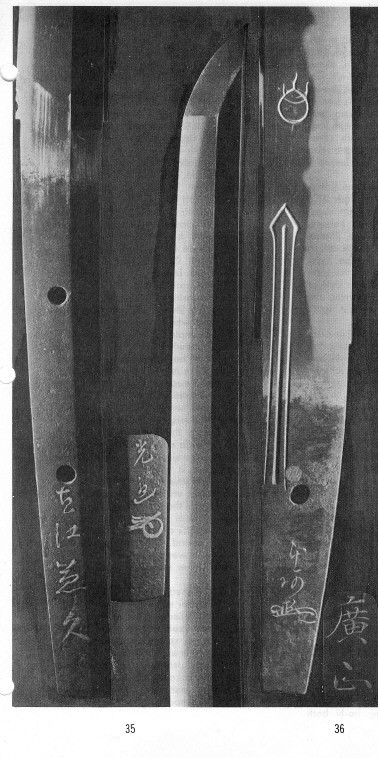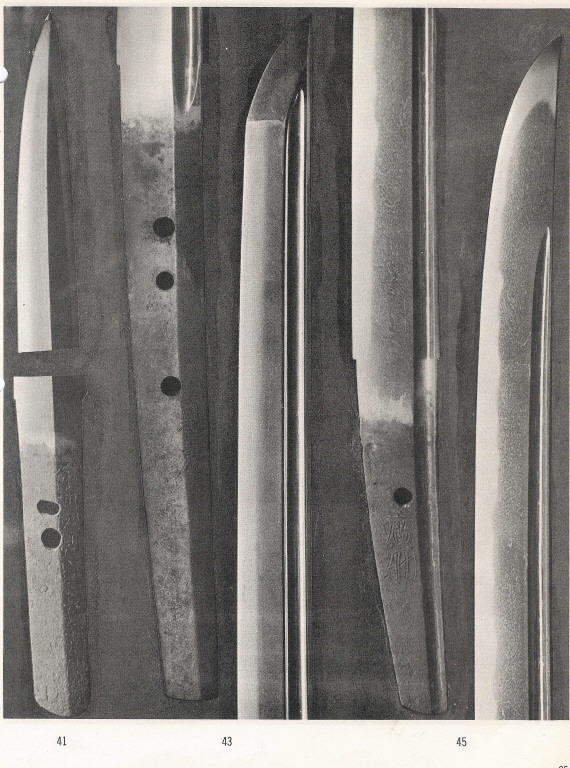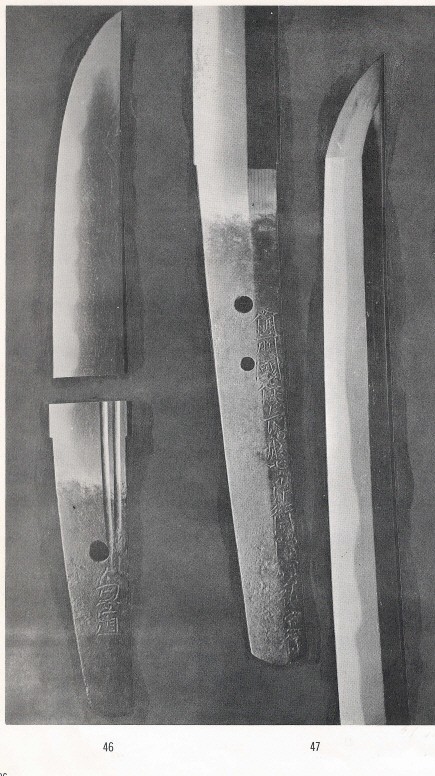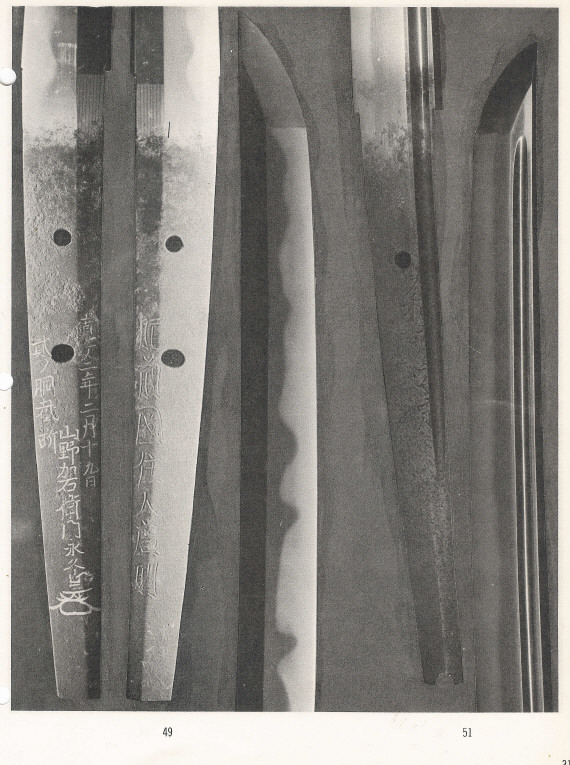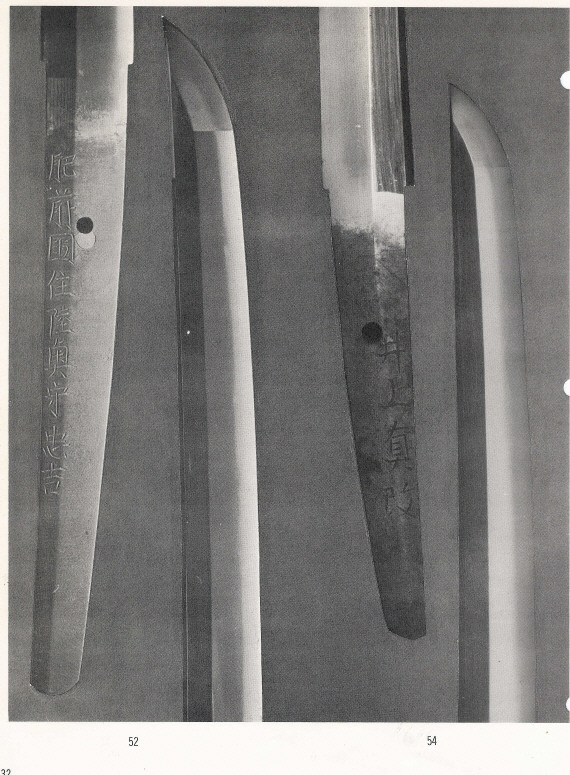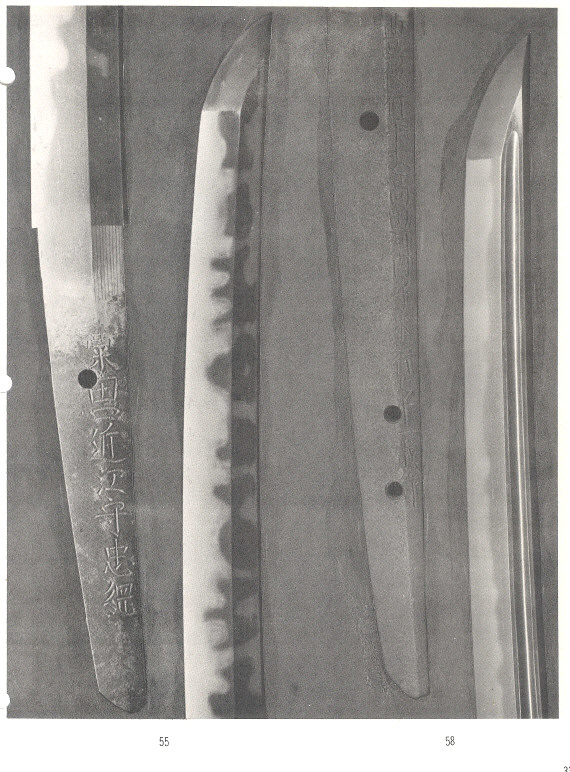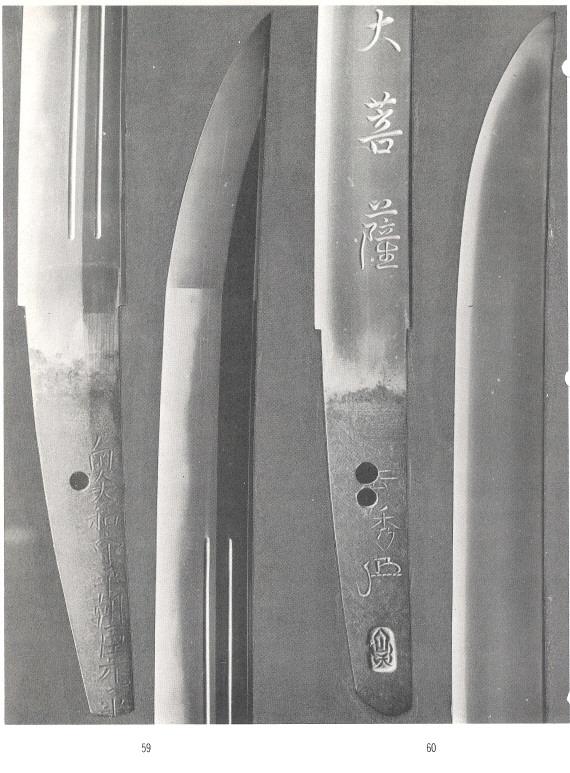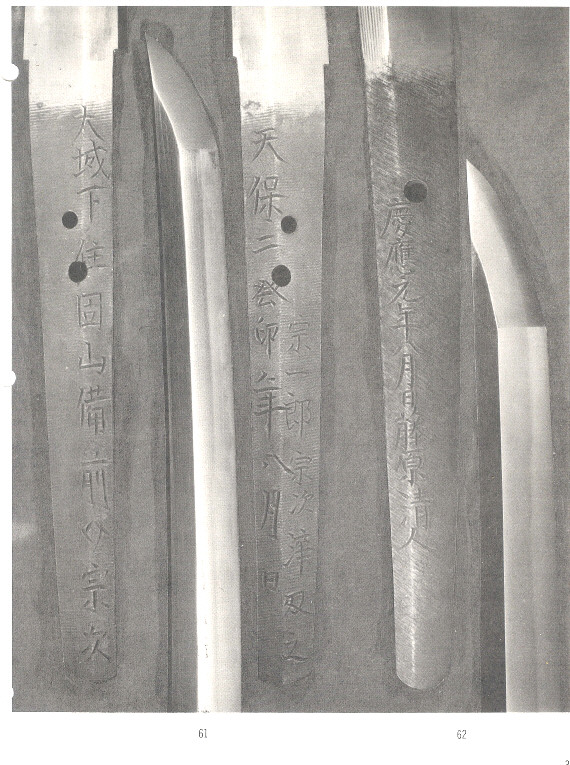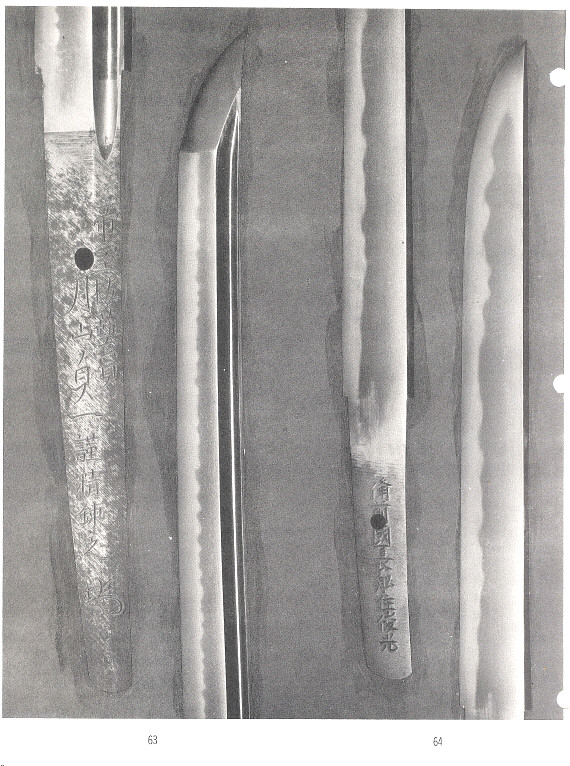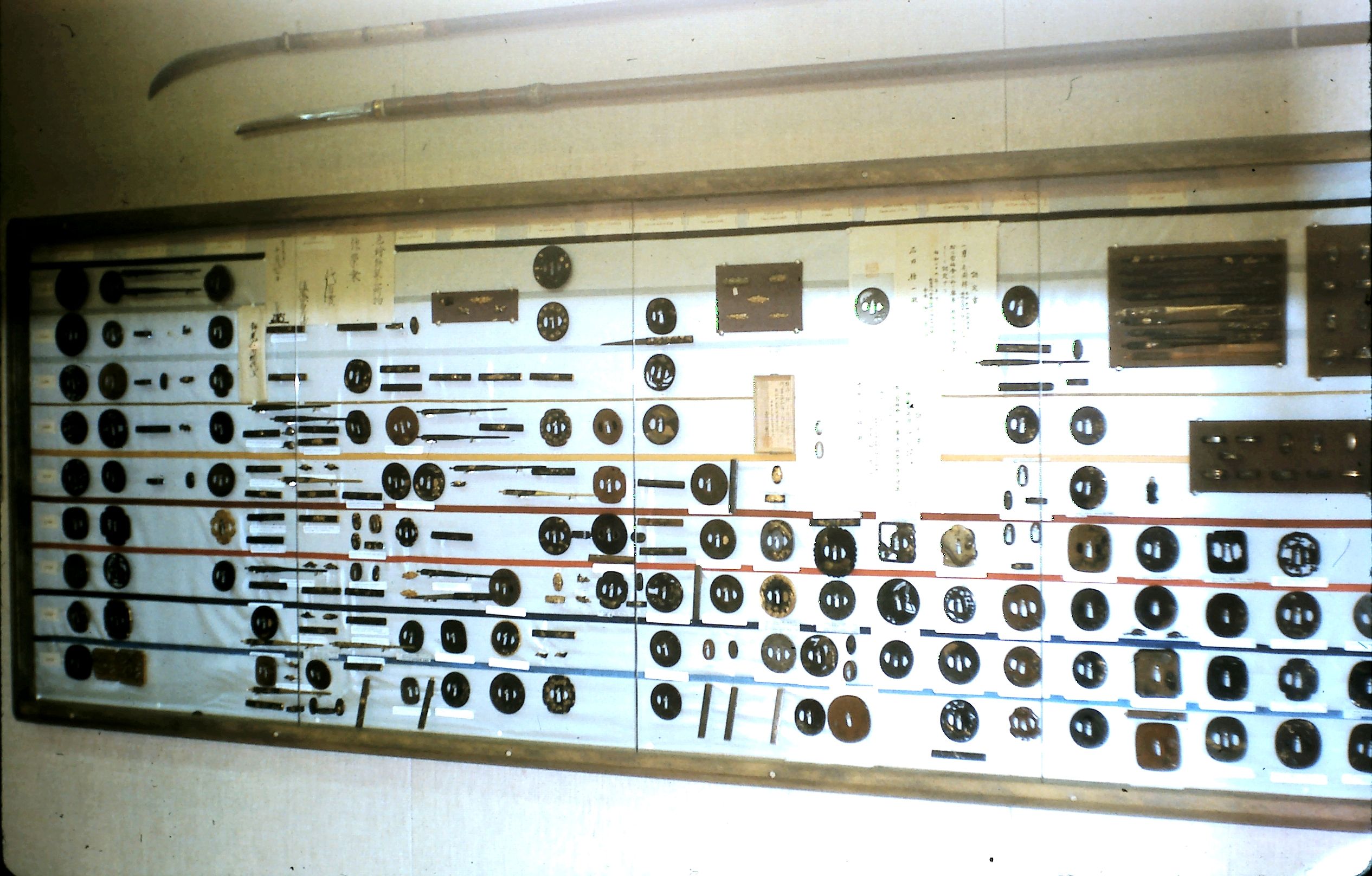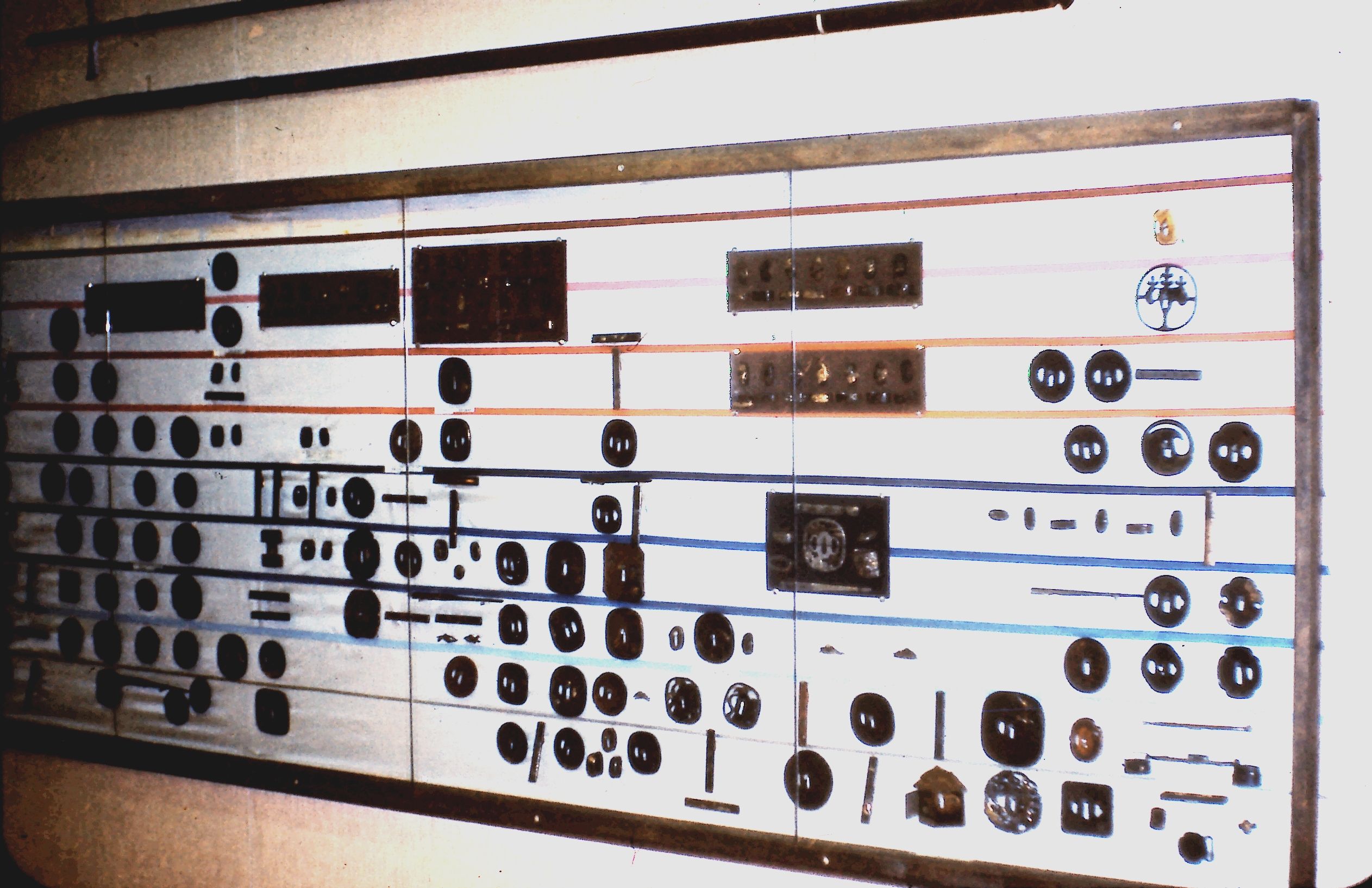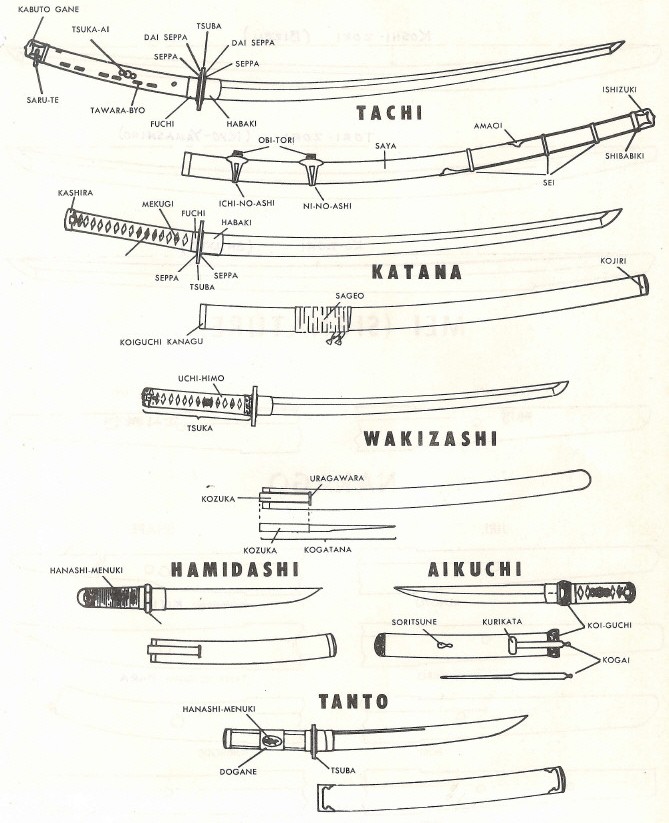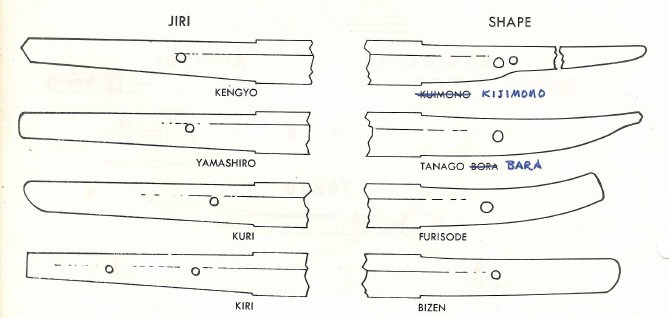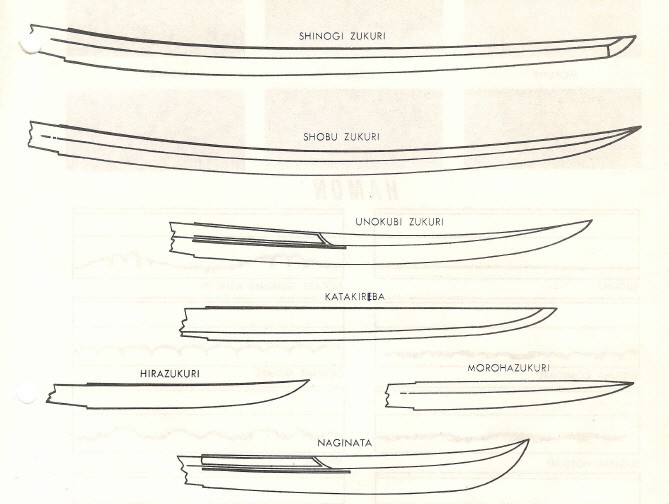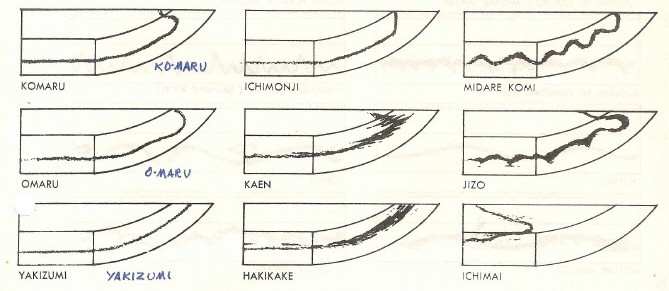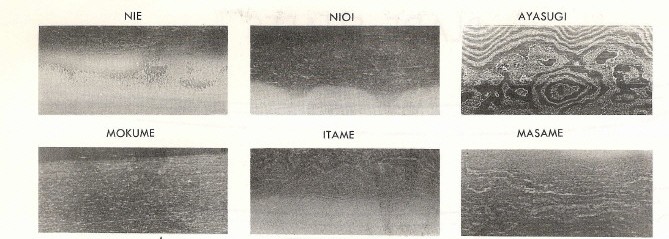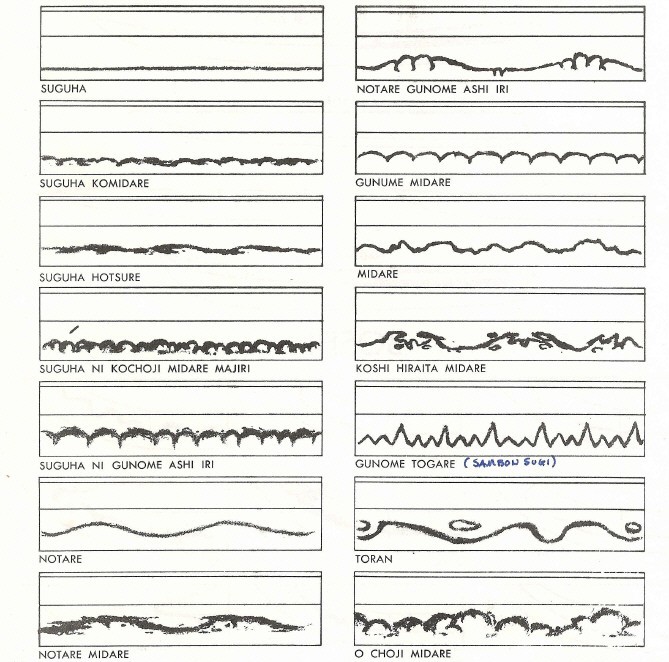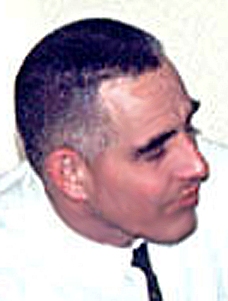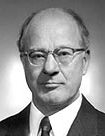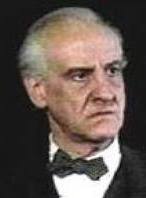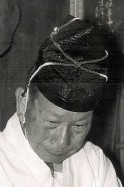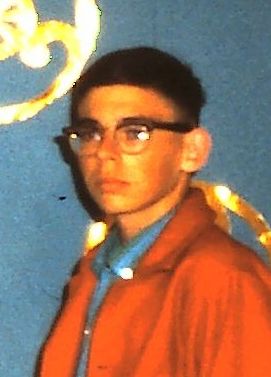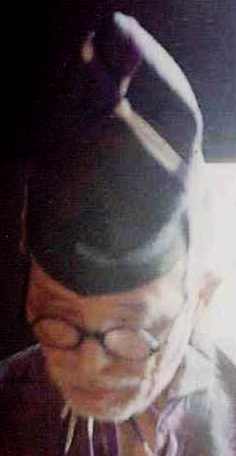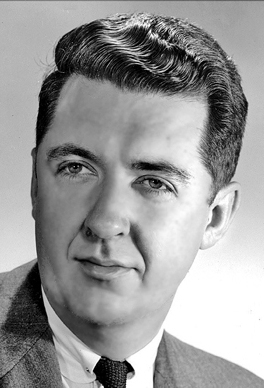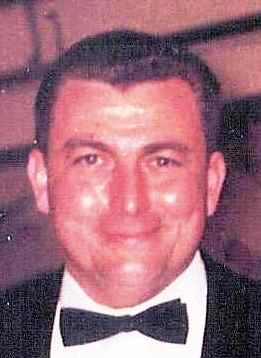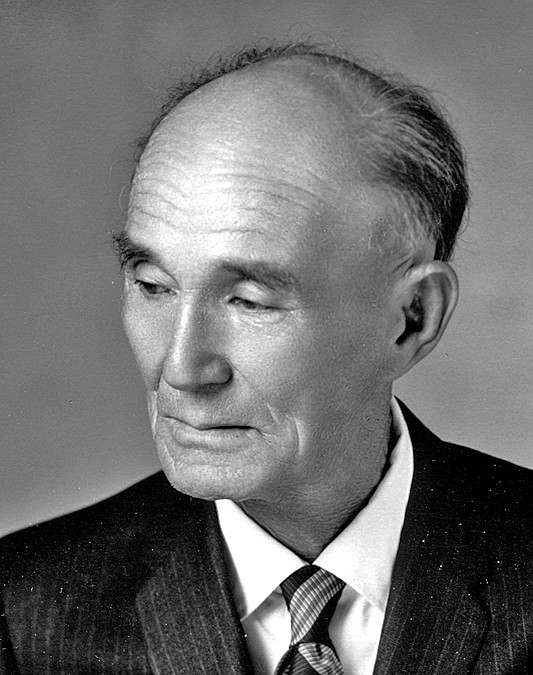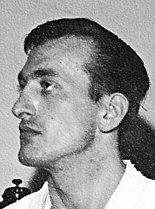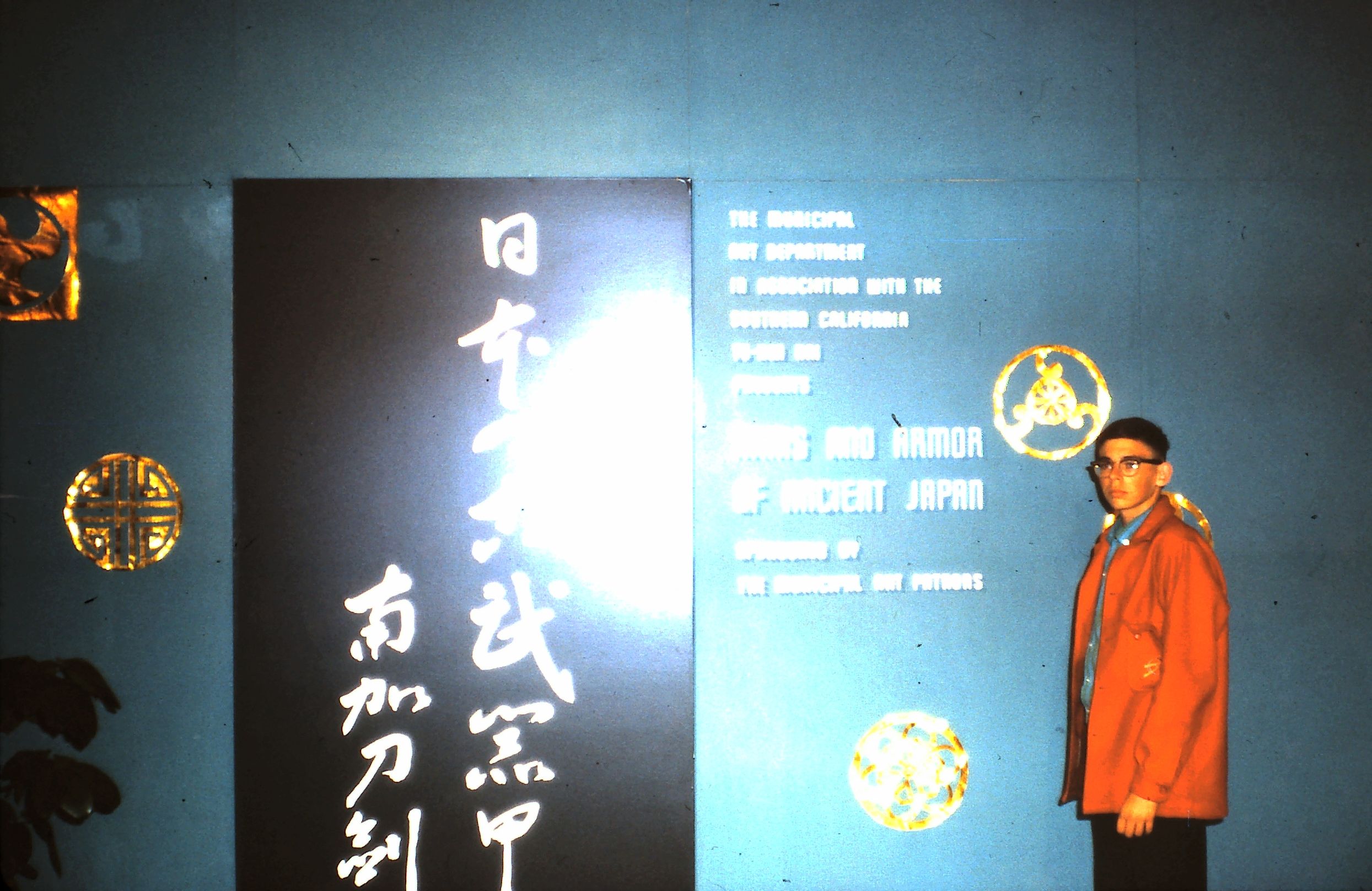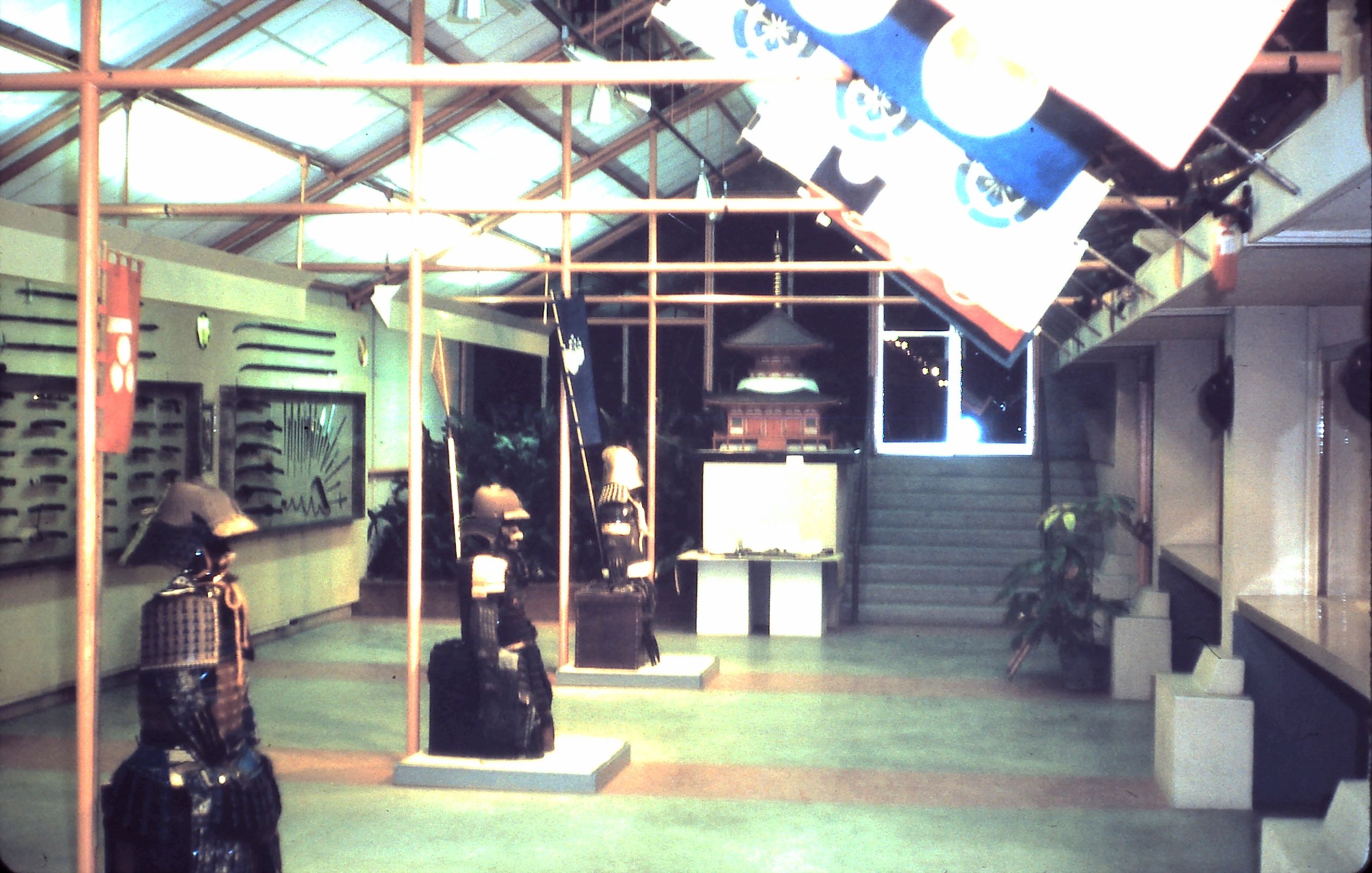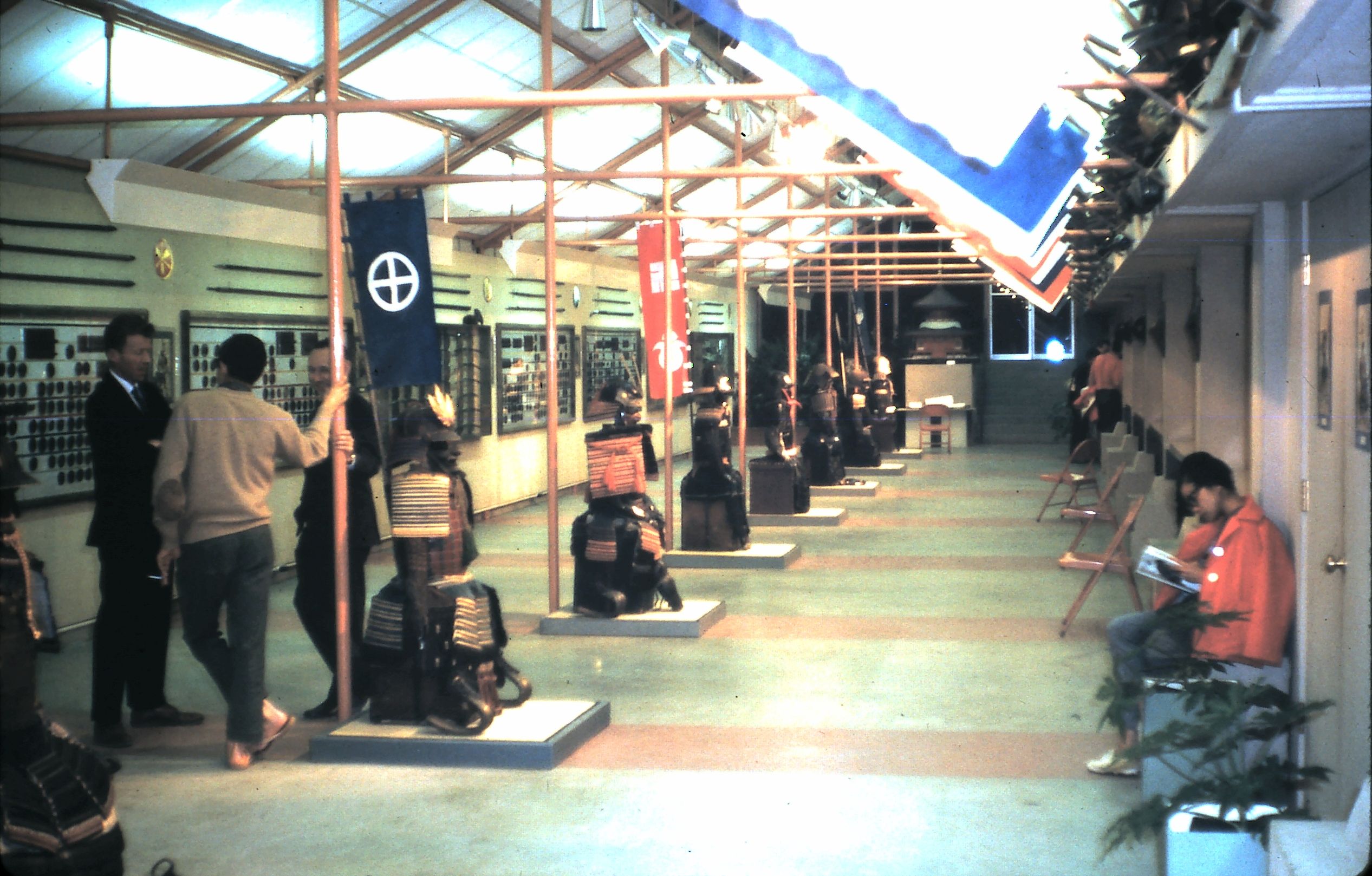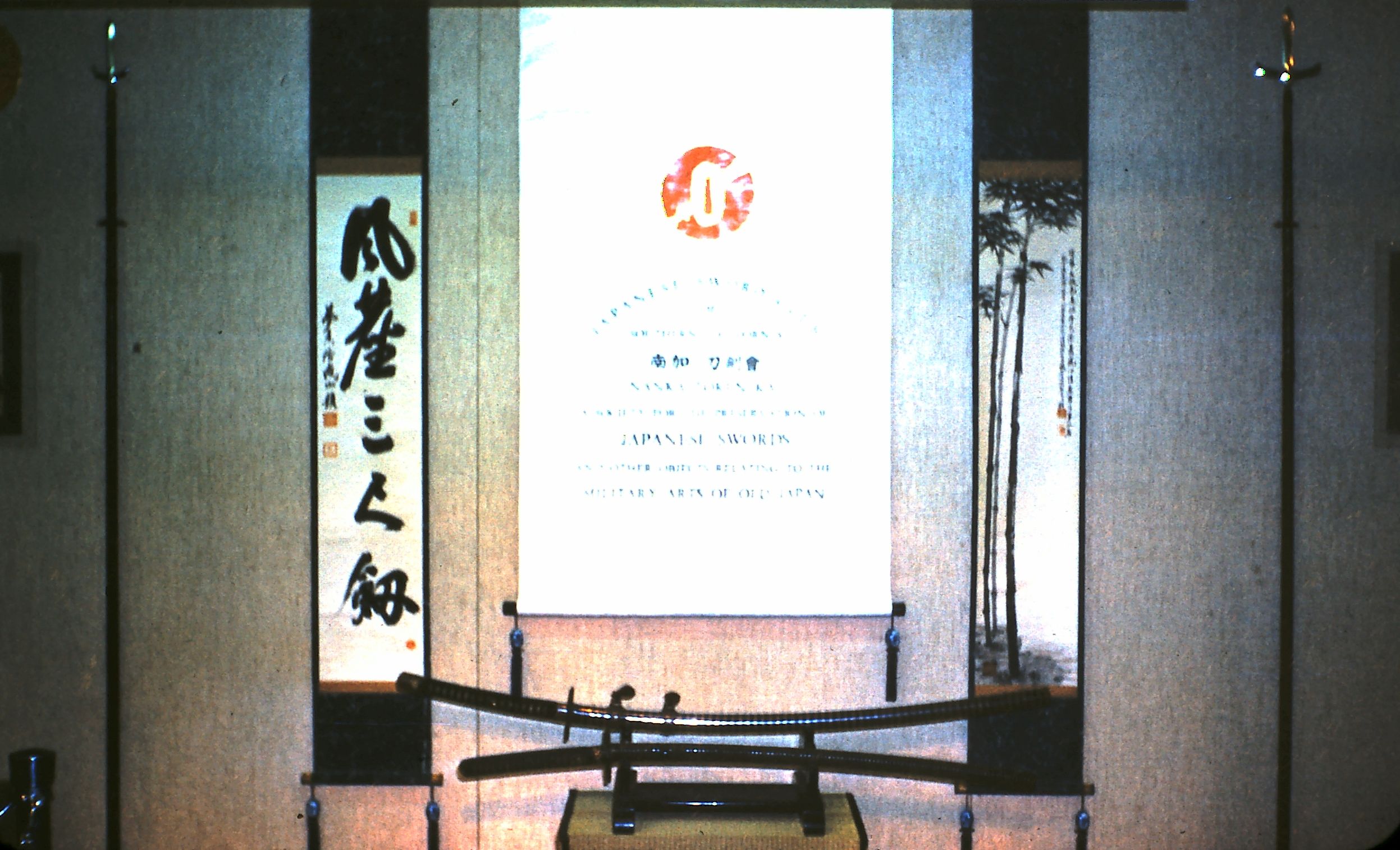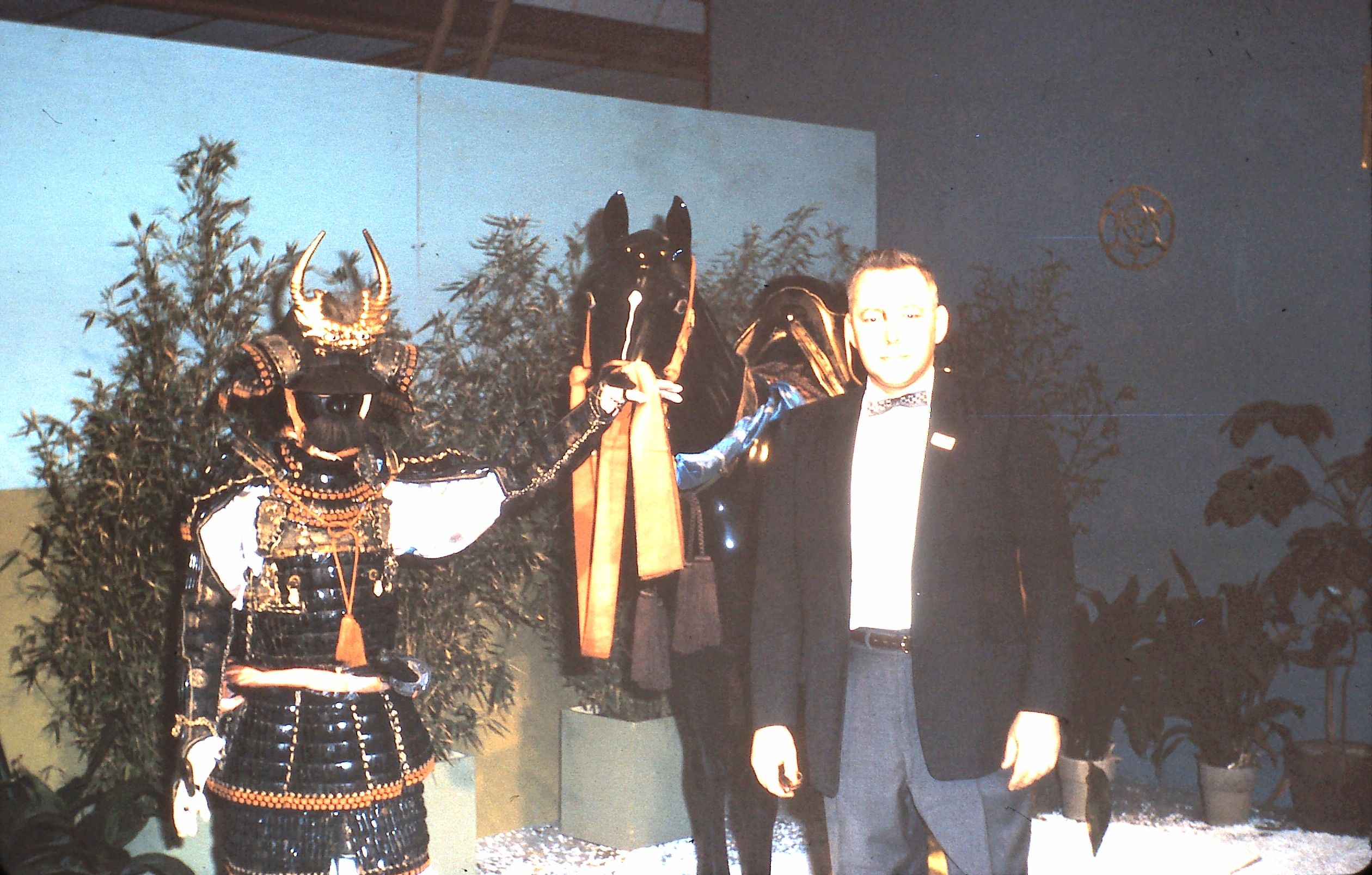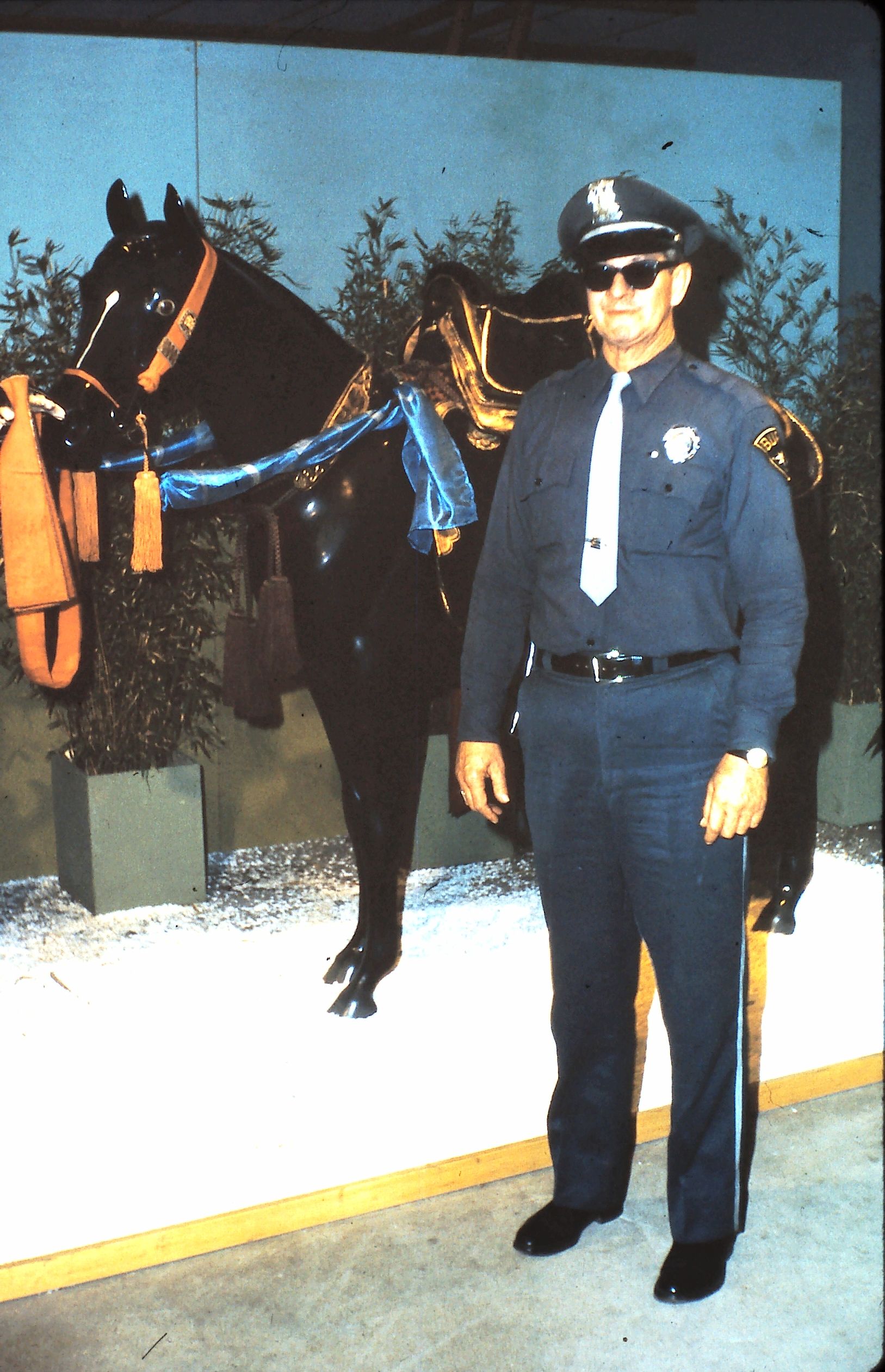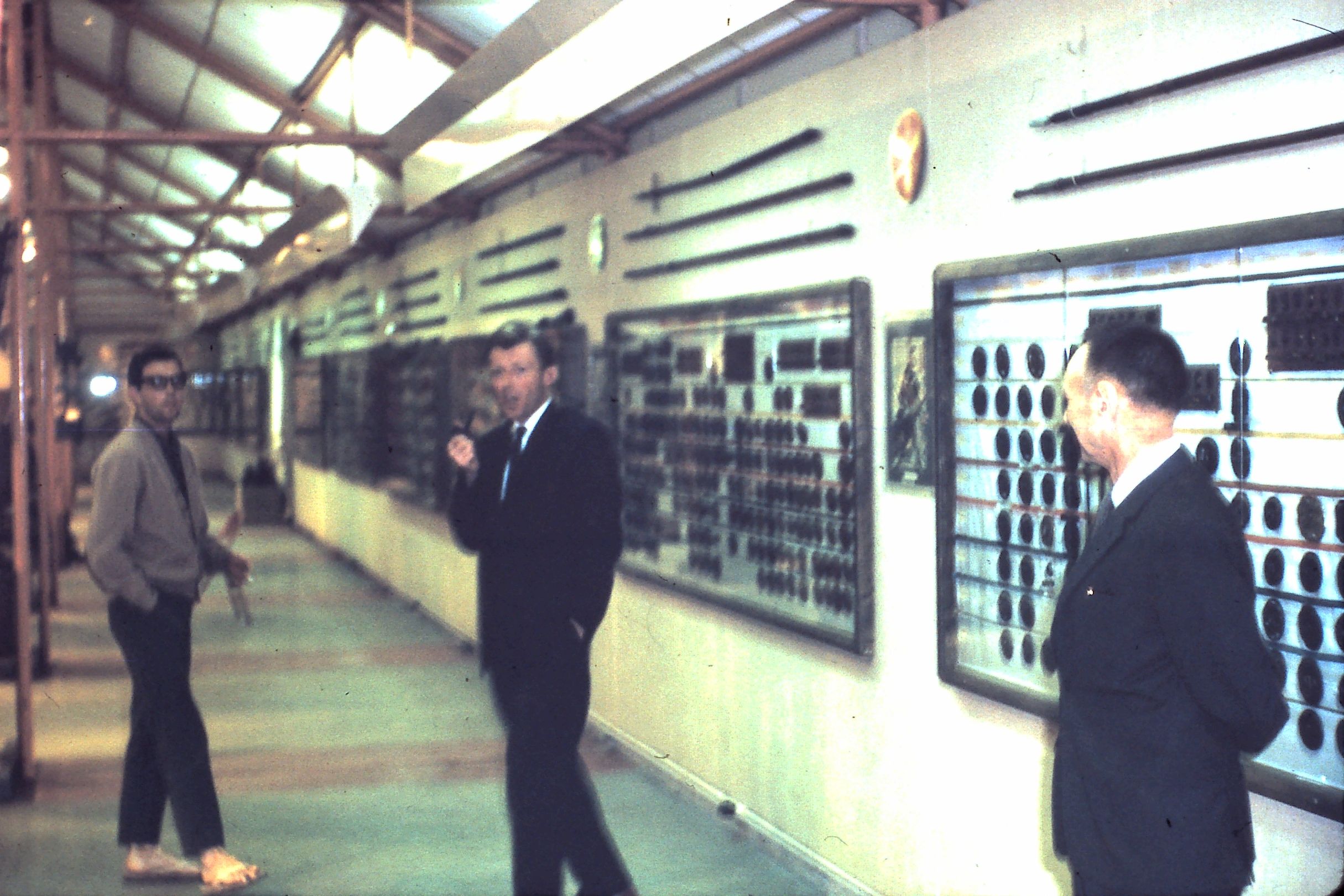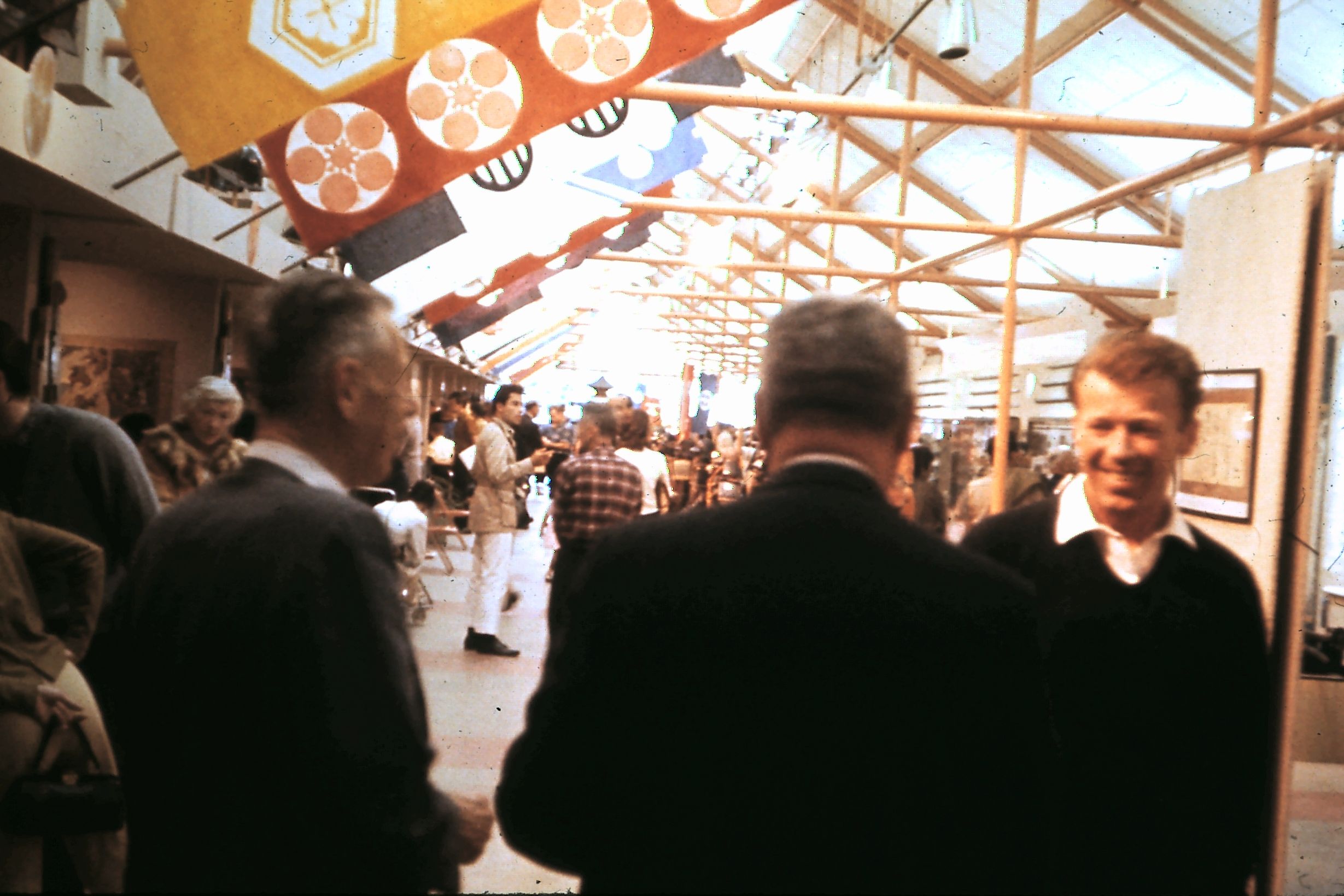Page
Last Updated:
Wednesday, 04 November 2015 13:35 EDT, © 1964, 2007, 2008, 2010,
2011, 2012, 2013
ARMS AND ARMOR OF ANCIENT JAPAN
An Historical Survey
Dean S. Hartley, Jr., President Nanka Token Kai
Fred Martin and Bob Haynes, Exhibition Co-Chairmen
Co-Sponsored
by the
Municipal Art Patrons of Los Angeles
and the
Southern California To-Ken Kai
Municipal Art Gallery, Barnsdall Park
February 19th Through March 22nd, 1964
|

Grand Opening: Two unidentified women,
Mayor Sam Yorty, Mrs. D. S. Hartley, Jr. |
 |
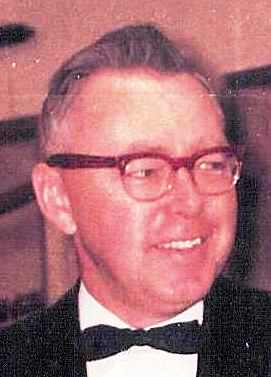
Dean Hartley |
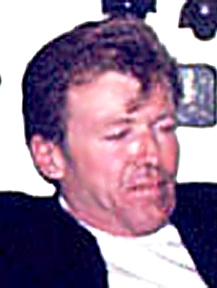
Fred Martin |
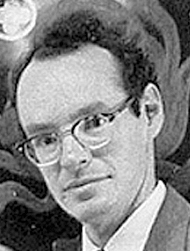
Bob Haynes |
|
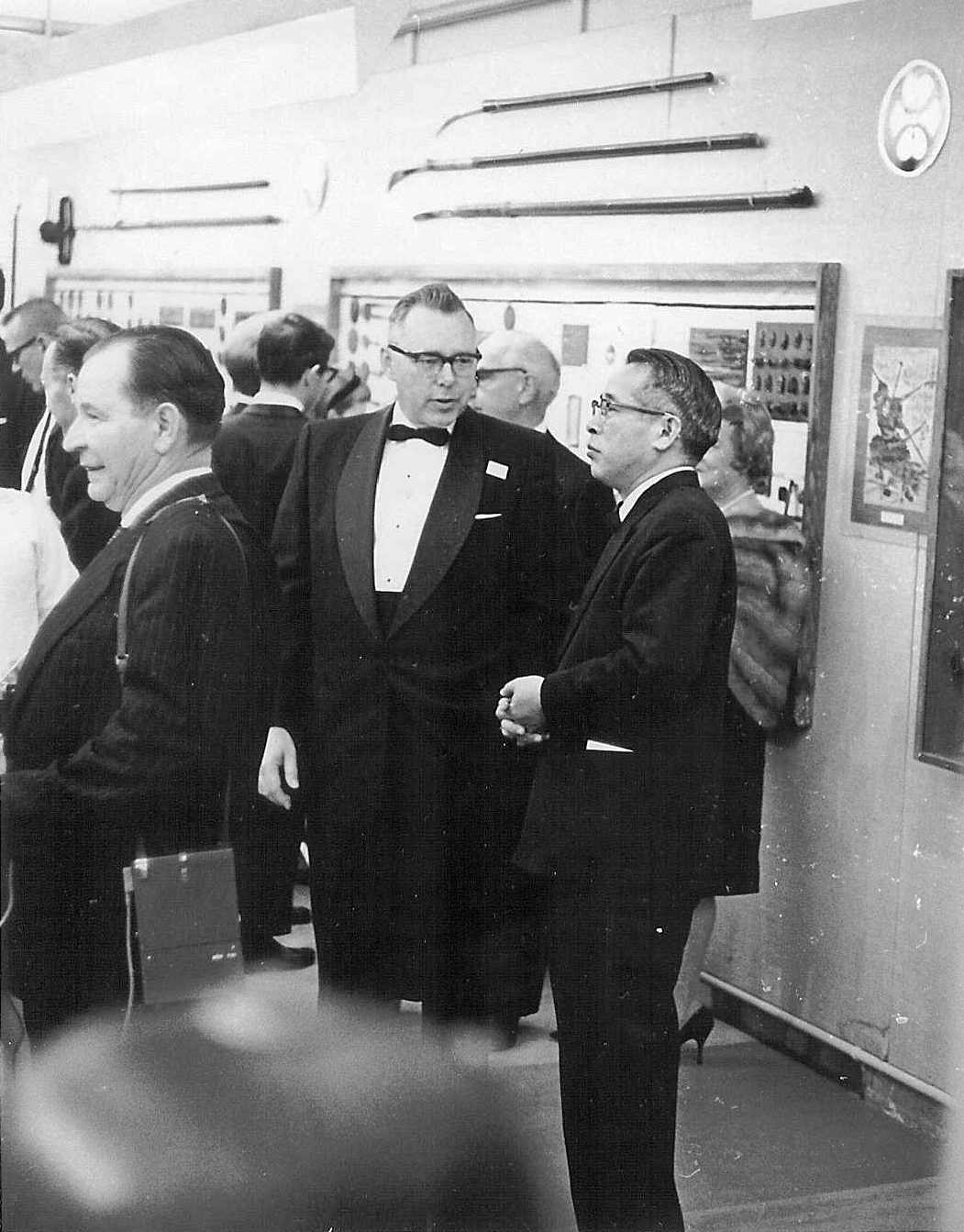
Hartley & Japanese Consul General (Los Angeles) |
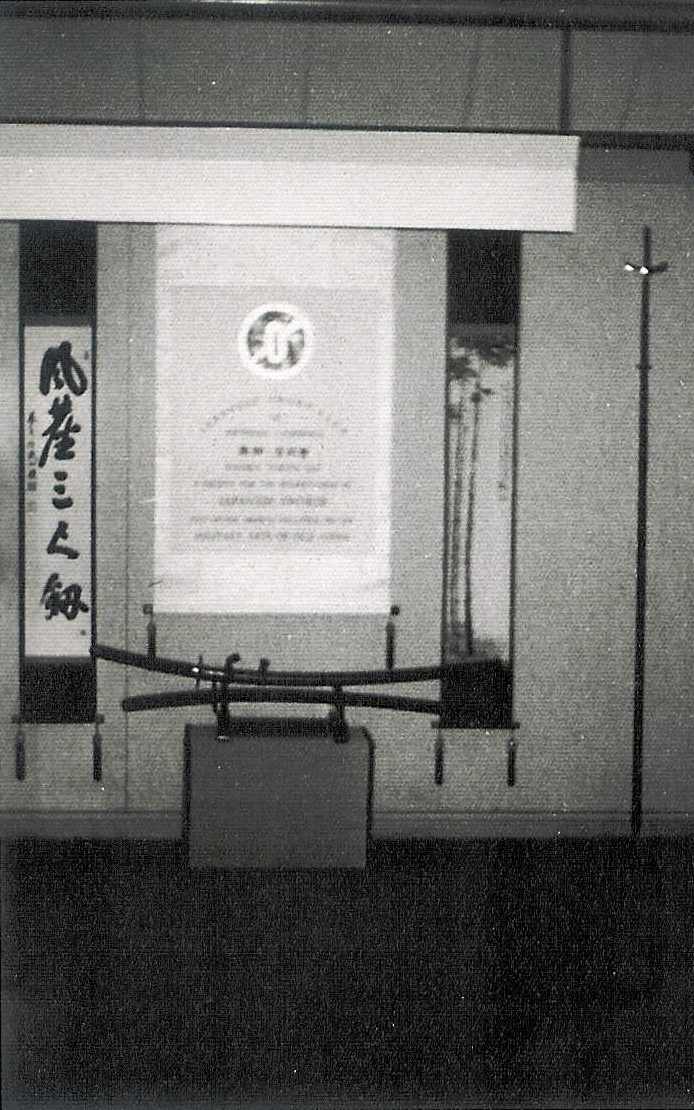
Opening Banner |
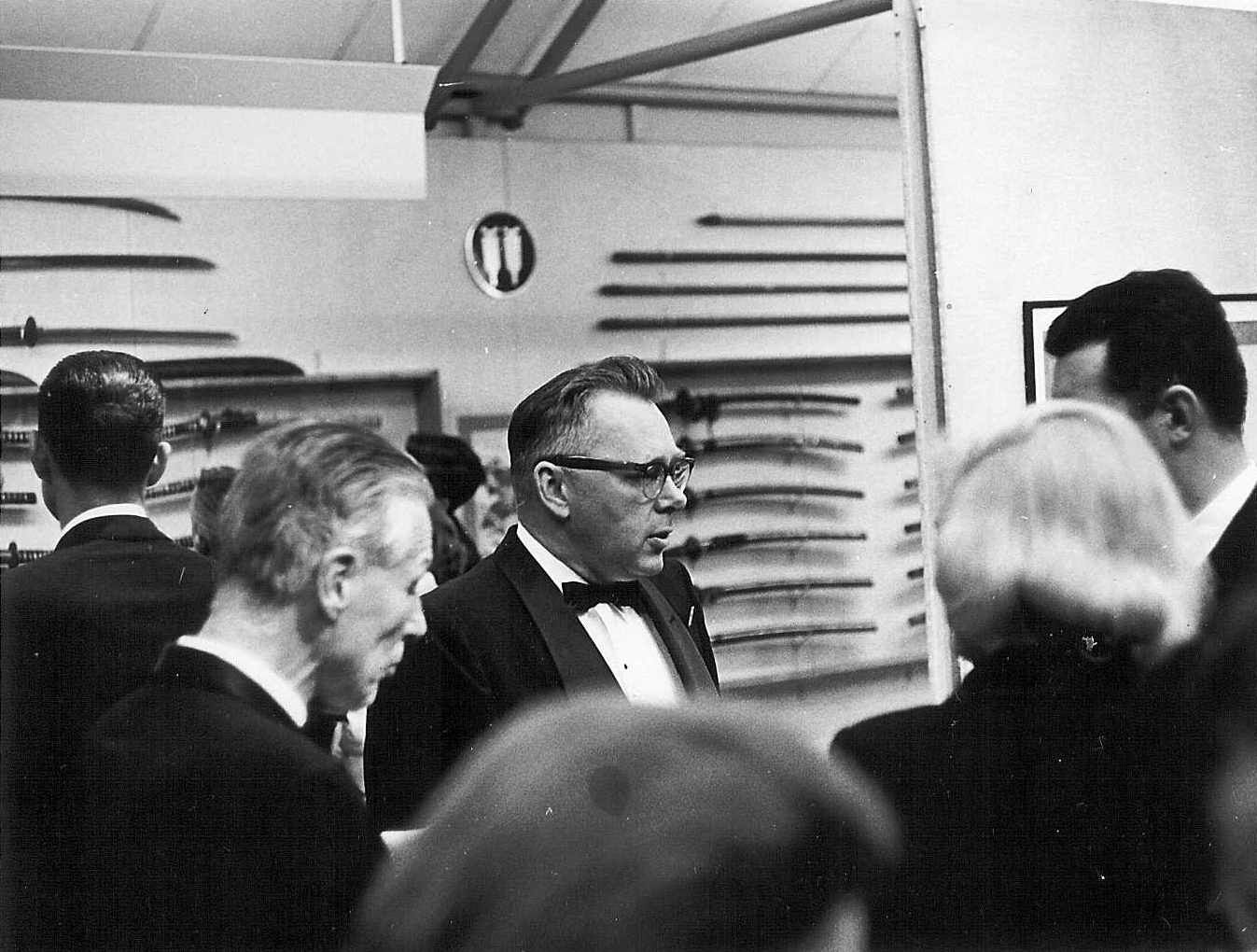
Willis Hawley & Hartley |
|
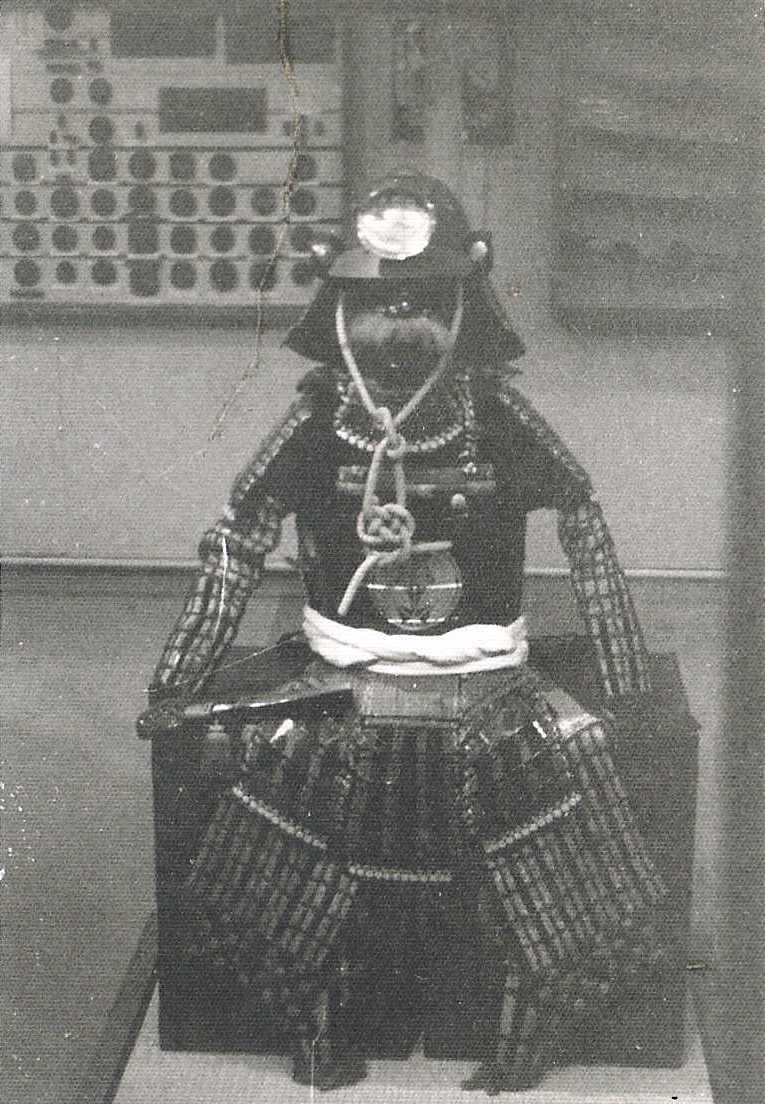
Armor on display |
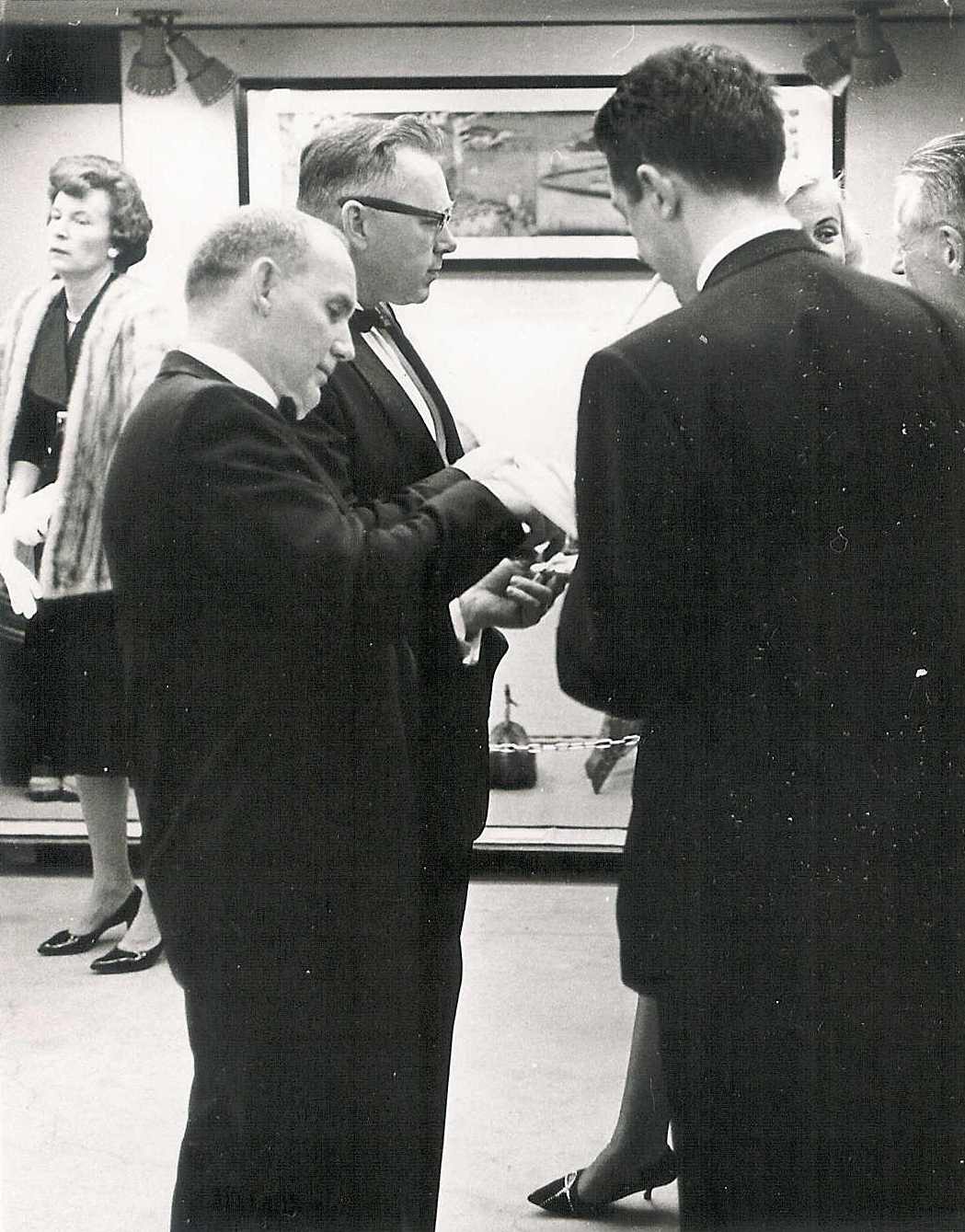
Fritz Miller, Hartley, George Vitt, Carolyn Frankenheimer,
& Willis Hawley |
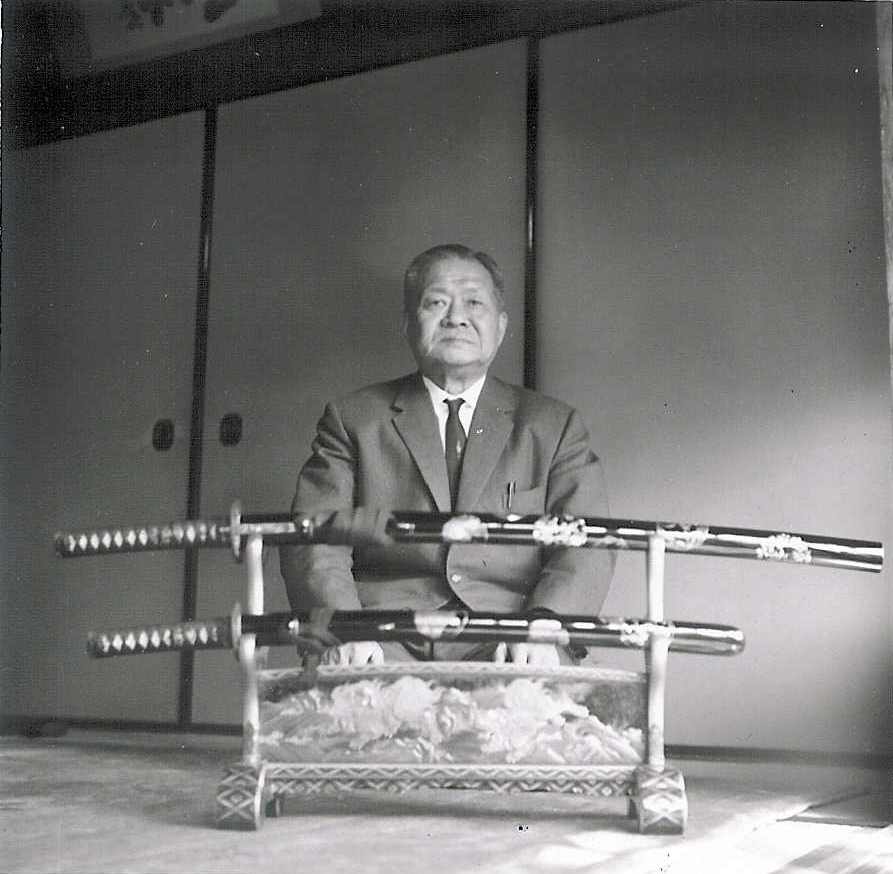
Mr. Taromatsu Okano & a Dai-Sho of fabulous mounts to a pair of
fabulous
swords, both by Sukehiro. |
|
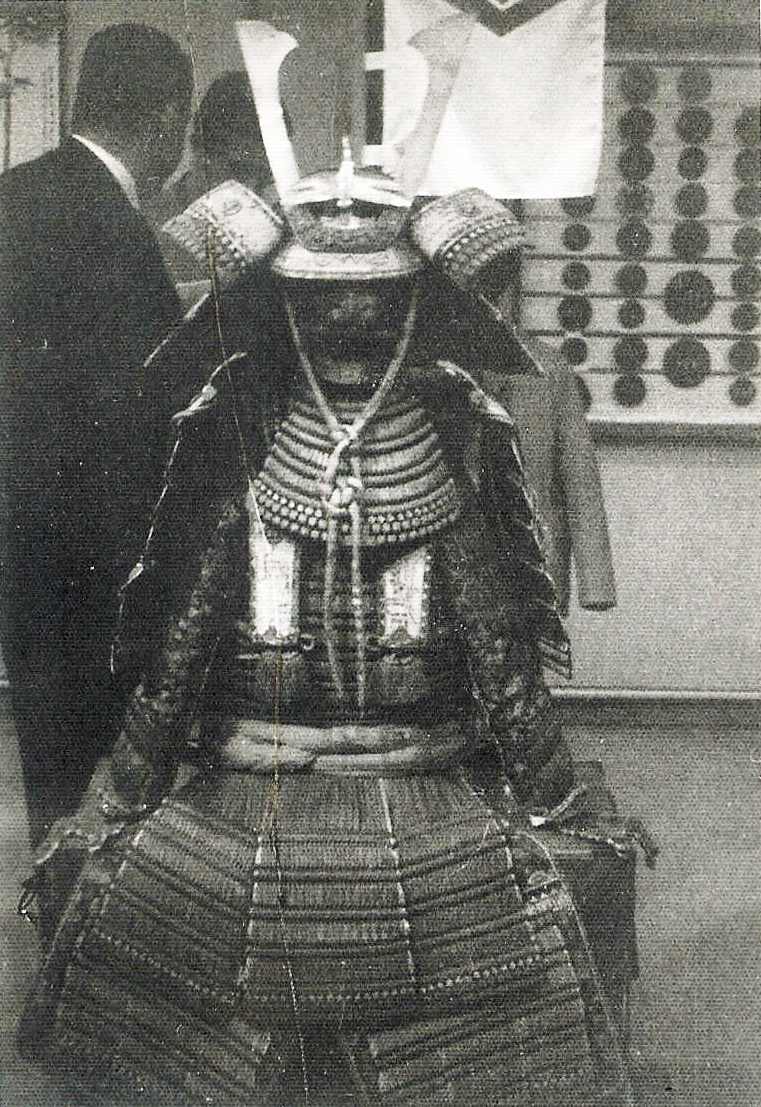
Armor on display |
 |
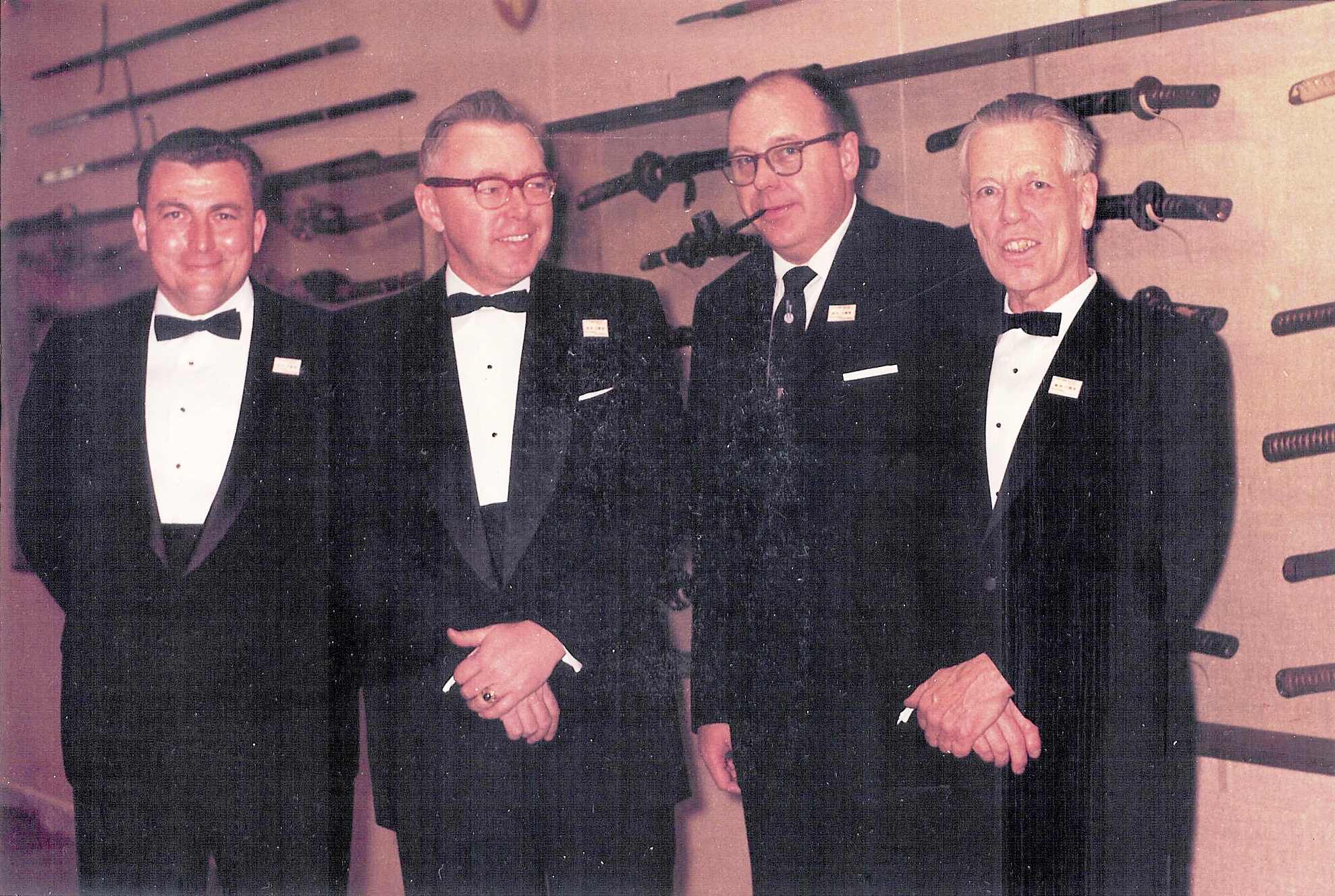
Bob Wainwright, Dean Hartley, Charles Cowdery, & Willis Hawley |
 |
 |
 |
 |
 |
 |
 |
 |
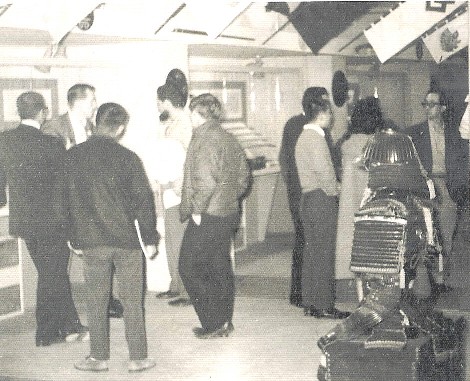
The show in progress |
 |
| |
Cover: Painting by Walther G. von Krenner |
The Sword with
pictures of the sword displays
Patrons with additional pictures of the exhibition
In Japan the sword and its associated fittings have for
centuries been regarded as an expression of the highest art, worthy of the
consideration of an Emperor and, in fact during the early thirteenth century,
the Emperor Go-Toba participated in the creation of masterpieces which approach
the zenith of sword excellence. The west has commonly regarded them as
curiosities, the products of a craft, and equated them with other swords. It is
the hope of the Southern California To-Ken Kai that this exhibit may in some
measure contribute to a better understanding of the Japanese sword and a more
correct evaluation of its artistic values.
The descriptive terminology in this catalogue is the language
of the sword and recourse to the glossary of terms will, for the uninitiated, be
absolutely necessary. From very early times expertise on the sword was the
exclusive property of families of sword experts, principally the Honami, who
maintained their knowledge as a closely guarded secret. Thus, the language was
intended to obscure rather than reveal. Further, the idiom is one which does not
lend itself to easy translation, there being no equivalent terms in the English
language.
Chronology is arbitrary since there is no close agreement
even among historians. The chronological divisions are in the main political,
the single exception being connected with sword history. Most divisions in sword
history coincide with political divisions, there being a strong interconnection
between the two.
It is to be regretted that all of the material exhibited
could not be included in the catalogue. Examples were chosen not only on the
basis of quality but as specimens representative of a particular time and
school. Selection was made from an aggregate total of over two hundred swords
and seven hundred tsuba exhibited.
The study and collection of the Japanese sword and its
fittings is attracting a growing list of followers from widely assorted
backgrounds. Their common interest is an appreciation of the unique skills and
creative talents which rank the master swordsmith and the ciseleur with the
enduring artists of this and future times. Their rights to such distinction are
evident in the pieces chosen for display in this exhibit. Many are rare
examples, many are seldom seen masterpieces ... all are fine examples of the
art.
Our deep appreciation is extended to those institutions and
individuals who so generously made their collections available to us, to the
people without whose unselfish aid this achievement could never have been, and
to the Los Angeles Municipal Art Patrons for their unremitting support of our
hopeful effort.
F.C.M.
Editor's note: The actual catalog contains the Japanese characters for the
smiths' signatures, which are not reproduced here. Also, some of the pages have
been rearranged to take advantage of the web format versus the page format of
the original catalog.

1.
Standing figure of a warrior in full armor,
Kofun Bunka Period. |

2.
Armor: red laced Oyoroi (great harness) of the Edo period in an
early style. |
Armor on display at the exhibit.
Return to the Table of Contents
Preserved within the confines of Todaiji temple in Nara is an
ancient storehouse founded in 756 A.D. as a memorial to the Emperor Shomu. In
this relatively fragile structure all of the Emperor's personal possessions,
together with gifts of the court, have remained inviolate to this day. Included
among the treasures dedicated were swords, armor of plate and scale, bows,
arrows, pole arms of several types, and other military equipment. During the
Oshikatsu rebellion in 764 A.D. the weapons were removed to the palace by
imperial command and much was lost in the subsequent fighting. The precious
remainder serve as the principal source of information about the weapons of the
period. Among the rest, forty nine long swords were left, their blades bright
and shining today. These swords exhibit every important characteristic found at
the culmination of the swordsmiths' art five centuries later. Although the sword
underwent modifications during the succeeding centuries, the shape and
underlying principle remained the same. Thus, old swords remained serviceable
until the last and were carefully preserved, both for their utility and because
of the deep reverence which the Japanese feel for the blade.
All swordsmiths, regardless of the place or time, have been
confronted with the problem of creating a blade which would neither bend nor
break and yet would cut well. The unique Japanese solution to this problem was
the development of what may be called a composite blade. The basic principle of
the Japanese sword is the support of an extremely hard edge steel by means of a
tough resilient back. This was achieved by enclosing the edge steel in a mild
steel back, by wrapping a mild steel core with edge steel, or by complicated
constructions utilizing appropriate steels.
Traditionally, Japanese swords are classified into five
schools or methods named after the province in which they originated: the
Yamato, Yamashiro, Bizen, Soshu, and Mino, listed in the order of their
historical appearance. They were, simply, different paths to the same goal
differing only in technique. The basic principles were identical. All Japanese
swords are composed of steels which were forged, folded, and reforged a number
of times consistent with their utility, edge steels fifteen to twenty times and
the milder steels six to eight times. Sometimes during the folding the grain of
the steel was crossed. Heat treatment was accomplished by coating the blade with
refractory clay which was thinner at the edge, bringing to heat, then quenching
in water. The area at the edge, having less insulation, cooled rapidly and
became hard. The back, covered with thicker clay, cooled slowly and became
tough. At the same time the differential cross-sectional thickness in the blade
caused it to assume a curve.
The spectacular polish found on Japanese swords not only
enhances their beauty by making visible the tempered edge pattern and the
details of forging which are so important to an aesthetic appreciation, but
makes possible a visual evaluation of the essential qualities of the sword. If
the grain created in the forging process is small and the heat before quenching
high, as can be determined by the presence of a wide tempered edge and coarse
nie (mirror-like particles of Martensite), the blade will be brittle.
Conversely, if the grain is large and the tempered edge narrow and composed of
nioi (cloud-like Martensite) then the blade will be soft. All of the elements
involved in the making of the sword must be compatible, the grain of the steel,
the temperature of the water, the thickness of the clay, and the heat. An
infinite number of correct combinations are possible. Steel, the fabric of which
the sword is composed, possesses important values of its own entirely separate
from other considerations. It may be translucent deep and clear, a thing of
transcendent beauty, or coarse, hard and dry, a product of haste and
opportunity. Here the work of the smith stands most clearly revealed and his
work defined.
The Japanese, as a people, are unique in their awareness of
beauty. The society is permeated with this consciousness and there is a constant
preoccupation with the aesthetic. Blades can be expected to reflect this
sensitivity. The first consideration in the judgment of a sword is the shape:
regardless of the period and the changing styles, it must be aesthetically
satisfying. Swords made during the Heian period, with its strong overtones of
effeminacy, and those made during the virile masculine Kamakura period were and
are subject to the same rigorous aesthetic canons, although their shapes may be
vastly different. Swords lacking form and style, such as those mass produced
during the latter half of the Muromachi period for common use, are passed over
by the discriminating collector. Similarly, the phenomena seen in the surface of
the steel must be in taste. Pictorial representations in the hamon found during
the Genroku era are considered to be merely examples of a limited virtuosity and
lack depth and sincerity. The collector must differentiate between swords which
are kept as representative of a type and those which are worthy of an aesthetic
appreciation.
Although swords disappeared from daily use in 1877 with the
promulgation of the Haitorei edict which prohibited their wear, some few smiths
continued to work and, binding the present to the past, blades are being made
today in accord with the highest traditions of this ancient art.
Frederick C. Martin
Swords on display at the exhibit, beginning with stages in
the creation of a sword.
The era from the fourth century B.C. to the seventh
century A.D. is called the Kofun Bunka period from the method of interment
of the chiefs and important people of that era in stone crypts, or dolmens,
which were located in burial mounds. Encircling the mound and the moats
which sometimes surround the tomb are rows of fired clay cylinders the
purpose of which is not known. They are called "haniwa" which means "circle
of clay." At the crests of the mounds are found clay figures called "tsuchi
ningyo" which represent retainers formerly immolated upon the death of their
lord. Aside from their obvious aesthetic value, these figures are chiefly
valuable for the information derived from them concerning the dress and
habits of the people of those remote times.
The most important objects found within the tombs are
iron swords. There are several types differentiated mainly by variations in
the form of the pommel and the haft. All have single edged blades, the backs
of which are straight. the mounts of these swords are generally copper
richly gilded and often with patterns in repousse. The tsuba are of copper
covered with sheet gold, iron with inlayed decoration, or simple iron. Most
have pierced trapezoidal openings. With the swords are found iron plate
armor of an advanced conception, horse trappings, bows, arrows with complex
points, and other warlike paraphernalia as well as many objects of a more
domestic utility. All bear witness to a sophisticated culture highly
advanced technically and artistically.
-
TSUCHI NINGYO Standing figure of a warrior in full
armor (illustration above). Differing from most figures of the period,
the armor is conventionalized and lacks detailing. It conveys a most
spruce and elegant feeling. Found near Fujioka in Gumma prefecture.
-
KEITO TACHI (not illustrated)
-
-
Over-all length of 43.5 inches;
-
blade length 31.6 inches;
-
the mounts are
undecorated gilt copper, very rich feeling;
-
lozenge shaped tsuba with round
and slightly raised edge;
-
haft secured by three heavy rivets;
-
the blade is
wide, long, heavy, and typically straight and single edged.
-
-
Over-all length of 34.6 inches;
-
blade length 25.5 inches;
-
the mounts are of gilt copper, the haft decorated
with a repousse wave pattern;
-
pommel typically bulbous and set obliquely;
-
tsuba of unperforated hoju form, very thin with round
raised edge;
-
haft secured by two rivets;
-
the blade is straight and single edged.
-
This form is the 'mallet-headed' sword mentioned in
ancient literature.
-
-
Over-all length of 31 inches;
-
blade length 23.9 inches;
-
the mounts of gilt copper; haft decorated with bosses
in repousse;
-
pommel enclosing the head of a phoenix holding a
jewel;
-
tsuba is of hoju shape with six trapezoidal openings,
very thin with raised edge;
-
haft is apparently secured by jamming;
-
the blade is
straight and single edged.
-
This form of mounting is traditionally supposed to
have been derived from Korean models. The impression is of dainty
functional elegance.
-
HOJU TSUBA (not illustrated) Circa 6th century A.D. Iron,
much incrusted; hoju form with eight trapezoidal openings; width 3.1 inches;
length 3.5 inches; thickness at edge .25 inches, at center .12 inches.
The formalizing of the shape and style of the Japanese
sword which occurred during the early tenth century was followed by the
emergence of the first schools, prominent among which were the Sanjo and
Gojo of Yamashiro, the Mogusa of Mutsu, the Ohara of Hoki, the Naminohira of
Satsuma, and the Ko-Bizen smiths. A certain ambivalence of style is very
noticeable. There are the slender and exceedingly graceful blades that seem
well suited to the court which may be contrasted with the heavier and more
manly blades which smell of the battlefield. Towards the end of the era the
Genpei wars between the Taira and the Minamoto clans created a demand for
weapons which caused the appearance of more schools and stimulated the
advancement of the art. Swords made before the advent of the Kamakura period
(1185 A.D.) were made principally by the Yamashiro method, although the
Yamato was the first in order of historical appearance.
-
-
-
-
-
Hamon is hoso suguba with some nijuba;
-
Jihada is masame with yubashiri and some ji-nie,
texture of the steel is very fine;
-
-
Comments: Traditionally, the earliest signatures
found on swords is the legendary 'Amakuni of Yamato.' His blades are
made in the earliest of five methods to appear historically, the Yamato.
Accompanying letter by Honami Koson.
-
Signed Bizen Kuni Tomonari saku.
-
-
-
Shape shinogi zukuri, wide and powerful blade, koshi
zori;
-
Hamon is suguba ko-midare of nie, profuse small
bright kinsuji in the ha-buchi, sunagashi, nie saki, strong activity in
the ha;
-
Jihada is mokume itame mixed, some o-hada, ara nie
in ha-buchi;
-
Jitetsu is zanguri, very homogeneous and beautiful;
-
Boshi is maru with some nijuba, a characteristic of
Tomonari;
-
Nakago is suriage, signature strong and excellent;
-
Comments: This blade is made in the Yamashiro
tradition, the second of five methods to appear historically. Ko-Bizen
Tomonari is one of the greatest smiths in all of sword history.
Accompanying origami by Honami Koju dated 1714. A masterpiece.
-
Signed Bizen Kuni Kanehira saku.
-
-
-
Shape shinogi zukuri koshi zori with utsumuku,
ko-kissaki;
-
Hamon is suguba ko-midare of nie, inazuma, ha-hada,
some sunagashi, strong activity;
-
Jihada is itame mokume mixed, o-hada;
-
-
-
Comments: One of the famous ko-Bizen triumvirate,
Kanehira, Sukehira, and Takahira, called the Sampira, or the Three Hira.
This is a most important blade of National Treasure class. It is
accompanied by an Honami origami dated 1780 and a certificate with the
signature and seal of the Tokugawa Shogun.
-
Signed Masatsune, cut out and inlayed (gaku mei).
-
-
-
Shape shinogi zukuri, slender with beautiful
curvature;
-
Hamon is hoso suguba of nie, sprays of nie in the ha-buchi,
slight irregularities;
-
Jihada is mokume itame mixed, ji-nie, very fine skin;
-
Boshi is maru, ko-kissaki;
-
-
Comments: This blade is a classic example of early
slender tachi form by a first class ko-Bizen smith. It is accompanied by
a document with the signature and seal of the 11th Tokugawa Shogun
Ienari dated 1792 presenting the sword to Lord Mizuno and a document by
Lord Mizuno describing the presentation.
-
Signed Bungo Kuni no ju Yamanaka Yukihira saku.
-
Date 1057 (the usual date given for this smith is
1171);
-
-
Shape shinogi zukuri, strong koshi zori, ko-kissaki,
utsumuku;
-
Hamon is suguha ko-midare of nie, kinsuji, inazuma;
-
-
Jitetsu is fine and dense, slight utsuri, few ji-nie;
-
-
Nakago is ubu with strong sori;
-
Comments: Typical elegant, beautiful Heian form. Made
in the Yamashiro tradition.
During the early part of the thirteenth century the
ex-Emperor Go-Toba called the most prominent smiths in the country to Kyoto to
work with him in the fashioning of swords. This unheard-of distinction initiated
a golden era in sword history which lasted for approximately one hundred years.
Never again was this zenith to be approached. The Shogun Yoritomo founded his
camp-capitol at Kamakura, a small fishing village, in order to avoid the
debilitating decadence of the court and set a fashion simple and manly. Even the
court aped this mood. Two of the traditional five methods made their first
appearance during this era. The Bizen method, founded during the early years by
the ban-kaji Norimune and the Soshu method, which was founded during the latter
part of the period by the Yamashiro Awataguchi smith Shintogo Kunimitsu who was
followed by Yukimitsu and the great Masamune. Shifting centers of power caused
the migration of smiths to new sources of patronage and many new families of
smiths appeared. During the closing years, the wars between the followers of
Ashikaga Takauji and the adherents of the Emperor Go-Daigo, whose headquarters
were at Yoshino in the province of Yamato, caused the resuscitation of the
practically defunct Yamato method. The great majority of swords now classed as
national treasures or important art objects were made during the Kamakura
period.
-
-
Date late Heian to early Kamakura;
-
-
Shape ken form with thick diamond shaped cross
section;
-
Hamon is hoso suguba of nie;
-
Jihada is ko-itame with no-nie;
-
Jitetsu is fine and dense;
-
-
Comments: Hisakuni was probably the most important of
the smiths chosen by the Emperor Go-Toba (ban kaji). A member of the
Awataguchi family who worked in the Yamashiro tradition. Accompanying
letter by Honami Koson.
-
Signed Sukehide, with 17 petal chrysanthemum.
-
-
-
Shape shinogi zukuri with strong sori, high shinogi,
fumbari;
-
Hamon is suguba ko-midare of mixed nie and nioi, ashi,
kinsuji;
-
Jihada is mokume with some o-hada, yubashiri, ji-nie
is typically fine and dense;
-
Boshi is hakkake with kaeri;
-
Nakago is slightly suriage;
-
Comments: Sukehide was the name used by the
ex-Emperor Go-Toba while in exile on the island of Oki. He was
accompanied in exile by six smiths who were called the Oki no Ban Kaji.
Swords with his signature are exceedingly rare..
-
-
-
-
Shape shinogi zukuri, koshi zori, fumbari, strongly
curved;
-
Hamon is ko choji midare with kawazuko choji, profuse
nie at the ha-buchi, ashi, yo, kinsuji;
-
Jihada is itame mokume mixed, zanguri;
-
-
-
-
Comments: Only one other signed blade by this smith
is in existence, the national treasure 'Kurumbo Kiri' of the Date
family. The form may be taken as definitive in its beauty. Kagehide was
the younger brother of Mitsutada, founder of the early Osafune school of
Bizen.
-
-
-
-
Shape shinogi zukuri, tori zori;
-
Hamon is suguba with one area on the omote side below
the mono-uchi of ko-midare, ha-buchi is mide with clear and luminous
ko-nie, some nijuba;
-
Jihada is ko-itame, almost no ji-nie;
-
-
-
-
-
Comments: Awataguchi Norikuni of Yamashiro was one of
the Emperor Go-Toba's selected smiths and an Oki no Ban Kaji. The son of
Kunitomo.
-
-
-
-
Shape shinogi zukuri, tori zori, slight fumbari;
-
Hamon is suguba ko-choji midare of ko-nie in nioi,
ha-buchi is wide and brilliant, few ashi;
-
Jihada is mokume itame mixed, utsuri;
-
-
-
-
-
Comments: Noritsugu was one of the Emperor Go-Toba's
chosen smiths.
-
-
-
-
Shape shinogi zukuri, koshi zori;
-
Hamon is juka choji, very deep and extremely
flamboyant, mainly nioi with sparse ko-nie and kinsuji, deep ashi and yo;
-
Jihada is itame with no ji nie, strong utsuri;
-
-
-
Comments: This is a very good and characteristic
example of the developed Fukuoka Ichimonji style. The founder of the
school is said to have been Norimune of Bizen, one of the Emperor Go-Toba's
smiths. The primary smiths of this school did not use their name only.
Followers signed using the character 'Ichi' meaning first. This blade
was an heirloom of the Aoyama family.
-
-
-
-
Shape shinogi zukuri of beautiful form, tori zori;
-
Hamon is midare and gunome midare of nie in nioi,
profuse kinsuji and inazuma;
-
Jihada is mokume and itame mixed, the mokume being
particularly noticeable, ohada, chikei, zanguri, hada is very prominent;
-
Boshi is midare komi, yakizumi;
-
Nakago is suriage, the color of the patina is
superlative;
-
Comments: Nagamitsu was one of the greatest of the
early Osafune smiths and his works are represented in the list of
national treasures. Later in life he signed using the name Junkei. This
sword, hereditary in the Tsuchiya family, is a most excellent example of
his work. Accompanying authentication by Honami Koson.
-
Signed Senjuin and Uesugi Terutora shoji.
-
-
-
Shape shinogi zukuri, tori zori;
-
Hamon is hoso suguba with slight irregularities,
hotsure, wide ha-buchi of ko-nie, kinsuji;
-
Jihada is a running itame, slight utsuri;
-
-
-
Nakago is suriage with Uesugi Terutora shoji cut out
and folded over (orikaeshi);
-
Comments: This inscription, added later, indicates
that the sword belonged to the famous Uesugi Kenshin of Echigo. The
Senjuin worked in the Yamato tradition and used the name of the temple
as their only signature.
-
-
-
-
Shape shinogi zukuri, koshi zori, fumbari;
-
Hamon is suguba of ko-nie, nijuba in the mono-uchi,
hotsure, uchinoke;
-
Jihada is running ko-itame;
-
Jitetsu is extremely fine;
-
-
-
Comments: Tegai Kanenaga, one of the most famous of
the late Kamakura Yamato smiths, was a man of older style than his
contemporaries. This sword has a sayagaki dated 1745 which states that
it was made a gift from the imperial palace on that date.
-
-
-
-
-
Hamon is suguha of nie, very fine kinsuji and inazuma;
-
Jihada is ko-mokume with some o-hada;
-
Jitetsu is very fine and the color is dark;
-
-
-
Comments: Good and typical Yamashiro den of the
period.
-
Unsigned, attributed to the Rai school.
-
-
-
Shape u-no kubi zukuri of classic form;
-
Hamon hoso-suguba of ko-nie, sunagashi, kinsuji;
-
Jihada is ko-itame ko-mokume mixed;
-
Jitetsu is extremely fine with small ji-nie;
-
Nakago is slightly suriage;
-
Comments: This is a typical Yamashiro blade of very
high quality.
-
-
-
-
Shape hira zukuri take-no-ko zori;
-
Hamon is gunome midare of nie, kinsuji, inazuma;
-
Nashiji hada, profuse ji-nie;
-
-
Boshi is ko-maru with long kaeri;
-
Hori on omote is lotus and jewel, ura kaeri;
-
-
Comments: Kunihiro was the son of Shinto Kunimitsu,
progenitor of the Soshu tradition, and may have succeeded to his
father's name. His work is rare.
-
Signed Masamune in gold, authenticated by Honami Kojo.
-
-
-
-
Hamon is o-midare of nie, sunagashi, inazuma, profuse
nie;
-
Jihada is o-itame with a feeling of ayasugi, profuse
ji nie, hada is very prominent;
-
Jitetsu is very clear and translucent;
-
-
-
-
Comments: Masamune is probably the most famous of all
swordsmiths. Most blades made by him have been shortened, losing the
signature. Only three signed blades by him are known to exist. Under his
leadership the Soshu method became clearly established.
-
Signed Norishige in gold, authenticated by Honami
Koyu, ura a rectangular gold plug engraved 'Fubuki' (Snowstorm).
-
-
-
Shape shinogi zukuri, tori zori;
-
Hamon is midare of nie, sunagashi, kinsuji, inazuma,
some ara nie;
-
Jitetsu is medium density, well forged, strong
feeling;
-
-
Futatsu ji-bi on both sides
-
-
Comments: Etchu Norishige, with Goro Niudo Masamune,
was a student of Shintogo Kunimitsu. This sword is a good example of
early Soshu style. Accompanying origami by Honami Tadaaki, kofuda by
Honami Shichirobei, Honami Saburobei, and three others, accompanying
letters by Honami Tadaaki and Honami Tadamasa, and a poem by Saito Soho,
Lord of Nishikawa Jiri, Omi province, written about 1558. This sword was
an heirloom in the family of Kyogoku, Lord of Sanuki, a member of the
Sasaki family.
-
Signed Sagami Kuni no ju nin Sadamune.
-
-
-
Shape shinogi zukuri, wide and long with o-kissaki;
-
Hamon is o-midare, very deep, sunagashi, tobiyaki,
inazuma;
-
Jihada is itame, yubashiri (rounded);
-
-
Hori on omote is renge, gomabashi-bi, and bonji, ura
is Tsumetsuki-ken, and bonji
-
Nakago is ubu of tanago bara form;
-
Comments: Sadamune is believed to have been the
adopted son of Masamune and, after the master, is probably the most
famous of the Soshu smiths. Signed work is extremely rare.
-
Attributed to Shizu Saburo Kaneuji, sword is named in
gold 'Sasa no Tsuyu' (Dew on the Grass) .
-
-
-
Shape shinogi zukuri, typical Soshu form;
-
Hamon is notare midare of nie, kinsuji, inazuma, ashi,
some feeling of gunome;
-
Jihada itame mokume mixed, yubashiri;
-
Jitetsu is very clear and damp feeling;
-
-
-
-
Comments: Kaneuji was one of the Masamune ju-tetsu or
ten rival students of Masamune. He originally came from Yamato and after
his study with Masamune migrated to Mino where he founded the fifth of
the five traditional schools (Gokkaden). An excellent and beautiful
sword, very typical of his work.
-
-
-
-
-
Hamon is suguba gunome choji of nie, sunagashi,
kinsuji, inazuma, ashi, hotsure;
-
Jihada is o-mokume with some itame, chikei;
-
Hori on omote is gomabashi-bi, ura is koshi-bi and
soye-bi ;
-
-
Comments: One of the Masamune ju-tetsu. Later
migrated to Mino and established a school. His work is rare.
-
Signed Soshu no ju Tsunamitsu.
-
-
-
Shape hira zukuri, chukan zori sunnobi tanto;
-
Hamon is suguba of nie in nioi;
-
Jihada is itame, ji-nie, chikei, hada is distinct;
-
-
-
Bo0hi and soye-bi on both sides
-
-
Comments: Said to have been first a student of
Yukimitsu and later of Masamune.
Return to the Table of Contents
The schism between the Ashikaga Shogun, Takauji, and the
Emperor Go-Daigo resulted in the flight of Go-Daigo to Yoshino in Yamato and
the establishment of a new Emperor in Kyoto. The period is sometimes called
the 'Nan-Boku Cho Jidai' or the 'Age of the North and South Courts.' It was
an era of heroes and scoundrels, of the proto-typical loyal samurai Kusunoki
Masashige and Nitta Yoshisada and the proficient but brutal and treacherous
brothers Ko. It was an age of incessant warfare and battles. The great
demand for weapons naturally caused a general deterioration of quality in
the sword, although master-smiths continued to produce work of the highest
quality. Of particular note were the migrations of smiths to the province of
Mino and the establishment of the last of the Gokkaden. The most important
were Kaneuji and Kinju of Soshu (Masamune ju-tetsu) and a numerous group of
Yamato smiths including Zenjo Kaneyoshi. Another important center which
continued an ancient tradition was at Osafune in Bizen. These two provinces
produced the major portion of the swords made in Japan.
-
-
-
-
Shape hira zukuri ko wakizashi, wide and very thin,
Enbun-Joji shape;
-
Hamon is ko-midare of ko-nie in nioi, ha-buchi is
indistinct and watery (urumu), small kinsuji;
-
Jihada is o-mokume and itame mixed;
-
-
Boshi on the omote is su-ken with bonji, ura is
gomabashi-bi;
-
-
Comments: Hasebe Kuninobu was the son of Hasebe
Kunishige, one of the ten students of Masamune. He also used the name
Kunishige.
-
-
-
-
Shape shinogi zukuri, fumbari, slender delicate shape;
-
Hamon is hoso suguba of ko-nie, hotsure, kinsuji;
-
-
-
-
Nakago is suriage with signature retained and folded
over (orikaeshi mei);
-
Comments: The Kaneyoshi were students of the Tegai of
Yamato who later migrated to Mino and founded their own school.
Originally this was a ko-dachi which was shortened and made into a
wakizashi.
-
-
-
-
Shape hira zukuri, chukan zori, Enbun-Joji shape;
-
Hamon is hoso suguba of ko-nie, slight hotsure;
-
-
Jitetsu is very fine and beautifully worked;
-
Boshi is o-maru, slightly kareru;
-
Hori on omote is ken and bonji, ura is ken and bonji
in hi (ukibori)
-
-
Comments: The first Nobukuni was a student of
Sadamune of Soshu who later migrated to Kyoto and established his own
famous school there. The Nobukuni were famous as carvers of horimono.
-
Unsigned, attributed to Soshu Hiromitsu .
-
-
-
Shape hira zukuri of Enbun-Joji style;
-
Hamon is suguba of ko-nie, nijuba, yo;
-
Jihada is a little open and has a feeling of wetness;
-
Jitetsu is fine and well forged, the hada is sinking;
-
Boshi is ko-maru with slight kaeri;
-
Nakago is ubu, tanago bara form;
-
Comments: Hiromitsu was a son or student of Sadamune
of Soshu. The attribution is by Shimizu Toro.
-
-
-
-
-
Hamon is midare of nie, togare, kinsuji;
-
Hada is mokume with some itame mixed, utsuri;
-
Jitetsu is of medium density, a little open;
-
Boshi is midare komi with some hakkake;
-
-
Comments: The first Tomoshige of Kaga was a student
of Rai Kunitoshi of Yamashiro. The work of the school; however, contains
the elements of the styles of Mino, Bizen, and Soshu and is classified
as wakimono (outside the main lines of school styles). This sword
exhibits some tendency toward the koshi hiraita midare hamon (open hip,
with valleys) which became popular during the Oei period.
-
Signed Bizen Osafune Tomomitsu.
-
-
-
Shape shinogi zukuri, koshi zori;
-
Hamon is gunome midare of nie, kinsuji, inazuma,
sunagashi, nie saki, some hotsure;
-
Jihada is itame mokume mixed, profuse chikei;
-
Boshi is midare komi, yakizumi;
-
Bo-hi with bonji on both sides
-
-
Comments: Tomomitsu was the son or brother of the
famous O-Kanemitsu of Bizen, one of the ten students of Masamune. This
blade has definite overtones of the Soshu style which are probably due
to this relationship. The style is called Soden Bizen.
-
Signed Naoe Kanehisa, in gold, authenticated by
Honami Koson.
-
-
-
Shape shinogi zukuri, strong koshi zori;
-
Hamon is suguba with center section of blade in
gunome choji of nie, kinsuji, sunagashi;
-
Jihada is mokume and itame mixed;
-
-
-
Comments: Kanehisa was the son of Kanetoshi, younger
brother of Shizu Saburo Kaneuji (Masamune's student). This blade is of
an older form and the hamon is unusual and interesting.
-
Signed Hiromasa, in gold, authenticated by Honami
Koson.
-
-
-
Shape hira zukuri ko-wakizashi;
-
Hamon is o-midare of nie, ara nie, ashi, yo;
-
Jihada is masame, ji-nie becoming dense toward the
point;
-
Boshi is togare with long kaeri;
-
Hori on omote is kuichigai-bi, ura is su-ken with
jewel (tama)
-
-
Comments: Hiromasa was a man of the late Soshu
tradition. Many of the earlier characteristics were changing and in some
cases disappear entirely. The masame hada is a striking deviation from
the norm.
Return to the Table of Contents
With the reconciliation of the two imperial houses and
the re-unification of Japan, the Nan-Boku Cho came to an end. Political
power continued to be vested in the Ashikaga Shoguns, but the inherent
weakness of the system prevented the establishment of political unity. Petty
warlords seized local power and the slight control exercised by the Ashikaga
diminished until the Onin period (1467) when the country again exploded into
civil war. The next one hundred years is known as the 'Sengoku Jidai' (Age
of the Country at War). During this century, the country was utterly
devastated and reduced to poverty. Kyoto, the ancient capital, was burned,
an irretrievable loss. There are relatively few schools producing good work
during the Muromachi period. The majority are kazuuchi mono (ready made) or
were even mass produced. As always, however, some conscientious smiths
continued to follow a tradition of excellence.
-
-
-
-
Shape shobu zukuri, very wide and long;
-
Hamon o-midare hamon of ko-nie in nioi;
-
-
Jitetsu has a feeling of softness and is clear;
-
Boshi is hakkake with long kaeri;
-
Hori on omote is Fudo and stylized cloud with bo-hi,
ura is dragon with bo-hi;
-
Nakago is ubu of typical tanago bara form;
-
Comments: Muramasa blades excite a great deal of
interest because of the numberless stories concerning their
bloodthirstiness. They were supposed to have been particularly unlucky
for the Tokugawa. Shirai Gompachi, the street killer, is said to have
used a Muramasa blade. There were several smiths of the same name who
followed the Mino tradition at Sengo in the province of Ise..
-
WAKIZASHI (not illustrated)
-
Signed Norimitsu, in gold.
-
-
-
Shape shinogi zukuri, fumbari;
-
Hamon suguba of ko-nie, hotsure, no activity in the
ha;
-
Jihada o-mokume, few ji-nie;
-
Jitetsu open but not coarse;
-
-
-
Comments: An early example of the Norimitsu line who
worked at Osafune in Bizen. There were many smiths who used the name,
some of very good quality. They were swords for practical use. This
sword is of chu-mon uchi (special order) quality.
-
Signed Bishu Osafune no ju Norimitsu.
-
-
-
Shape shinogi zukuri, koshi zori, strong fumbari;
-
Hamon choji midare of nie, kinsuji, inazuma, ha-hada;
-
Jihada is mokume, yubashiri, profuse ji nie, hada is
strongly marked, the pattern outlined with bright silvery lines;
-
-
-
Comments: There were seven smiths of this line, the
second and third being the most important. This sword is most probably
by the third.
-
Signed Bizen Osafune Katsumitsu.
-
-
-
Shape shinogi zukuri, strong sori;
-
Hamon is suguba ko-midare of nie hotsure, kinsuji;
-
Jihada is mixed itame mokume;
-
-
Boshi is midare komi (Bizen boshi) with hakkake;
-
-
Comments: Typical mid-Muromachi blade of the
later Bizen mode with its roots in the style of Oei Bizen. There is
nothing extreme and it may be called 'koroai' or 'just right.' A sword
for practical use.
-
Signed Bizen Kuni no ju Osafune Yosozaemon no Jo
Sukesada.
-
-
-
-
Hamon is suguba of nie, sunagashi, inazuma, kinsuji,
hotsure;
-
Jihada is ko-itame, slight utsuri;
-
Jitetsu is dark and the yakiba very luminous;
-
-
Comments: There are forty one smiths of the Sukesada
line recorded - and many more unrecorded. The first Yosozaemon is one of
the most important of this line. The date on this blade is correct for
the first.
-
Signed Bingo Mihara no ju Masachika.
-
-
-
Shape hira zukuri, take-no-ko-zori;
-
Hamon is suguba ko-midare, ko-ashi, yo, nie are
coarse and brilliant, wide ha-buchi;
-
Jihada is ko-mokume, approaching nashiji, ji-nie,
yubashiri;
-
-
-
-
-
-
-
Shape shinogi zukuri, koshi zori;
-
Hamon is suguba of nie in nioi, fushi nie in the
ha-buchi are very brilliant;
-
Jihada is very subtle ko-mokume;
-
-
-
-
Comments: One of the early Kanesada of Mino, the
first two smiths being the most important. An excellent blade with a
firm and strong shape.
-
Signed Bishu Osafune Sukesada saku.
-
-
-
Shape shinogi zukuri, koshi zori, strong fumbari;
-
Hamon is choji midare with valleys of nioi, some
formed like crab claws, typical Bizen togare tipped with nioi, koshi
hiraita midare (open hipped);
-
-
Jitetsu is soft feeling and fine;
-
-
Nakago is ubu of Bizen form;
-
Comments: This is a classic example of the
mid-Muromachi blade of the Sukesada school made for practical use.
-
-
-
-
Shape hira zukuri, slight sori;
-
Hamon is gunome choji of nie, sunagashi, small
kinsuji, ha-hada;
-
Jihada is ko-mokume which is very prominent and which
may be used as an exact example of mokume;
-
Jitetsu is bluish, somewhat open texture;
-
-
-
-
Comments: Hirosuke is a smith of the Shimada school
of Suruga.
-
-
-
-
Shape hira zukuri, slight sori;
-
Hamon is o-gunome, profuse nie in the area of the
ha-buchi which is wide and brilliant;
-
Jihada is ko-mokume becoming masa close to the mune;
-
Jitetsu is fine and very clear;
-
Boshi is ko-maru (Mishina boshi);
-
Gomabashi-hi on omote, ura bo-hi;
-
-
Comments: Kanemichi was the founder of the prolific
Mishina school of Mino which migrated to many parts of Japan during the
succeeding period. Their blades are very numerous in western collections
because of their rather obvious attractive qualities.
-
Signed Bizen Kuni no ju Osafune Shichibei no ju
Sukesada.
-
-
-
Shape shinogi zukuri, koshi zori;
-
Hamon is midare mainly nie, ashi, yo, sunagashi, same
ara nie;
-
Jihada is primarily mokume;
-
Jitetsu well forged with prominent hada;
-
-
Nakago is ubu, Bizen form;
-
Comments: One of the better smiths of the Sukesada
school. Chu-mon uchi (special order).
Return to the Table of Contents
Shinto and Shin-Shinto
Although the true Edo period comes a little later, Keicho is
taken as the date separating Koto (Old Swords) from Shinto (New Swords). Before
Keicho, swords were made in the traditional style of the place where the smith
worked. After 1596 the relocation of the Daimyo and the movement of their vassal
smiths with them makes the identification of place by method extremely
difficult. Additionally, the use for the first time of factory steels causes
swords made using them to look alike and to lose their distinctive identity.
Traditional methods were violated and the swords of the Shinto Tokuden have fine
grain, wide hamon, and ara nie. They are brittle and will break.
As was so often true, the period began with a tremendous
surge of inspired creativity. A large number of talented smiths studied with the
great metal worker Umetada Mioji at Nishijin in Kyoto and with his co-worker
Kunihiro at Ichijo Horikawa. Most of the great master smiths of the Edo period
were derived from this school.
Inspired largely by the efforts of Suishinshi Masahide, we
find at the beginning of the 19th century a movement to return to the early
traditional methods and shapes. Unfortunately, the models chosen were many times
early, shortened examples. The shape, therefore, leaves something to be desired.
Several outstanding smiths came out of the Suishinshi school. these swords are
called 'Shin-Shinto' or "Newer-New Swords.'
-
Signed Yasutsugu, on ura 'while residing in Edo,'
with the Tokugawa mon.
-
-
-
-
Hamon is suguba with wide ha-buchi of nie;
-
Jihada is ko-mokume, almost nashiji;
-
Hori on omote 'Hachiman' ;
-
-
Comments: The first Yasutsugu was swordsmith to the
Tokugawa Shogun, Ieyasu, and was accorded the honor of inscribing the
Tokugawa mon on his work. His descendants continued this practice. Much
of his work was decorated by the famous carver, Kinai of Echizen. He was
the first to use foreign steel.
-
Signed Hizen Kuni no ju nin Hironori. Recorded on the
ura is a test dated 1662 in which two bodies were cut by the famous
tester Yamano Kauemon no Jo Nagahisa.
-
-
-
Shape shinogi zukuri, tori zori;
-
Hamon is o-choji midare of nie in nioi, kinsuji,
inazuma, sunagashi, ashi;
-
Jihada is ko-itame, ji-nie;
-
Boshi is midare komi (Bizen boshi);
-
-
Comments: Hironori was a student of the first
Tadayoshi of Hizen who was a student of Umetada Mioju. The name
Nagahisa, the tester appears on many of the famous early Shinto blades.
-
WAKIZASHI (not illustrated)
-
Signed Tsuda Echizen no Kami Sukehiro.
-
-
-
-
Hamon is toran of nie, somewhat hotsure, small
kinsuji, nie saki;
-
Jihada is nashiji, ji nie;
-
Jitetsu is very fine and homogeneous;
-
-
-
Comments: Typical Shinto Tokuden. Sukehiro was noted
for his beautiful toran ba, the conception of which was the product of
his own creativity. One of the most famous of Shinto smiths.
-
Signed Yamato no Kami Yasusada.
-
-
-
Shape shinogi zukuri, heavy and wide;
-
Hamon is hiro suguba, wide ha-buchi of ko-nie,
ko-ashi;
-
Jihada is ko-mokume - almost nashiji, ji-nie;
-
Boshi is o-maru with long kaeri;
-
Bo-hi on both sides, ato bori (put in later)
-
-
Comments: A smith of the Edo school of Musashi.
Typical Shinto Tokuden.
-
Signed Hizen Kuni no ju Mutsu no Kami Tadayoshi.
-
-
-
-
Hamon is chu-suguba, wide ha-buchi of ko-nie, very
brilliant;
-
Jihada is nashiji, very fine and dense;
-
-
-
Comments: This blade is by the third Tadayoshi and is
a definitive example of his work.
-
Signed Inoue Izumi no Kami Kunisada.
-
Date 1671, with chrysanthemum;
-
-
Shape shinogi zukuri, slight sori;
-
Hamon is notare gunome choji, profuse nie in the
ha-buchi;
-
Jihada is nashiji, ji-nie;
-
-
-
-
Comments: Typical Osaka yakidashi (straightening of
the hamon at the nakago). Kunisada was the name used by Inoue Shinkai
prior to 1672. This blade is typical of the Osaka style.
-
-
Date 1678, with chrysanthemum;
-
-
Shape shinogi zukuri, shallow sori;
-
Hamon is notare, wide ha-buchi of nie, inazuma, Osaka
yakidashi;
-
-
-
-
Comments: This blade is comparable to others by this
famous smith.
-
Signed Awataguchi Omi no Kami Tadatsuna.
-
-
-
-
Hamon is hitatsura yaki of nie and nioi, Osaka
yakidashi, nie saki, sunagashi;
-
Jihada is itame with masame in the shinogi ji;
-
Boshi is o-maru (Osaka boshi);
-
-
Comments: This blade is by the first Tadatsuna of
Osaka, progenitor of a highly regarded line who were especially notable
for their carving. The hamon of hitatsura is not normal to this smith's
style.
-
WAKIZASHI (not illustrated)
-
Signed Awataguchi Omi no Kami Tadatsuna.
-
-
-
Shape is hira zukuri, wide and heavy with slight sori;
-
Hamon is chu-suguba of nie;
-
-
Jitetsu is typical Shinto;
-
-
Hori on omote is a dragon, ura is a ken, the carving
is strong
-
-
Comments: Tadatsuna the second was famous for his
carving of horimono as well as his skill as a smith. The hamon is out of
style for the smith.
-
Signed Echigo no Kami Kanesada.
-
-
-
-
Hamon is o-choji midare - close to toran, nie in nioi;
-
Jihada is almost nashiji of excellent color;
-
-
-
Comments: Sakakura school of Settsu. Alternative name
used by Terukane, the second Kanesada. The line is derived from the
Hidari Mutsu school.
-
Signed Bungo Yukihira sue Takada Kawachi no Kami
Motoyuki shichi ju ichi sai saku.
-
-
-
-
Hamon is o-midare of nie with ara nie, nie saki;
-
Jihada is o-itame, very prominent;
-
-
-
-
Comments: Originally of the ancient Bungo Takada
school, became a member of the Later Tadayoshi school of Hizen.
-
Signed Oku Yamato no Kami Taira no Ason Motohira.
-
-
-
Shape shinogi zukuri, almost osoraku zukuri with very
long kissaki, wide and heavy;
-
Hamon is notare midare, ara nie, sunagashi, kinsuji;
-
Jihada is o-itame, coarse ji nie;
-
-
Hori on ura is gomabashi hi with renge
-
-
Comments: Recent Satsuma school whose origins were
founded in Yamato. He excelled in making swords in Soshu style.
-
Signed Masahide, with kakihan and stamped seal.
-
-
-
Shape hira zukuri, Enbun-Joji shape;
-
Hamon is suguba of nioi with ko-nie in the ha-buchi;
-
Jihada is ko-mokume, damp feeling and translucent;
-
-
Hori on omote 'Hachiman dai Bosatsu,' ura 'Namu Myoho
Renge Kyo';
-
-
Comments: Suishinshi Masahide was the inspiration for
the renaissance in the art of the swordsmith which occurred about 1804.
He advocated a return to the traditional methods and shapes of the
earlier great periods. His influence was widely felt.
-
Signed Daijoka no ju Koyama Bizen no Suke Munetsugu
and So-Ichiro Munetsugu Saijin kore.
-
-
-
Shape shinogi zukuri, wide and heavy;
-
Hamon is ko-choji midare, some juka choji, inazuma,
kinsuji;
-
Jihada is ko-mokume with many ji-nie and chikei;
-
Boshi is o-maru with small kaeri;
-
-
Comments: Kato school of Musashi, signed by both the
first and second Munetsugu. The first was a student of Tsunateru of Dewa.
-
Signed Keio gannen hachi gatsu hi Fujiwara Kiyondo,
on ura Akita Innai tame Saito Ujichika kitau kore.
-
-
-
Shape shinogi zukuri, slight sori;
-
Hamon is notare gunome choji, ashi, inazuma, chikei;
-
Jihada is ko-mokume in masa (very pale striations),
ji -nie;
-
Boshi is ko-maru with streamers of nie;
-
-
Comments: Kiyondo was a student of Kiyomaro, founder
of the Yamaura school of Edo. Many of their blades resemble the style of
Shizu.
-
Signed Gassan Sadakazu kinsei no kitai, tei shitsu
gigei in, with kakihan.
-
-
-
Shape shinogi zukuri of beautiful curve;
-
Hamon is juka choji with deep ashi and yo, mainly
nioi with ko-nie;
-
Jihada is ko-mokume with slight utsuri, very fine ji
nie;
-
-
-
-
Comments: This blade was made by special appointment
for the Emperor Meiji and is a masterpiece. Sadakazu was famous for his
ability to duplicate the work of earlier masters and his carving of
horimono was unrivalled in any age. This sword is in the style of Bizen.
-
Signed Bizen Kuni Osafune no ju Toshimitsu.
-
Made in 1961 for Robert Haynes;
-
-
Shape is hira zukuri chukan zori of excellent form;
-
Hamon is midare, mainly nie, sunagashi, kinsuji,
strong activity in the ha-buchi;
-
Jihada is running ko-itame;
-
Jitetsu is very clear and deep;
-
Boshi is ko-maru with hakkake;
-
-
Comments: Toshimitsu is the last smith living in
Osafune, working there for love of the art. this blade is a most
beautiful example of his work.
Return to the Table of Contents
The fittings for the Japanese sword were designed for both
functional and aesthetic purposes. The artist value of these fittings has
survived not only the edict prohibiting the wearing of the sword, but the
passing of the artists as well. In spite of this disappearance of the artisans,
their contributions to the beauty of the mounted sword have become a distinct
art form. This form has gained popularity in the western hemisphere - possibly
because of the numerous facets which comprise the various mountings.
There are techniques and skills to satisfy the most exacting
connoisseur as well as striking colors and designs to intrigue event the casual
observer.
The fittings may be enjoyed on several levels. Some
collectors acquire pieces for the obvious visual beauty of the decoration.
Others collect as many various types or as many of a single type as possible.
Those who go more deeply into the subject may be strongly influenced by the
arbiters and judges of fashion in Japan and will at first adhere to their
dictates, later he may follow his own path. What ever way the student chooses,
the enjoyment and study within this field will offer both satisfaction and a
challenge seldom to be found in any other.
This exhibit is primarily intended to illustrate the
chronological development of the sword and its fittings. Since examples of tsuba
prior to 1400 are very rare, even in museums and shrines in Japan, we are
primarily confined to the 500 year span from 1400 to 1900.
Particular attention has been paid to the selection of
examples which are typical of individual schools and the eras in which they
enjoyed their greatest success. The styles of design and execution are sharply
defined in many instances; but the influence of one school on another or a
then-current fashion for particular subjects or techniques has provided the
students and the experts with endless opinions and grounds for forming them.
All descriptions, datings and information in this catalogue
are based on an exhaustive review of the literature on the subject. This
research is further amplified by individual contributions from those who have
made lifetime studies in the areas represented in this collection.
It will be noted that some pieces in the tsuba section have
the annotation that they are certified pieces. This means that these pieces have
been examined by one of the experts in Japan and they have passed judgment on
the authenticity and quality of the piece. These certificates are written on the
inside of the box lid in which the pieces are stored. The experts who have
written these certificates mentioned in this exhibit are:
-
Kuwabara Yojiro, one of the leading experts in the early
part of this century.
-
Ogura Soemon (Amiya Soe), author, dealer, and prime
source of fine tsuba in the same period.
-
Torigoye Kazutaro (Kodo), author of many works on both
the blade and the tsuba, now living in Okayama city. He is today the leading
expert in the field of tsuba and is the mentor of the growing group of
students in the west.
-
The Nihon Bijutsu Token Hozon Kyokai, the society for the
preservation of Japanese art swords in Tokyo, headed by Mr. Hosokawa and Dr.
Homma. They issue certificates in several grades from Tokubetsu Kicho (white
paper), Marutoku (green paper), to higher grade certificates, which are
issued only after a board of experts has passed on objects submitted for
their consideration.
Robert E. Haynes
Tsuba on display at the exhibit.
Return to the Table of Contents
The earliest extant tsuba were made prior to the eighth
century. They are the HOJU type, either iron plate, rarely decorated with
silver inlay, or copper plate, usually covered with sheet gold. The iron
plate example (described as number 5 in the sword section) is typical of the
later style of Hoju tsuba.
Examples of tsuba made in the Nara period (710-793) are
almost nonexistent outside of Japan. A few examples of tsuba of the Heian
period (794-1185) are to be found in the West, such as number 65 (not
illustrated).
A copy of the leather plate style of tsuba (Nerikawa tsuba) is displayed and shows what the original type of this tsuba made in
the Heian period resembled. The rim cover of gilt copper and the black
lacquer surface are typical of the old leather fighting tsuba. Another
leather tsuba, probably of the Kamakura period (1186-1333) has a center core
of iron and a raised lacquer decoration on the surface. This is a very rare
example.
-
(Not illustrated) A typical fighting tsuba of iron
plate made in the late Kamakura period (circa 1300) illustrates this
rare type. The raised design (a wide relief line) was at one time
covered with sheet gold; only vestigial specks remain. The two side
perforations (hitsuana) were added at a later date. the reverse side is
flat and without decoration. This is a very rare example of the Kamakura
katchushi tsuba. This tsuba is certified by Dr. Torigoye Kodo.
Illustrated in the Tsuba Geijutsu Ko (1960), top of page 7. Thickness at
center, 3.25 mm; at edge, 3 mm.
|
|
5 Not illustrated.
65
Not illustrated.
66
Not illustrated. |
Return to the Table of Contents
Swordsmith tsuba made prior to 1450 are exceedingly rare.
The few examples extant are treasured by shrines and private collectors in
Japan. From 1450 forward, examples are more numerous, but do not become
common until the nineteenth century. At that time many of the famous Shinto
and Shin-Shinto swordsmiths turned their hand to the making of tsuba in the
popular style of the day or in the Nobuiye revival style.
-
Signed Hata Naoaki, worked about 1860. Student of
Shoji Naokatsu I. the shape of this tsuba represents the Daruma.
Thickness 4.5 mm.
|
|
67
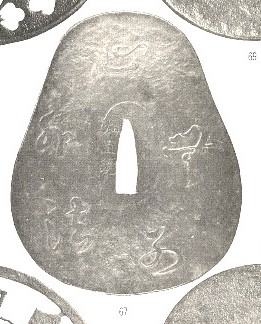 |
Return to the Table of Contents
Large tsuba of thin plate with simple perforations are
commonly called armorsmith tsuba, though there is no proof that the were
actually made by the ancient armorers. It is more likely that they are the
work of the earliest professional tsuba makers, though their individual
identity is unknown. Examples date from about 1350 to 1900.
-
Unsigned. Rare example of the early Muromachi (1425)
style of armorsmith tsuba. The shape of the hitsu-ana has been changed
at a later date. This tsuba is certified by Dr. Torigoye Kodo. Thickness
at center 2.75 mm, thickness at edge 6 mm.
-
Unsigned. Typical example of middle Muromachi (1450)
armorsmith tsuba. This tsuba is certified by Dr. Torigoye Kodo. Thickness
at center, 2.5 mm; at edge, 3.75 mm.
-
Unsigned. Rare design of middle Muromachi tachi
armorsmith tsuba. Thickness at center, 2.25 mm; at edge, 3.25 mm.
|
|
68
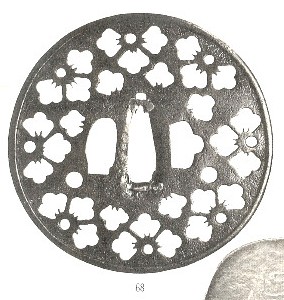
69
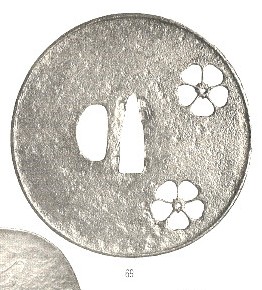
70
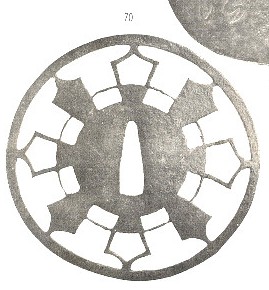 |
Return to the Table of Contents
The genealogy of this family is recorded, though it is
thought to be in error since it is now known that there were several
generations who used the same name, such as Iyesada and Iyetada.
-
Unsigned. A typical early example of the work of this
school. Thickness at center, 2.75 mm; at edge, 4.5 mm.
-
Signed Odawara (no) ju Saotome Iyesada. This tsuba is
considered to be a masterpiece of the Saotome school. It was made about
1625. A gold tag affixed to the ring on the back of the helmet has the
name Fujiwara Morifusa inscribed. This is probably the name of the
owner. Thickness at center, 2.5 mm; at edge, 3 mm.
|
|
71
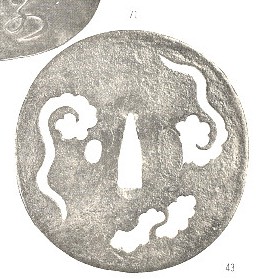
72
 |
Return to the Table of Contents
The artists of this school were students, or followers,
of the Saotome masters. The majority of their work is of common quality;
though in rare cases they created a few noble pieces. Signed work, such as
Yamashiro (no) ju Tempo, Sanada, or Sanoda Tempo, is slightly better than
the average example. This school worked during the Edo period (1600-1850).
|
|
No illustrations.
|
Return to the Table of Contents
The name for this style of tsuba is said to be derived
from a type of lacquer decorated with a similar style of carving, known as
Kamakura-Bori lacquer. There is a theory that a few examples of the tsuba of
this style may actually date from the Yoshino period (circa 1350), though
there is no proof of this at this time. This style of tsuba went out of
fashion in the early seventeenth century. There are no signed examples.
|
|
No illustrations.
|
Return to the Table of Contents
The name for this school style is taken from the Onin era
(1467-68). It is thought that this style of tsuba was made at least fifty
years prior to this date and for a hundred years after. A few examples were
made during the Edo period. Individual artists are unknown and there are no
signed examples.
-
Unsigned. Classic style of brass inlay Onin tsuba,
intended for mounting on a tachi, but later used on a katana. Thickness
3.5 mm.
|
|
73
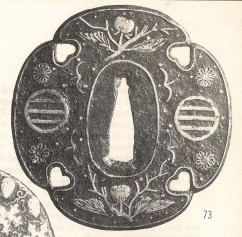 |
Return to the Table of Contents
The name for this school is derived from the area of
which Kyoto is the center. The individual artists signed their work in rare
cases, but no family or school seems apparent. The school style is
characterized by the decorative inlay of brass, either flush to the plate
surface, or slightly raised above it, or a combination of the two. Ninety
percent of all brass inlay tsuba are the work of this school which was
active from about 1450 to 1850.
-
Unsigned. Classic style of brass inlay Heianjo tsuba.
Circa 1580. Thickness at center 5 mm.
-
Unsigned. Later work of this school, circa 1700.
Flush inlay of brass, copper, and silver. A masterpiece of this type.
Illustrated in the de Haviland collection catalogue, page 53, number 29. Thickness
at center, 4 mm; at edge, 3 mm.
-
Unsigned. Brass inlay style of about 1600. Good
example of pictorial style. Thickness at center, 3.5 mm; at edge, 4.75
mm.
|
|
74

75Not illustrated.
76
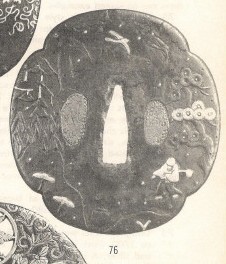 |
Return to the Table of Contents
In addition to the above two schools there were the Kaga
and Koike Yoshiro schools of brass inlay style. A few members of the Koike
school moved to Okayama in Bizen. They worked there for a few generations
during the Edo period. The Kaga school extended through the entire Edo
period.
-
Unsigned. Kaga crest inlay style of the earliest
type, very rare. This tsuba is certified by Dr. Torigoye Kodo. Thickness
3.25 mm.
-
Signed, Izumi (no) Kami Yoshiro Koike Naomasa. One of
the masterpieces by this artist. This tsuba is certified by Dr. Torigoye
Kodo. Thickness at center, 4 mm; at edge, 3.5 mm.
-
Signed, Yoshiro saku. A typical example of the Bizen
Yoshiro school. Illustrated in the Mosle collection catalogue, number
470. Thickness at center 4.25 mm.
|
|
77

78
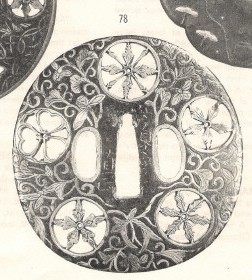
79Not illustrated. |
Return to the Table of Contents
This school had a parallel development to the Heianjo
brass inlay school. By the seventeenth century, the two schools were
completely integrated. The early style of this school is characterized by
designs in bold positive openwork with occasional sparse brass inlay. A few
signatured examples exist but they seem to be independent artists.
-
Unsigned. Earliest style of this school. There are
three brass dots of inlay on the face and two on the reverse side. Thickness
3.5 mm.
|
|
80
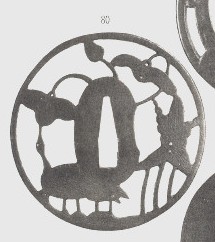 |
Return to the Table of Contents
The development and growth of the Kyoto openwork school
was parallel to, but slightly later than, the Heianjo openwork school. Its
beginning was about 1550 and it reached its peak by 1580. The style was made
until late in the Edo period; but the quality was in continuous decline
during this time. The Daigoro school was a branch development of the Kyoto
openwork school shortly after 1700. Their style gave new impetus to the then
stagnant designs of the parent school.
|
|
No illustrations.
|
Return to the Table of Contents
Kaneiye tsuba may be divided into many classes. First are
the few extant examples by the first master, who signed Joshu Fushimi (no)
ju Kaneiye. Then there are the examples by the first artist, who signed
Yamashiro Kuni Fushimi (no) ju Kaneiye. In addition there are a few signed
and unsigned examples made by students and followers of the second artist.
Next there is the Saga Kaneiye school work. These are the work of the later
followers after the school had moved to Saga in Hizen. They were made from
1600 to about 1850. In addition to the Saga style, there are numerous
examples made at Aizu or on the docks at Yokohama as imitations for sale in
Tokyo or to the foreigners. These imitations of the Saga style comprise more
than eighty percent of the existing signed or unsigned Kaneiye tsuba.
-
Signed Yamashiro Kuni Fushimi (no) ju Kaneiye. A fine
example of the earliest student work, about 1625. The quality of the
inlaid gold and the iron plate are both excellent. This tsuba is
illustrated in the G. H. Naunton Collection catalogue (1912), plate XI
number 21. Thickness at center, 3.75 mm; at edge, 4.25 mm.
-
Unsigned. Early example in Saga style employing a
design found on the work of the first and second Kaneiye. Thickness at
center 4.25 mm.
|
|
81 Not illustrated.
82
 |
Return to the Table of Contents
Tsuba signed with the name Nobuiye are rather common.
They may be divided into the following types: the first and second Nobuiye
who lived during Momoyama to early Edo period (1550-1625); the dozen or so
artists who used this name from 1625 to 1850 and worked in various
provinces, such as Kaga, Kozuke, and Akasaka; the many forgeries in the
style of the first Nobuiye made by Iwata Norisuke (first and second) and
lesser imitators, who cashed in on the revival of the Nobuiye style about
1850. These forgeries account for the majority of the Nobuiye tsuba that are
seen today.
-
Signed Nobuiye. A typical example of the work of the
first master, about 1575. The carving of the design is very delicate and
the edge and feeling of the plate surface show the taste of this period.
Illustrated in the Tsuba Geijutsu Ko, top of page 35. This tsuba is
certified by Dr. Torigoye Kodo. Thickness at center, 2.5 mm; at edge,
4.5 mm.
-
Signed Nobuiye. A Typical example of the work of the
second master, about 1600. Shows the power and strength usually to be
found in the work of this artist. This tsuba is certified by Dr.
Torigoye Kodo. Thickness at center, 4 mm; at edge, 5.5 mm.
|
|
83 Not illustrated.
84
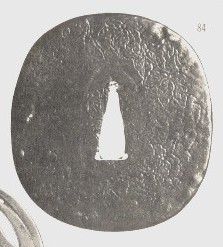 |
Return to the Table of Contents
There are no known examples of tsuba by Myochin masters
signed with the family name that were made before the early Edo period.
After 1700, tsuba by this school were made in great quantities and followed
the style of various prevailing schools of the later Edo period. One cannot
say there is a typical Myochin style. The quality of the later work of this
school is rather common.
-
Signed Myochin Ozumi (no) Kami Ki Muneto. This is the
second generation of this name, worked about 1750. In the family
genealogy he is listed as the twenty-sixth master. This is a fine
example of later Myochin work and shows this school at its best during
the later Edo period. Thickness at center, 5.25 mm; at edge, 7 mm.
|
|
85
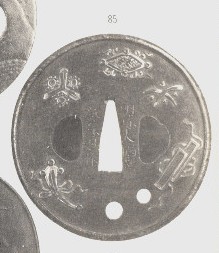 |
Return to the Table of Contents
Authentic examples by the first two masters of this
school are very rare, though forgeries of their work may be found by the
dozens, most of which were made by the first and second Iwata Norisuke, (at
least the better ones were). This school of Owari province particularly
appealed to the samurai class. Tsuba of this school are usually signed.
-
Signed Yamakichibei. An excellent example dating
about 1600. The shakudo inlay and rim were added at a later date. Thickness
at center 3 mm.
|
|
86 Not illustrated.
|
Return to the Table of Contents
The first examples of this style of tsuba were made
during the period from 1450 to 1550. The second period of production is from
1550 to about 1625. The third period, consisting mainly of imitations of the
first periods, extends from 1625 to about 1800, then the style disappeared.
The majority of the extant examples are from the third period.
-
Unsigned. Rare example of the early work of the
second period, dating about 1550. This tsuba is certified by Dr.
Torigoye Kodo. Thickness at center, 4.5 mm; at edge, 6 mm.
|
|
87
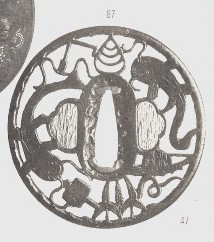 |
Return to the Table of Contents
The style of this school is very difficult to define. The
early work resembles that of the Yamakichibei school; but after the third
generation the style became mixed with that of other schools. The only
characteristics of the school are thick plate and many examples with acid
etched designs. The Hoan divided into several groups and at least two of
these moved from Owari province to start new branch schools.
|
|
No illustrations.
|
Return to the Table of Contents
There were several independent small groups who worked in
the Owari area in addition to the three schools mentioned above. The first
and second Sadahiro were independent artists whose work is almost invariably
of good quality and shows fine treatment of the iron plate, with strong
decoration, and small amounts of inlay.
-
Signed Sadahiro. A typical example of the first
master. This tsuba is certified by Dr. Torigoye Kodo. Thickness at
center 4 mm.
|
|
88
 |
Return to the Table of Contents
Little is known of the artists who signed Nara Kaji,
except their names, and the approximate period in which they worked. The
best examples show a strong resemblance to good Owari style work, rather
than Nara style. Examples of this school are exceedingly rare.
-
Signed Nara Kaji Iyekuni. This is a good example by
the best artist of this school. Date about 1600. Thickness at center, 4.75 mm;
at edge, 5.5 mm.
|
|
89
 |
Return to the Table of Contents
The style of tsuba made by this Owari school was very
popular with the samurai as early as the middle of the Muromachi period
(1450). This popularity continued until late in the Edo age. First period
examples date from 1450-1550. Second period examples date from 1550-1650.
Third period examples, after 1650, are imitations of the first two periods.
-
Unsigned. Good example of the late second period
style, about 1600. Thickness at center 6 mm.
|
|
90
 |
Return to the Table of Contents
The Yagyu style did not appear until the middle of the
Edo period (1750). It was very popular for about one hundred years.
Originally the designs used for these tsuba were thirty six in number
(san-ju-roku kasen); later this number was expanded to more than a hundred
and fifty designs. There were also imitations made by other schools in the
Owari area.
-
Unsigned. Typical example of classic style of this
school. Thickness at center 6.25 mm.
|
|
91
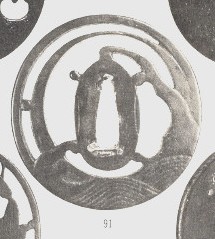 |
Return to the Table of Contents
The date of origin of the first mirror maker tsuba, of
cast bronze, is not known. At this time the date is fixed as about 1400 or
slightly earlier. Examples of Yamagane plate were made until the early Edo
age. Examples in brass were made from 1600 to about 1750.
-
Unsigned. Cast bronze with center pattern resembling
those used on very early bronze mirrors, dating about 1400. This tsuba
is certified by Dr. Torigoye Kodo. Illustrated in the Tsuba Geijutsu Ko
bottom of page 17. Thickness at center, 2 mm; at edge, 3 mm.
-
Unsigned. Cast bronze with pictorial style of design.
Excellent example of this type. Date about 1450. Thickness at center, 2.75 mm;
at edge, 4.75 mm.
|
|
92 Not illustrated.
93
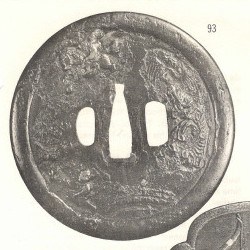
|
Return to the Table of Contents
Tsuba and other mountings made by these artists date for
the most part from the middle of the Muromachi period (1450). They were
continuously made for the next three hundred years; but the quality steadily
declined.
-
Unsigned. Shakudo plate with sheet gold inlay on
flower pattern. The style resembles the iron plate tsuba of about 1450,
when this tsuba was made. The tsuba is certified by Dr. Torigoye Kodo. Thickness
at center, 3 mm; at edge, 7.5 mm.
-
Unsigned. Solid silver plate with stamped raised dot
surface (nanako) deeply carved flower design. The edge covered with
scroll work in line carving. The hitsu-ana are typical of this style and
the period (about 1450). This tsuba is certified by Dr. Torigoye Kodo. Thickness
at center, 4 mm; at edge, 4.5 mm.
-
Unsigned fuchi-kashira. Tachikanagu-shi style of
1450. Yamagane plate with inlay of copper and silver.
-
Unsigned menuki. Yamagane plate, no inlay.
Tachikanagu-shi style, about 1400.
|
|
94
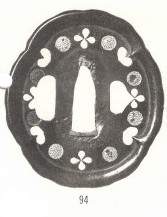
95
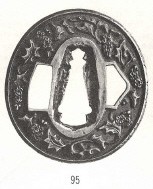
96
 
97
  |
Return to the Table of Contents
Tsuba of this type were made by unrecorded artists who
worked in the period from 1400 to 1600. Some were students of the Goto
school and there is an uncertain relationship to the later Kinko schools
which developed from these earlier styles.
-
Unsigned. Shakudo plate with carved wave design. The
rim is brass and the only one of its kind known; date about 1400. This
tsuba is certified by Dr. Torigoye Kodo. Thickness at center, 2 mm; at
edge, 5mm.
-
Unsigned. Shakudo plate with raised dot surface (nanako);
made about 1450. Typical example of Ko-Kinko work of Goto derivation. Thickness
at center, 4.5 mm; at edge, 5 mm.
-
Unsigned fuchi-kashira. Ko-Kinko style of 1450.
Shakudo nanako plate with gold inlay.
|
|
98
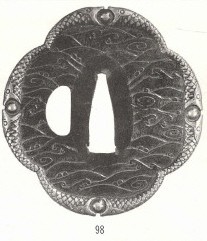
99
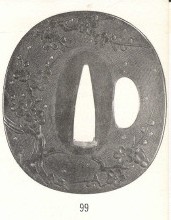
100
  |
Return to the Table of Contents
The Goto developed in Mino province during the Muromachi
period (ca. 1400). Goto Yujo (1440-1512) and his followers were the main
line of this school after moving from Mino to Kyoto about 1460. The Kyoto
school became the dominant group and gave birth to the many branch schools
of the Edo period. The Kaga school was independent of the Kyoto school
during the Edo period.
-
Unsigned. Shakudo plate with gold decoration dating
about 1650. A typical example of the Mino Goto school. Thickness at
center 3.25 mm.
-
Unsigned fuchi-kashira. Mino Goto style, about 1675.
Shakudo plate with gold surface over deep carving.
-
Signed Teitogu (resident of the capital) Masaoki
(Goto Seijo III), with gold seal: Homeido. Shakudo plate with surface
decoration in imitation of Portuguese stamped leather. The third Seijo
lived from 1747 to 1814. Illustrated in the Mosle Collection catalogue
number 382. Thickness at center 4.75 mm.
-
Unsigned kogai. Attributed to Goto Kojo (1529-1620),
fourth master of main line, first son of third master, Joshin. In this
example, Kojo was imitating the style of the first Goto master, his
great-grandfather Yujo (1440-1512). This kogai is certified by Dr.
Torigoye Kodo. Total length 21.1 mm.
-
Signed Yamazaki Ichiga and kao. Worked about 1750.
Shakudo nanako plate with inlay of gold, copper and silver. Ichiga is
thought to be a student of the twelfth main line, Jujo (1695-1742). Thickness
at center, 2.5 mm; at edge, 3.75 mm.
-
Menuki signed Yamazaki Ichiga and kao (ca. 1750).
Shakudo with gold and silver inlay.
-
Signed Goto Mitsuyoshi (Shinjo) 1783-1834, fifteenth
master of the main line. First son of the fourteenth master, Keijo (died
1804). Shibuichi plate, flat inlay of gold, copper and silver with
surface carving. Design signed, "from a painting by Norinobu." The style
of this piece was made popular by Hosono Masamori about 1700. This
example is superior to Masamori workmanship. Illustrated in the Mosle
Collection Catalogue number 267. Thickness at center, 4.5 mm; at edge, 2
mm.
-
Unsigned. Shakudo plate with flush inlay of copper
and gold. Typical example of old Kaga Goto school work, about 1650. Thickness
at center 4 mm.
-
Fuchi-kashira signed Yanagawa Naomasa, 1692-1757. The
second son of Masatsugu and student of Yokoya Somin I (1670-1733).
Contained in box certified by Kuwabara Yojiro and with certificate paper
from Nihon Bijutsu Token Hozon Kyokai of the Marutoku grade (green
paper). Illustrated in The Samurai Sword Handbook (1958) page 88.
-
Signed Yanagawa Sairenko. Unrecorded name but
probably that of one of the leading masters of the Yanagawa school,
about 1750. Shakudo nanako plate with heavy gold border. Thickness at
center 4.5 mm.
-
Signed Omori Teruhide and dated 1777 (1730-1798). The
adopted son of Terumasa. The third member of the Omori family. Shakudo
plate with undercut wave design. Thickness at center 4.5 mm.
|
|
101
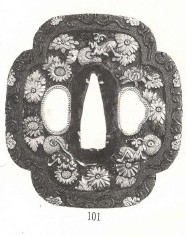
102
 
103
Not illustrated.
104

105
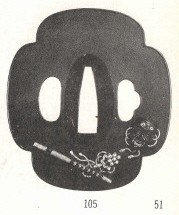
106
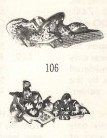
107
Not illustrated.
Possibly found in the Mislabeled section below.
108

109
Not illustrated.
110
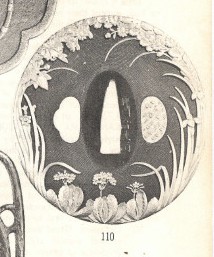
111
 |
Return to the Table of Contents
During the Edo period the Mito area became one of the
largest centers of production of various styles of tsuba. The majority of
the schools and independent artists made mass production pieces of
stereotype designs that may be seen in vast quantities. A few masterpieces
were produced despite the general mediocrity of the work of this area.
-
Signed Mito ju Tsuju saku (1698-1768). Student of
Gunji Koami and Nara Toshinaga I. The design and style would indicate
that this piece is either a copy or in the style of the first Toshinaga.
It is considered to be the masterpiece of this artist. This tsuba is
certified by Dr. Torigoye Kodo. Thickness at center 4.5 mm.
|
|
112
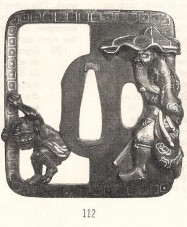 |
Return to the Table of Contents
The first Yasuchika is considered to be one of the three
great Nara masters (Nara San-saku), with Nara Toshinaga and Sugiura Joi. the
style of Yasuchika owed more to his heritage in Shonai as a student of the
Shoami than to his tenuous relationship with Toshinaga and Joi.
-
Signed Yasuchika (1670-1744). Iron plate with inlay
of shakudo, gold and silver. A brass plate tsuba with this subject has
been known in Japan for many years. This iron example was only recently
discovered and is considered to be one of the masterpieces by the first
Yasuchika. Thickness at center, 4.25 mm; at edge 5 mm.
-
Signed Kikan. This is Noda Kikan (ca. 1700). Until
recently only two or three examples of the work of this artist were
known to exist, such as the famous tsuba with snake design in the
Furukawa Collection, number 194. In the last few years, a few additional
examples have been discovered, leading one expert to believe there were
several generations of this name. Thickness at center 5.5 mm.
-
Signed Morichika. This is a student of Tsuchiya
Yasuchika VI (ca. 1835). Kozuka copper plate with inlay of shakudo and
gold. Illustrated in the G. H. Naunton Collection catalogue,
plate L number 1260.
|
|
113

114

115Not illustrated. |
Return to the Table of Contents
The Nara workers were master decorators in the Goto style
in their early development. To distinguish their work from that of the Goto
school, they chose to inlay their decoration on iron plate rather than on
soft metal plate. The best of their work in this style will have inlay of
Goto quality on iron plate of superior forged and hammered texture.
-
Unsigned. Typical example of the early Edo age
(1625). Inlay of shakudo, gold and silver on iron plate that resembles
Owari work. Illustrated in Legend in Japanese Art, opposite page
126 (bottom left hand corner). Thickness at center, 4.75 mm; at edge 6
mm.
-
Unsigned. Rare example with poem carved on iron plate
mentioning the exploits of Toyotomi Hideyoshi (1536-1598) in Korea.
Seems to have been made shortly after the death of Hideyoshi.
Illustrated in the Transactions of the Japan Society of London,
Volume 15, plate III, number 16. Thickness at center, 4 mm; at edge, 3.5
mm.
-
Signed Fujinaka Bensuke (ca. 1700). Inlay of copper,
gold and shakudo. Illustrated in the Mosle Collection Catalogue number
591. Thickness at center, 6.5 mm; at edge 5.25 mm.
-
Fuchi signed Toshinaga and kao. Brass plate with
inlay of silver, shakudo and gold. This is the first Toshinaga
(1667-1737).
|
|
116 Not illustrated.
117
Not illustrated.
118
Not illustrated.
119
  |
Return to the Table of Contents
The Hamano artists seem to have branched from the Nara
school. Some examples that are now labeled Ko-Nara are in fact Ko-Hamano
work. This school was very extensive and during the Edo period produced
readily identifiable examples of better than average quality for the most
part.
-
Signed Miboku. Most probably an early example of the
work of Hamano Shozui (1696-1769) while he was a student of Nara
Toshinaga I. The eyes are inlaid gold and shakudo; the earrings are
silver. This tsuba is certified by Dr. Torigoye Kodo. Thickness at
center, 3.75 mm; at edge, 3 mm.
-
Kozuka signed Hamano Hiroyuki (ca. 1780). Illustrated
in the Mosle Collection catalogue, number 1017.
-
Kozuka signed Hamano Yasuyuki and seal (1763-1937).
Illustrated in Mosle Collection catalogue, number 1028.
-
Kozuka signed Hamano Haruyuki (ca. 1825). Illustrated
in Koji Hoten, plate XLIV.
|
|
120
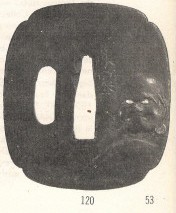
121Not illustrated.
122
Not illustrated.
123
Not illustrated. |
Return to the Table of Contents
The origin of this school is unknown. It is now thought
that they were a branch of the Ko-Shoami school who broke away sometime in
the late Muromachi period (about 1550). The earliest work that bears a
signature are those pieces signed Mitsutada. In the past it had been thought
that Myoju was the founder of this school; but his true position is not
known. He may have founded one style as a branch of the main school.
-
Signed Mitsutada (ca. 1550). Brass plate with gold
and silver inlay (nonome) decoration. Thickness at center, 3mm; at edge,
6.5 mm.
-
Signed Umetada Shichiza (about 1750). It is not known
which generation of this name produced this piece. Inlay of silver and
gold. Thickness at center, 3.75 mm; at edge, 3.5 mm.
|
|
124
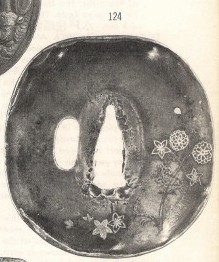
125
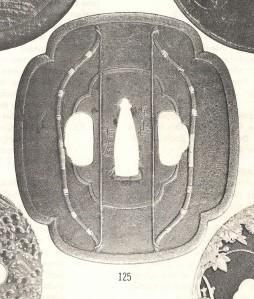 |
Return to the Table of Contents
The name Shoami (which may be translated, "true, or
original, men of the arts") is the oldest family name we have recorded who
were professional tsuba makers. The origin of this family is unknown but
they have left unsigned examples in armorsmith style that date about 1450.
The first signed examples do not appear until early in the Edo period
(1625). At that time the school dispersed from Kyoto to many of the
provincial capitals, from Hiroshima to Dewa. There are several hundred
recorded artists in this school.
-
Unsigned. Awa Shoami work of one of the first three
generations. Brass plate with inlay of gold and copper. This school did
not work on iron plate until after the fifth generation. Thickness at
center 3.5 mm.
-
Unsigned. Early Bizen Shoami style, without inlay,
about 1650. Shows power and strength of provincial Shoami work. Thickness
at center, 4.25 mm; at edge, 4.75 mm.
-
Unsigned. Shonai Shoami, copper plate with shakudo
inlay, early example about 1650. Quality of plate resembles the surface
of iron. Thickness at center, 5 mm; at edge, 3.75 mm.
-
Unsigned. Work of Shonai Shoami Kiyonari (ca. 1700).
Student of Shoami Yoshihisa. Illustrated in Shonai Kino Shu,
number 29 (ex. Ichibara Heisaburo collection). Thickness at center 4.75 mm.
-
Unsigned. Hiroshima Shoami style about 1700. There
are no signed examples of this branch of the Kyoto school but their work
resembles the style of Bizen Shoami school. Thickness at center 5 mm.
-
Signed Shoami (ca. 1750). Work of Aizu Shoami Ikko.
Good typical example. Thickness at center, 3.25 mm; at edge, 4.2 mm.
-
Fuchi-kashira signed Sanshu ju Shoami Nobuiye (ca.
1750). The work of this artist is very rare. He made a few tsuba that
resemble the work of the first Nobuiye. Illustrated G. H. Naunton
Collection catalogue, plate XVIII, number 260.
-
Fuchi-kashira signed Matsuyama Shoami Moritomi (ca.
1700). Shakudo plate with gold inlay. Iyo Shoami school.
|
|
126

127

128
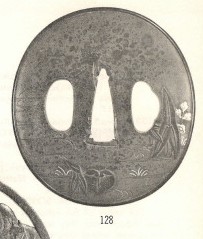
129

130
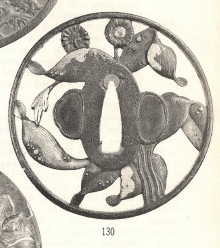
131
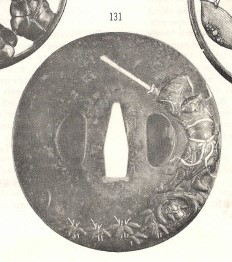
132Not illustrated.
133
   |
Return to the Table of Contents
The Akasaka were students of the Kyoto openwork school
who moved to Akasaka in Edo, about 1625. They were under the employ of
Kariganeya Hikobei, a shop owner and artist, who created the designs and a
few pieces. This school had many students and flourished until the end of
the Edo period.
-
Unsigned. Typical example of the work of Akasaka
Kariganeya (ca. 1600). His work is very rare. This tsuba is certified by
Dr. Torigoye Kodo. Thickness at center, 4 mm; at edge, 6.5 mm.
-
Signed Bushu (no) ju Akasaka Tadanori. Very good
example in later Akasaka style, about 1700. Thickness at center 4.5 mm.
|
|
134
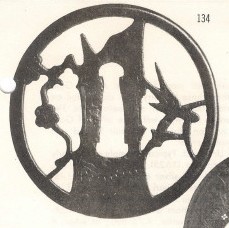
135
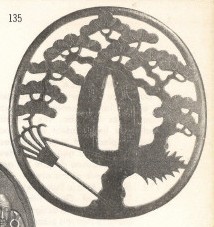 |
Return to the Table of Contents
The Kinai school in Echizen originated early in the Edo
period. There are eight recorded generations, all of whom signed "Echizen
(no) ju Kinai." Extant examples of the first Kinai are almost nonexistent,
though the later work of this school is very common.
|
|
No illustrations.
|
Return to the Table of Contents
Though the true origin of this artist is unknown, it
seems obvious from his style of work that he was a student of the Tachi
fittings makers of the late Muromachi period. When he moved to Higo
province, under the patronage of Hosokawa Tadaoki (1564-1645), he became the
teacher of the first Nishigaki and the senior artist of the Higo group.
-
Unsigned. Yamagane plate with shakudo Odawara style
of rim cover. Excellent example of the first Hikozo. He died in 1635.
This tsuba is certified by Dr. Torigoye Kodo. Illustrated in Tsuba
Geijutsu Ko, bottom of page 62. Thickness at center, 4.25 mm; at
edge, 5 mm.
|
|
136 Not illustrated.
|
Return to the Table of Contents
It has been stated that Matashichi came from Owari to
work for Hosokawa Tadaoki. The quality of his iron plate and the designs he
employed would indicate that his origin was more likely from Kyoto, rather
than Owari. He is the most renowned artist of the Higo group. The Hayashi
family extended through eight generations.
-
Unsigned. Typical example of Hayashi Matashichi
(1613-1699). He is thought to have been the originator of this plum
branch design. Certified by Dr. Torigoye Kodo. Illustrated in Tsuba
Geijutsu Ko, bottom of page 67. Thickness at center, 6 mm; at
edge, 5.5 mm.
-
Signed Hayashi Matahei and dated April, 1810. Fifth
master of Hayashi family. Very rare signed and dated example. Thickness
at center, 5 mm; at edge, 4.5 mm.
|
|
137 Not illustrated.
138
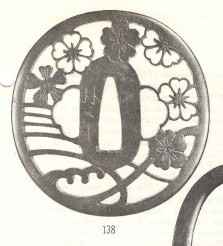 |
Return to the Table of Contents
The first Nishigaki Kanshiro (Yoshihiro) was a student of
Hirata Hikozo; but he owes his style more to Matashichi than to Hikozo.
There were eight generations of this family. The later generations were
students of the Kumagai school of Higo.
-
Unsigned. Example of the first Nishigaki Kanshiro
(1613-1693). This is a very early example of his work. Certified by Dr.
Torigoye Kodo. Thickness at center, 5.5 mm; at edge, 5 mm.
-
Unsigned. Typical example of the first Kanshiro. This
tsuba is certified by Dr. Torigoye Kodo. Illustrated in Tsuba
Geijutsu Ko, bottom of page 72. Thickness at center, 5.25 mm; at
edge, 4.5 mm.
-
Unsigned. Brass plate example of the first Kanshiro.
This wave design was originated by Hirata Hikozo; but the waves are more
vertical. Certified by Dr. Torigoye Kodo. Illustrated in Tsuba
Geijutsu Ko, top of page 74. Thickness at center, 4.5 mm; at edge,
3.5 mm.
-
Unsigned. Typical example of the second Kanshiro
(1639-1717). This design was borrowed from the Hayashi school. Certified
by Dr. Torigoye Kodo. Thickness at center, 5.75 mm; at edge, 5.25 mm.
-
Unsigned. Typical example of the second Kanshiro. Thickness
at center, 5.5 mm; at edge, 5.25 mm.
-
Signed Nishigaki Kampei at age 73 (ca. 1675). Kampei
was the brother of the second Kanshiro. Typical example of his later
work. Thickness at center, 5 mm; at edge, 4.25 mm.
-
Unsigned. Later Kanshiro style, copper plate, gold
covered, with raised inlay of shakudo, gold and silver. Rare style. Thickness
at center, 3.75 mm; at edge, 3.5 mm.
-
Unsigned fuchi-kashira. Higo work of Kanshiro school
about 1700. Shakudo plate.
|
|
139
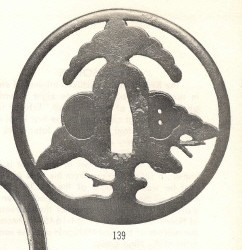
140Not illustrated.
141
Not illustrated.
142
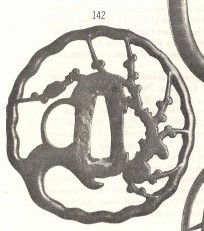
143

144
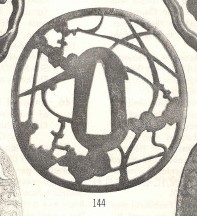
145
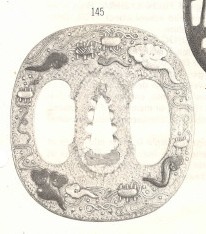
146
  |
Return to the Table of Contents
Shimizu Jingo I lived at Yatsushiro (often misread Hachi
Dai, 8th generation), as did the succeeding generations. The style of the
first two Jingos owes a great deal to the brass inlay Heianjo school of
Kyoto and no doubt the first Jingo was a student, or member, of that school.
This school also did damascene inlay (nunome) work.
-
Unsigned. Eagle in brass inlay style of second Jingo
(ca. 1650). Thickness at center, 5 mm; at edge, 4.5 mm; inlay thickness,
2 mm.
|
|
147
 |
Return to the Table of Contents
There were four members of this school. The work of the
first, Masatada (1766-1820), is unsigned and very rare. The work of the
second, Fukanobu (1798-1851), is competent and rather common. The third
master, Rakuju Masayasu (1817-1884), was an exceptional artist in nearly
every style. His best work is considered second only to that of Hayashi
Matashichi. The younger brother of Rakuju, Chuhachi (died 1886) made a few
tsuba in the style of his brother.
-
Unsigned. Typical example of Rakuju style of gold
inlay on iron plate. Thickness at center 4 mm.
|
|
148
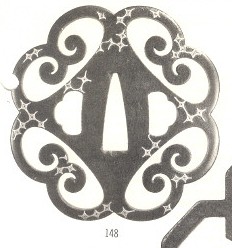 |
Return to the Table of Contents
There were a number of smaller schools and many
independent artists working in Higo province through most of the Edo period.
The most important of these are: the Toyama family, Nakane Heihachiro,
Miyamoto Musashi, Manichibo, the Suwa family, Misumi Koji, Kumagai, the
Tsuboe school, and the Edo Higo.
-
Unsigned. Typical example of tsuba style, yamagane
plate, of Miyamoto Musashi 9ca. 1590). Thickness at center, 4.75 mm; at
edge, 4.5 mm.
-
Signed Kushu Higo (no) ju Toyama saku (ca. 1620).
Rare example with crest of Hosokawa family. Illustrated in the Mosle
Collection catalogue, number 842. Thickness at center, 5.25 mm; at edge,
4.75 mm.
-
Signed Yatsushiro Shi (samurai of Yatsushiro) Sadayei
saku (ca. 1700). Illustrated in Legend in Japanese Art, opposite
page 76, top left hand corner. Thickness at center, 5.25 mm; at edge,
4.75 mm.
-
Signed Suwa Katsumasa at age 75 (ca. 1850). This
probably is the work of the last Suwa master, Daisaku. gold inlay of
broken twig design, openwork of Hosokawa crest. Thickness at center 4.75 mm.
-
Unsigned. Good example of the work of Kumagai
Yoshiyuki (ca. 1830). Thickness at center, 5.25 mm; at edge, 4.5 mm.
|
|
149
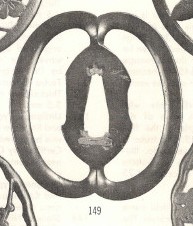
150Not illustrated.
151
Not illustrated.
152

153
 |
Return to the Table of Contents
Ko-Hagi tsuba (meaning tsuba of early Choshu style) are
in reality Kyoto openwork tsuba and have only a tenuous relationship to the
old Choshu style. Tsuba of this design were made during the entire Edo age.
-
Unsigned. Early example (1625) of typical "Ko-Hagi
tsuba." Thickness at center, 4.5 mm; at edge, 5.5 mm.
|
|
154
 |
Return to the Table of Contents
There were many families of tsuba artists living in
Choshu province. The Kawaji, Nakai, Okamoto, Okada, Nakabara, Inouye, Yaji,
Kaneko, Itoga, in addition to a number of lesser schools and independent
artists. The best examples of their work are excellent; but the majority are
very common.
-
Signed Nagato Kuni Hagi ju Nakai Zensuke Tomotsune
(1669-1723). Excellent example by the first master. Illustrated in the
G. H. Naunton Collection catalog plate XXXV, number 872. Thickness
at center 4.5 mm.
-
Signed Nagato Kuni Hagi ju Umetada Nobushige
(1660-1722). Third master of Okada family. Thickness at center 4.25 mm.
-
Signed Matsudai (ni) Kore (wo) Kosu (made by the last
of the family). Example of last member of the Okamoto family, rare
signature. Illustrated in the G. H. Naunton Collection catalog
plate 37, number 902 (ca. 1875-1900). Thickness at center, 5.5 mm; at
edge, 5 mm.
|
|
155 Not illustrated.
156
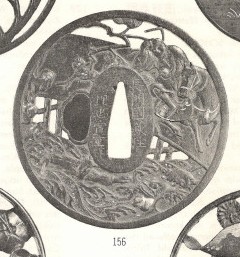
157
Not illustrated.
|
Return to the Table of Contents
There were several schools and independent artists
working in the Sendai area. The two most important of these are Sendai
Kiyosada and Sendai Zembei.
-
Signed Sendai (no) ju Kiyosada (ca. 1775). Shakudo
plate with flat gold inlay. Illustrated in Mosle Collection catalog,
number 154, and in Koji Hoten, figure 837. Thickness at center 4.25 mm.
-
Unsigned. Gold and shakudo inlay on iron plate.
Excellent example of the work of Sendai Zembei. This tsuba is certified
by Dr. Torigoye Kodo. Illustrated in J. C. Hawkshaw Collection
catalogue plate XXVII, number 1507 (erroneously attributed by H. L. Joly
as Kyoto work). Thickness at center 5 mm.
|
|
158 Not illustrated.
159
Not illustrated.
|
Return to the Table of Contents
The first master is recorded as working in armorsmith
style. The later generations tended to follow the styles that were popular
during their respective periods.
-
Unsigned. Style of first Suruga (ca. 1625). Note
copper plugs at top and bottom of central opening, typical of this
school. Thickness at center, 3.25 mm; at edge, 4 mm.
|
|
160
 |
Return to the Table of Contents
In addition to the Shoami of Shonai, a number of other
schools and independent artists worked in the Dewa area. Two of the best
masters were Ikeda Kazutsugu and Katsurano Sekibun, first and second.
-
Signed Shonai (no) ju Ikeda Kazutsugu (ca. 1850).
Typical example of this artist's work. Illustrated in Shonai Tsuba Shu,
number 205 (ex. Ito Kozo collection). Thickness at center, 6.5 mm; at
edge, 9 mm.
-
Signed Yurakusai Sekibun (ca. 1870). Rare example of
design taken from a famous tsuba by the first Yasuchika. Thickness at
center 3.75 mm (slightly cupped shape).
|
|
161 Not illustrated.
162
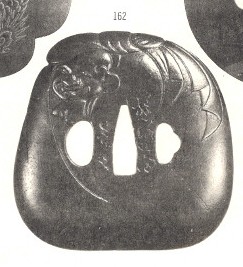 |
Return to the Table of Contents
-
Signed Horai (ca. 1750). This design is associated
with this school of country smiths. Thickness at center 4.75 mm.
-
Signed Yasaka Eikan (ca. 1775). Gold inlaid edge,
large example. Thickness at center, 5.25 mm; at edge, 5.75 mm.
|
|
163
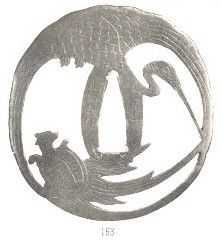
164
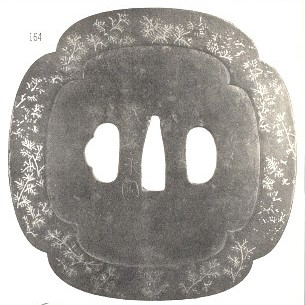 |
Return to the Table of Contents
The true story of Soten style tsuba is unknown; but it
can be said that better than 95% are later work in imitation of what must
have been one style made during the lifetime of the first and second Soten.
Most of these imitations were either made in Kyoto by the Hiragiya school,
at Aizu by the Shoami school, or at the docks of Yokohama intended fro sale
to the Europeans and Americans.
|
|
No illustrations.
|
Return to the Table of Contents
Sahari is a very hard alloy that was originally used as a
decorative metal inlay on gun barrels. It was applied later by the Kunitomo
family and the Hazama workers to the decoration of tsuba on either iron
plate or soft metal plate.
-
Signed Seishu Kameyama (no) ju Sadahide saku (ca.
1700). Sahari inlay on iron plate, very fine example. Thickness at
center 5.5 mm.
-
Signed Hazama (ca. 1700). Typical example of this
style of Sahari inlay on iron plate. Thickness at center 4.25 mm.
|
|
165
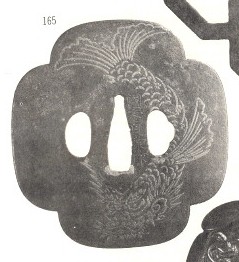
166Not illustrated. |
Return to the Table of Contents
Early examples of Hirata gold Shippo (cloisons of gold
wire) with translucent enamel paste are very rare. The majority of the
extant cloisonné fittings were made in the 19th century for export purposes,
either incorporating old iron plates or using contemporary plates made by
other artists.
-
Unsigned. Style of Hirata Narikazu, second master
(died 1652). Gold wire cloisonné, inlay of green background with red,
purple, white, yellow, and blue. The rim is similarly inlaid. Thickness
at center, 5 mm; at edge, 6.75 mm.
-
Signed Narisuke, seventh master (died 1816). Gold
wire inlay with translucent paste raised above the surface of the iron
plate. Thickness at center 5.75 mm.
|
|
167

168
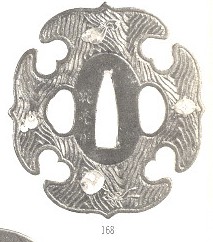 |
Return to the Table of Contents
In the strict sense of the word, Namban should refer only
to those fittings which have foreign subjects, other than Korean and Chinese
(which were not considered to be foreign). Similar tsuba with Chinese
style designs, of symmetrical proportions, are Kanton tsuba. Those with
native subjects, of asymmetrical proportions are Kagonami tsuba. In addition
to these styles, there were several schools at Nagasaki, such as Jakushi,
Mitsuhiro, Kunishige, Umetada of Hizen, and a native inlay school. They
flourished through the entire Edo period.
-
Unsigned. Namban tsuba of old armor smith style
plate. The two crosses were added later, but seem to show age in the
perforations. Thickness at center 3 mm.
-
Fuchi-kashira signed Hirada ju Kunishige (ca. 1725).
Brass plate with gold inlay.
-
Signed Hikone (no) ju Jakushi (ca. 1800). Rim cover
of shibuichi with gold and silver inlay. Illustrated in Behrens
collection catalogue, plate LIV, number 1105. Thickness at center, 5.5 mm;
at edge, 2.5 mm.
|
|
169

170
  
171Not illustrated. |
Return to the Table of Contents
Though the iron plate tsuba artists still exercised their
skill throughout the Edo period, it was the Kinko who dominated the age.
From a slow beginning, as students of the Goto school about 1600, they
expanded to the position where by 1850 nearly every school was obliged to
emulate the soft metal plate or at least to imitate their style. It was the
merchant class who patronized their art and made their style so popular. A
slight revulsion against this opulence was expressed by the revival of the
old spirit of the simple iron tsuba; but this lasted but a few years and was
soon engulfed by an even gaudier style and technical virtuosity that came to
its zenith in the period from 1900 to 1920. This style was more akin to
naturalistic painting in metal, with a full palette of colors and three
dimensional carving. They had lost the spirit and the utilitarian aspects of
the true sword guard; but then, the sword was not intended for use at this
time and these pieces must be admired for their technical perfection. And
thus they brought the age of the tsuba artist to an end.
-
Signed Nomura Masamichi and kao, at 81 years of age
(died 1757). Copper plate, inlay of shakudo and silver. Thickness at
center 4.25 mm.
-
Signed Ozaki Naomasa and kao (died 1782). Iron plate
with inlay of gold, copper and silver in high relief. Thickness at
center 5.25 mm.
-
Signed Ishiguro Masatsune carved this (and) Kato
Naotsune made the nanako. Kato Naotsune (ca. 1750) was the teacher of
Masatsune (1760-1829), the founder of the Ishiguro school. This set of
fittings, with the two signatures is very important and was probably
made while Masatsune was still a student of Naotsune. Thickness of tsuba
at center, 5 mm; at edge, 3.75 mm.
-
Signed Unsansai Hironaga (ca. 1825). Shakudo nanako
plate with inlay of copper, gold and silver. Thickness at center 5.25 mm.
-
Signed Hosono Shazaemon Masamori and kao (ca. 1750).
Illustrated in the Mosle Collection catalogue, number 1306. Thickness at
center 4 mm.
-
Signed Chohan Okatomo Seidai bori, Kenyei and seal
(ca. 1825). Shibuichi plate with inlay of copper, shakudo and silver. Thickness
at center 4.5 mm.
-
Signed Iwamoto Ryokan and kao (ca. 1725). Fourth
master of line and teacher of Iwamoto Konkan. Silver plate with rubbed
gold surface. Illustrated in Mosle Collection catalogue, number 1415. Thickness
at center 4.25 mm.
-
Signed Echizen (no) Daijo Ichinomiya Nagatsune and
kao (1722-1787). Iron plate with high relief inlay of gold, silver and
shakudo. Thickness at center, 3.75 mm; at edge 4.25 mm.
-
Signed Goto Hokkyo Ichijo and kao (1791-1876). Pair
of tsuba (dai-sho). Shakudo plate with stamped surface design. These
tsuba are certified by Amiya Soe (Ogura Soemon). Thickness at center 3.5 mm.
-
Signed Katsuhei at age 76, from a drawing by Icchoshi
(1804-1886). Shibuichi plate with gold, silver and shakudo inlay. Thickness
at center, 4.5 mm; at edge, 5.5 mm.
-
Signed Hagiya Katsuhei and kao (ca. 1900). Shibuichi
plate with shakudo, gold and silver inlay. Son of the above artist. Thickness
at center, 3.75 mm; at edge, 5 mm.
-
Signed Natsuo and kao (1828-1898). Iron plate with
low relief carving and gold inlay. Thickness at center 4.75 mm.
-
Signed Sadakatsu and kao (ca. 1915). Shibuichi plate
with gold, silver, copper, and shakudo inlay. (Door can be opened and
closed.) Thickness at center 5 mm.
-
Fuchi-kashira signed Ishiguro Koreyoshi saku (ca.
1850). Shakudo nanako with inlay of copper, gold, silver, and brass.
-
Fuchi-kashira signed Mitama Joshi (ca. 1775).
Daughter of Murakami Jochiku. Shibuichi with inlay of shakudo and gold.
|
|
172
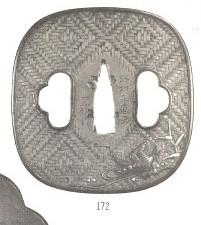
173

174
  
  
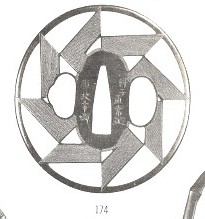
175

176Not illustrated.
177
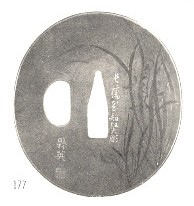
178
Not Illustrated.
179
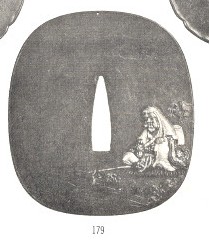
180
 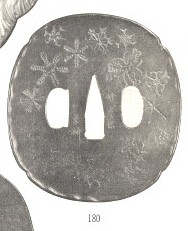
181
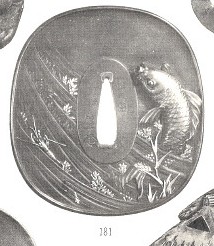
182
 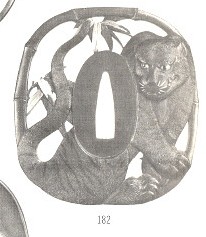
183
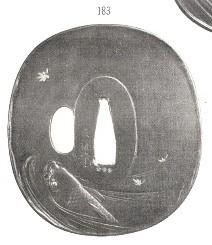
184
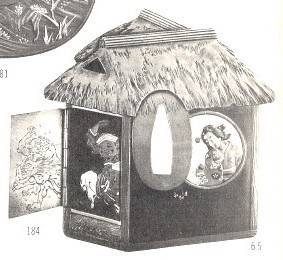
185
 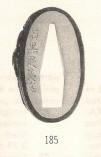 
186
   |
Return to the Table of Contents
Tsuba is labeled at 96; however, item 96 is described as
fuchi-kashira, with appropriate illustrations.
Tsuba is not labeled. Possibly should be item 107.
|
|
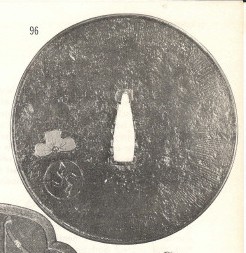
 |
Return to the Table of Contents
The Glossary consists of figures that illustrate the terms
and a vocabulary list.
Return to the Table of Contents
(Hyphens are sometimes used, sometimes omitted, sometimes replaced with blanks.
Some terms are added to those in the catalog.)
ANA: hole.
ARA-NIE: coarse or large nie (see Hada
Patterns above for other patterns).
ASHI: "legs" extending into hamon (see Hamon
Shapes above).
BOHI: straight simple groove.
BONJI: debased Sanskrit characters.
BOSHI: pattern of hamon in point (see Boshi Shapes
above).
CHIKEI (jikei): shining line of martensite in the ji.
CHOJI: clove shaped hamon (see Hamon Shapes above).
CHUKAN ZORI: straight short blade (see Sori above
for other shapes).
CHU-SUGUHA: medium width straight hamon (see Hamon
Shapes above for other shapes).
DAI-SHO: long and short pair of swords, with matching fittings and
sometimes matched blades.
FUCHI-KASHIRA: metal collar around base of hilt & cap of hilt
(see Types of Swords above for illustrations).
FUMBARI: narrowing of blade from hilt to point.
FUNAGATA: boat-shape nakago (see Nakago and Nakago
Tip Shapes above for other shapes).
FUSHI: irregularity in hamon, like knot (see Hamon
Shapes above for other shapes).
FUTATSU JI-BI: double groove along full length of blade.
GOMABASHI-HI: short double groove resembling chop sticks.
GUNOME: repeated series of controlled irregularities in hamon (sambon
sugi) (see Hamon Shapes above).
HA: edge of sword.
HADA (jihada): the figures formed by the juncture of welds in the ji
(see Hada Patterns above).
HA-BUCHI: the area of transition between the ha and the ji.
HA-HADA: figures formed by the juncture of welds in the ji
(see Hada Patterns above).
HAKIKAKE (hakkake): broom-swept pattern in the boshi
(see Boshi Shapes above).
HAKKAKE (hakikake): broom-swept pattern in the boshi
(see Boshi Shapes above).
HAMON: pattern of the tempered edge (see Hamon
Shapes above).
HITATSURA: pattern of the detached areas of hardened steel over entire
blade.
HI: any groove.
HIRA ZUKURI: flat blade without shinogi (see Blade
Shapes above).
HIRO: wide.
HITSUANA: openings on either side of central opening in a tsuba.
HORI: carving.
HOTSURE: an unraveling or looseness of the hamon seen in habuchi
(see Hamon Shapes above).
ICHIMAI-BOSHI: composed entirely of hard steel
(see Boshi Shapes above).
INAZUMA: shining line of martensite in the ha resembling lightning.
ITAME: hada like elongated or irregular wood grain
(see Hada Patterns above).
JI: area between hamon and the shinogi.
JIHADA (hada): the figures formed by the juncture of welds in the ji
(see Hada Patterns above).
JIKEI (chikei): shining line of martensite in the ji.
JI-NIE: nie in the area between the hamon and the shinogi.
JIRI (shiri): tip of the nakago (see Nakago and Nakago Tip
Shapes above).
JI-TETSU: the steel itself, with special reference to its qualities
JUKA-CHOJI: double choji (see Hamon
Shapes above for other shapes).
KAERI: (return) turn-back of the boshi
(see Boshi Shapes above).
KAGONAMI: tsuba with native subjects, of asymmetrical proportions.
KAJI: a smith.
KAKIHAN (or kao): personal carved cipher following the name.
KANTON: tsuba with Chinese style designs, of symmetrical proportions.
KAO (or kakihan): personal carved cipher following the name.
KATANA: long sword of pair, worn edge up
(see Types of Swords above for illustrations).
KATANA MEI: signature on the omote side for a katana
(see Mei (Signature) above).
KAWAZUKO-CHOJI: tadpole shaped choji.
KEN: an ancient, straight, double-edged sword (see Blade
Shapes above for other shapes).
KINKO: "gold workers," artists who made decorative fittings in Edo
period.
KINSUJI: short curved shining line of martensite in the ha.
KISSAKI: the point of the blade.
KO: small - ko-ashi, ko-choji, etc.
KOSHI-BI: short groove in waist of blade.
KO-ZORI: small curvature (see Sori above).
KOSHI-ZORI: large curvature with maximum deviation from straight line
closer to the nakago than to the tip (see Sori above).
KOZUKA: "small hilt," utility knife handle stored in pocket in sheath
(see Types of Swords above for illustrations).
KUICHIGAI-HI: groove of complex form.
MARU: round
(see Boshi Shapes above).
MASA (masame): straight parallel grain
(see Hada Patterns above).
MASAME (masa): straight parallel grain
(see Hada Patterns above).
MATSUKAWA: hada like pine bark
(see Hada Patterns above for other patterns).
MEI: signature (see Mei (Signature) above).
MEKUGI: pin that secures the handle to the blade
(see Types of Swords above for illustrations).
MEKUGI-ANA: holes in nakago for pin that secures the handle to the blade
(see Types of Swords above for illustrations).
MENUKI: metal ornaments on either side of the handle to improve grip
(see Types of Swords above for illustrations).
MIDARE: hamon that is irregular in shape (see Hamon
Shapes above).
MOKUME: hada like burl-grain-wood
(see Hada Patterns above).
MON: family or clan crest or symbol.
MONOUCHI: approximately first 6 inches of blade from the point back.
MOROHA ZUKURI: double edged blade form in tanto (see Blade
Shapes above).
MUNE: back of the blade.
NAKAGO: tang of the blade (inside handle) (see Nakago and Nakago Tip
Shapes above).
NAMBAN: fittings which have foreign subjects, other than Korean and
Chinese (which were not considered to be foreign).
NANAKO: decoration of small raised dots on plate of fittings.
NASHIJI HADA: fine grained hada like the skin of a pear
(see Hada Patterns above for other patterns).
NIE: bright particles of martensite like tiny mirrors in the steel
(see Hada Patterns above).
NIE SAKI: opening in the hamon like a tear.
NIJUBA: double hamon (see Hamon
Shapes above for other shapes).
NIOI: martensite resembling a cloud
(see Hada Patterns above).
NOTARE: hamon of elongated undulations (see Hamon
Shapes above).
NUNOME: damascene inlay of sheet metal fastened to a cross-hatched
ground.
O: large - o-midare, o-choji, etc.
OMOTE: front side of ... . On a sword, this is the side of the blade
that is away from the body when it is worn. This means that the
omote side on a tachi is opposite from that of other swords. The
signature is on the omote (see Mei (Signature)
above).
ORIGAMI: certificate of authenticity.
RENGE: lotus.
SAHARI: alloy of copper-87%, tin-8.3%, lead-4.3%, katashirome-0.4%.
SAN-JU-ROKU KASEN: 36 most renowned poets who lived before 11th century.
SHAKUDO: alloy of nigurome (katashirome and copper) plus 6 to 7% gold.
SHIBUICHI: alloy of copper-60% and silver-40%, to produce best grade.
SHINOGI: ridge line in the flat of the blade, along its length.
SHINOGI ZUKURI: blade form made of three planes (see Blade
Shapes above).
SHIRI (jiri): termination of tang (see Nakago and Nakago Tip
Shapes above).
SORI (zori): curve of the blade (see Sori above).
SOYE-BI: small groove beside long groove.
SUGUBA (suguha): straight hamon (see Hamon
Shapes above).
SUGUHA (suguba): straight hamon (see Hamon
Shapes above).
SU-KEN: single form of ken blade.
SUNAGASHI: nie like pebbles in bed of stream
(see Hada Patterns above).
SURIAGE: shorten. Swords were shortened by cutting off part of the
nakago.
TACHI: long sword, worn edge down
(see Types of Swords above for illustrations).
TACHI MEI: signature on the omote side for a tachi
(see Mei (Signature) above).
TAKE-NO-KO-ZORI: form of blade resembling a bamboo shoot (see Blade
Shapes above for other shapes).
TANAGO BARA: tang shape of belly of the tanago fish (see Nakago and Nakago Tip
Shapes above).
TANTO: very short sword (hunting knife size). Term includes several
shapes.
(see Types of Swords above for illustrations).
TOGARE: pointed configurations in hamon (see Hamon
Shapes above).
TORI-ZORI: large curvature with maximum deviation from straight line
near the center (see Sori above).
TSUBA: metal plate mounted on sword between handle and blade
(see Types of Swords above for illustrations).
TSUKA: handle
(see Types of Swords above for illustrations).
TSURE-BI: small groove following upturn of point on long groove.
UBU: original, unshortened tang.
U-NOKUBI ZUKURI: form of blade shaped as head of cormorant (see Blade
Shapes above).
URA: back side of ... . The other side from omote (see omote above).
UTSURI: faint misty pattern in ji.
UTSUMUKU: straightening of the blade toward the point.
WAKIZASHI: short sword of pair, worn edge up
(see Types of Swords above for illustrations).
YAKI: hardened steel - tobiyaki, etc.
YAKIBA: hardened steel of the edge.
YAMAGANE: "mountain metal," unrefined natural copper as taken from the
ground.
YAKIDASHI: straightening of hamon close to the tang.
YAKIZUMI: boshi without turn-back
(see Boshi Shapes above).
YO: detached ashi resembling a dot in the hamon.
YUBASHIRI: cluster of nie in ji.
ZANGURI: texture of steel resembling a pear cut across the grain.
ZORI (sori): curve of the blade (see Sori above).
|
Return to the Table of Contents
Berger, Dr. Karl. Japanske
Svaerdprydelser. Hugo Halberstadts Samling af-Skaenket det danske
Kunstindustrimuseum. Copenhagen, 1963. (Small catalogue of one of the best
collections outside Japan.)
Furukawa Toranosuke. The Furukawa-Wada
Collection of Swordmounts. Tokyo, 1913. (One of the finest collections in
Japan.)
Hara, Shinkichi. Die Meister der
Japanischen Schwertzieraten, with Anhang. Hamburg, 1931. (Lists about 3,000
of the 10,000 known artists.)
Homma Junji. Masterworks of Japanese
Swords by Masamune and His School. Tokyo, 1961. (Partial English text.)
Homma Junji. Masterpieces of Japanese
Swordguards. Tokyo, 1952.
Joly, H. L. Legend in Japanese Art.
London, New York, 1908.
Joly, H. L. Japanese Swordmounts in the
J. C. Hawkshaw Coll. London, 1910.
Joly, H. L. Japanese Swordfittings in the
G. H. Naunton Coll. London, 1912.
Joly, H. L. W. L. Behrens Collection
Catalogue. Part III. London, 1913-14.
Joly, H. L. Shosankenshu. London,
1963. (The recorded Kao are valuable.)
Kozan Sakakibara, revised and edited by H.
Russell Robinson. The Manufacture of Armour and Helmets in 16th cent. Japan.
London, 1963.
Mosle, A. G. The Alexander G. Mosle
Collection. 2 volumes and supplement, with 2 portfolios of plates. Leipzig,
1932.
Robinson, B. W. A Primer of Japanese
Sword Blades. London, 1956.
Robinson, B. W. The Arts of the Japanese
Sword. London, 1961. (The most recent work in English on both blades and
fittings.)
van Daalen, Jr., J. Japanese
Swordfurniture Collection of the Late General J. C. Pabst. The Hague, 1956.
(Technical data & bibliography.)
Vauntier, P. Japanische Schwertzierten
der Sammlung G. Oeder. Berlin, about 1920. (One of the best collections in
the West, now lost.)
Yumoto, John M. The Samurai Sword, a
Handbook. Chs. E. Tuttle Co., 1958.
REFERENCES WITH JAPANESE TEXT
Fujishiro Yoshio. Nihon Toko Jiten (Koto
& Shinto Hen). Tokyo, 1939. (Accurate reproductions of signatures of
swordsmiths.)
Homma Junji. Nihon Koto Shi. Tokyo,
1958. (A study of blades prior to 1600.)
Homma Junji. Nihon Meito Zukan.
Tokyo, 1963. (Famous blades of the ages.)
Honnami Koson. Nihon-to no Jokoto Tokuchi.
Tokyo, 1955-61. (Treatise on all aspects of the history and appraisal of
blades.)
Horikawa Kunihiro Toso no Deshi.
Tokyo, 1962. (Photographs and descriptions of swords made by Kunihiro and his
students.)
Juyo Token Nado Zufu. Published by
the Nihon Token Hozon Kyokai. Issued periodically, volume I, 1958, volume XI,
1963. To be continued as new authentications appear and are compiled.)
Kawaguchi Noboru. Tsuba Taikan.
Tokyo, 1935. (Compiled from exhibition held 1934.)
Kawaguchi Noboru. Kinko Soran. Tokyo,
1959. (List of about 6,000 artists.)
Kuwabara Yojiro. Nihon Soken Kinko Shi.
Tokyo, 1941. (Best work on soft metal workers.)
Remei Kai Meito Zuroku. Tokyo, 1960.
(Swords of the Tokugawa collection.)
Shimizu Fudaku. Ko-Kon Kinko Zenshu.
Tokyo, 1959. (List of artists.)
Shimizu Fudaku. Tosho Zenshu. Tokyo,
1963. 2 Volumes. (Lists of swordsmiths with information on styles and relative
value given.)
Torigoye, Dr. Kazutaro. Tsuba Geijutsu Ko
(Aesthetic study of tsuba). Okayama, 1960. (New research and study on tsuba.
English ed. proposed.)
Tsunehira, Okochi and Shibata Mitsuo.
Shumi no Nihon To. Tokyo, 1963. (A study of the forging, appraisal and
handling of the sword.)
Return to the Table of Contents
TO-KEN KAI AND LENDERS
Nanka To-Ken Kai Presidents
Jean Paul J. Peutet
Frederick C. Martin
Dean S. Hartley, Jr.
Robert Wainwright
John Grimmitt
Daniel Furuya
Jim Kurrasch
Richard Suran
Return to the Table of Contents
SAMUEL WM. YORTY
Mayor
LOS ANGELES CITY COUNCIL
|
L. E. Timberlake, President
Ernani Bernardi
James Harvey Brown
John S. Gibson, Jr.
John C. Holland
Billy G. Mills
James B. Potter, Jr. |
Rosalind Wiener Wyman, Vice-President
Thomas Bradley
John P. Cassidy
Harold A. Henry
Gilbert W. Lindsay
Louis R. Nowell
Karl L. Rundberg |
|
Thomas D. Sheppard
|
Paul R. Williams, President
Eddy S. Feldman |
Ward S. Keller, Vice-President
Milton B. Scott |
|
Ludlow Flower, Jr.
|
| Kenneth Ross, General Manager |
Curt Opliger, Art Coordinator |
Mrs. Homer Toberman, President
Richard Livingston, Vice-President
Ralph J. Eubank, Secretary
Theodore Braun
Mrs. Thomas H. Crawford
Mrs. Joseph Harper
Edwin Janss, Jr.
Bernard Kotkin
John Mock
Walter Van de Camp |
Joseph Lipman, Vice-President
Elwood J. Robinson, Vice-President
Kenneth Ross, Treasurer
Mrs. Edward F. Call
Mrs. Charles E. Ducommon
Mrs. Leland Atherton Irish
Ward B. Keller
Charles Lick
Mrs. Russell Smith
Mrs. Stuart E. Weaver, Jr. |
|
Mrs. Samuel Wm. Yorty
|
Additional pictures from the exhibit.
Related links:
 Return to
Hartley's Main Page
Return to
Hartley's Main Page
Website created by Dean S. Hartley III.





























